Laidback Gardener
Welcome to Larry Hodgson’s world

Dying Leaves on a Wandering Jew
Question: I have a wandering jew and the leaves at the base of the plant, in the pot, are almost all dead and dry. Still, the stems continue to grow new leaves from the stem tips and looks very healthy. Why are those at the base of the plant dying?
Answer: The wandering jew (various creeping Tradescantia species and related plants bear that name) is a fast-growing, trailing houseplant usually kept in a hanging basket. However, because it is so fast-growing, it rapidly produces new leaves from the stem tips and the older ones, those at its base, simply die, having done their job.
Almost all plants do this, that is, replace old leaves with new ones: some are just more obvious about it than others. In temperate climates, leaf drop tends to be seasonal, with all the old leaves falling at once in the fall, then new ones appearing just as simultaneously the following spring. In semi-arid and arid climates, the same happens at the beginning of the dry season, with new leaves appearing with the return of the rains.

However, plants from tropical humid climates, like wandering jews (they hail from the jungles of Central and South America), where growth is possible in any season, tend to produce new leaves and lose old ones a few at a time, all year long.
Better Conditions Can Help… A Bit!
If you give your wandering jew excellent growing conditions, such as intense lighting (indoors that is; outdoors, it prefers some shade), high humidity, deep, thorough waterings before the soil dries to a crisp and moderate fertilization, its growth will be denser, therefore the older leaves will be partly hidden by the newer ones and their dying will be less obvious … at first. Eventually, however, the plant’s flaw always ends up catching up with it. The wandering jew is famous for the speed at which it produces dead leaves!
Therefore, if you’re picky about plant neatness, you’ll need to go over your plant and remove the dead leaves every week or so.

Of course, as the oldest leaves are mostly in the pot, while newer leaves are on the stems that hang downwards, this can leave the plant looking pretty awkward after a while. A lot of leafless stems, like so much vegetable spaghetti, lie listlessly in the pot and drip over the edges, while only the bottom half of the plant, towards the tip of the numerous stems, are still fully clothed. If you find that the plant has thus lost its charm, you can restart a new one from stem cuttings . Or, cut the plant way back, to almost to the base, and soon, it will grow anew, fresh as a rose.
An Easier Replacement

If repeated harvesting of dead leaves annoys you, why not switch plants? The wandering jew is always going to need persnickety care: it’s the nature of the beast. So why not substitute a heartleaf philodendron ( Philodendron hederaceum , formerly called P. scandens , P. cordatum and P. oxycardium )? Unlike the wandering jew, its leaves remain in top condition for years (I kid you not!) before dying rather than just a few months! It’s the perfect houseplant for a laidback gardener!
Share this:
6 comments on “ dying leaves on a wandering jew ”.
I found a wandering jew outside a few years ago that someone had abandoned. It only had a few leaves left, but I rescued it, and it quickly turned into a beautiful plant! It is definitely a high maintenance plant, though, because of all of the leaves die from the pot outwards, and it looks terrible. Every year, I have to cut all of the living tips off, and put them in water for a few weeks before replanting them. I don’t think that I’d ever purchase this plant because of the high maintenance, but mine’s a rescue plant, and has a special place in my heart.
Finally visit here and play this game free robux for roblox so just click here.
Pingback: Why is My Wandering Jew Plant Dying? – Botanique
My plant has tiny new leaves but isn’t maturing
I’m sorry, but I don’t really understand. Could you send me a photo by email at [email protected] ?
The last sentence is the best advice; just cut it back. The viable tips can be rooted as cuttings. When I cut it back, I prefer to top dress with a bit of compost, or for houseplants, with a bit of potting soil. I prefer to bury the cut back mess, so that new growth comes up through the fresh compost or potting soil. If I do not want to grow any more from cuttings, I might drop the debris into a bare spot in the garden, cover it slightly with a bit of compost, and then keep it watered. I do that with some types of iceplant too.
Leave a Reply Cancel reply
Sign up for the Laidback Gardener blog and receive articles in your inbox every morning!
Type your email…
What are we looking for?
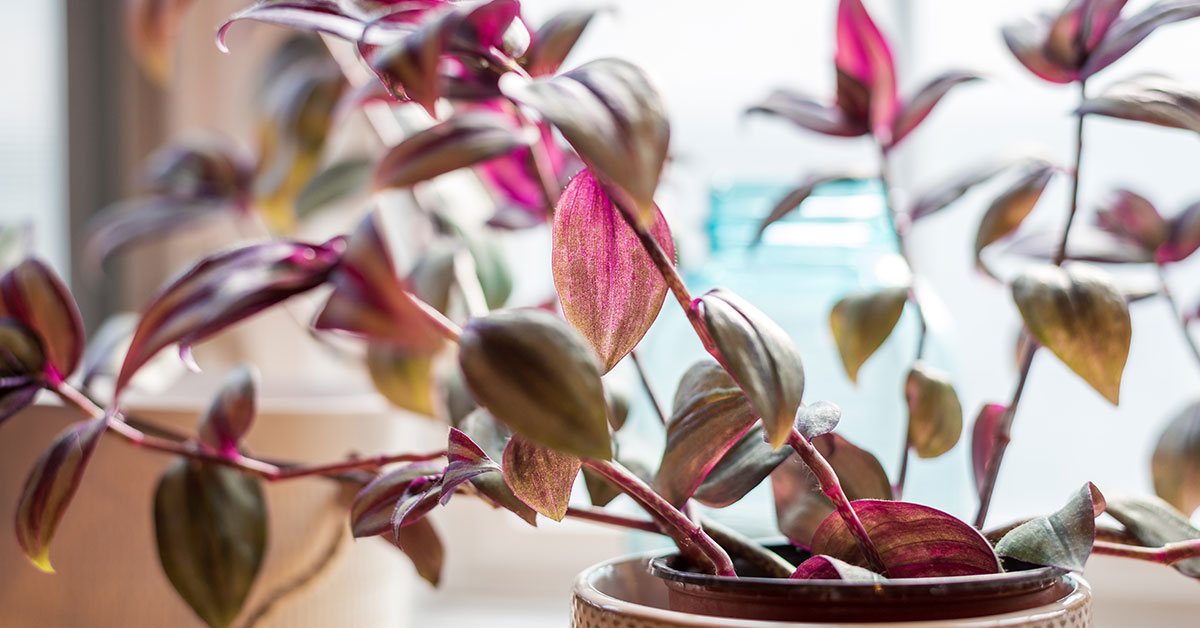
Why Your Wandering Jew Is Dying & How To Fix It

If you’ve noticed your Wandering Jew is dying or showing signs of distress, it’s important to identify the potential causes to effectively address the issue. This article aims to shed light on why your beloved Wandering Jew might be experiencing a decline and provide practical insights to help you revive it.
From improper watering practices and inadequate lighting to pest infestations and nutrient deficiencies, we’ll explore the various factors that could be contributing to your plant’s deteriorating health.
By understanding these potential causes and implementing the appropriate solutions, you’ll be equipped to save your Wandering Jew from further decline and restore it to a thriving state. So let’s dive into the possible reasons why your Wandering Jew is struggling and discover the steps you can take to bring it back to life.
Signs your Wandering Jew is dying
There are several signs that can indicate your Wandering Jew is dying or ill. Here are some common signs to look out for:
- Wilting: If the leaves of your Wandering Jew plant appear limp, droopy, or withered, it could be a sign of underwatering or overwatering. Check the soil moisture level and adjust your watering accordingly.
- Yellowing Leaves: Yellowing foliage may indicate various issues. It can be a result of overwatering, root rot, inadequate light, nutrient deficiencies, or pests. Assess the growing conditions and address the underlying cause.
- Browning Leaves: Browning and crispy leaves can indicate underwatering or exposure to direct sunlight. Ensure your plant is receiving adequate water and protect it from harsh sunlight.
- Leaf Loss: Excessive leaf drop or shedding is a distress signal. It can be triggered by changes in environmental conditions, insufficient light, overwatering, or pests. Identify the cause and take appropriate measures to rectify the issue.
- Stunted Growth: If your Wandering Jew plant’s growth has slowed down significantly or there is no new growth for an extended period, it could be a sign of unfavorable growing conditions, inadequate light, or nutrient deficiencies.
- Pest Infestation: Noticeable presence of pests such as spider mites, mealybugs, or aphids can weaken the plant and cause it to decline. Inspect the leaves and stems regularly, and take prompt action to eliminate pests if detected.
- Root Problems: If you notice a foul odor coming from the soil, root rot, or mushy and discolored roots when you inspect the plant’s root system, it indicates root problems. Overwatering, poor drainage, or fungal infections can contribute to root issues.
If you observe any of these signs, it’s important to assess the care and growing conditions of your plant, as it’s likely your Wandering Jew is dying or ill. Adjust watering, lighting, and environmental factors accordingly. In some cases, providing appropriate care can help revive a struggling plant. However, if the signs persist or the plant continues to deteriorate, it may be difficult to save and it might be necessary to consider replacing it.
Reasons why your Wandering Jew is dying and how to fix it
In this section, we will explore common reasons why your Wandering Jew plant (Tradescantia genus) may be experiencing distress or on the verge of dying. Understanding these issues can help you identify the root causes and take appropriate steps to revive your plant.
Wilting in a Wandering Jew plant (Tradescantia genus) can be caused by various factors, and identifying the underlying issue is crucial in determining the appropriate fix. It’s one of the more common signs your Wandering Jew is dying. Here are some common reasons why a Wandering Jew plant may be wilting and potential solutions:
- Underwatering: If the plant is not receiving enough water, it can lead to wilting. Check the moisture level of the soil by inserting your finger into the top inch of soil. If it feels dry, it’s time to water. Ensure thorough watering, allowing water to reach the root zone. Adjust your watering schedule to keep the soil slightly moist but not waterlogged.
- Overwatering: Conversely, overwatering can also cause wilting. Excessive moisture can lead to root rot, suffocating the roots and preventing them from taking up water properly. Allow the soil to dry out slightly before watering again. Ensure the pot has drainage holes to allow excess water to escape.
- Temperature Extremes: Wandering Jew plants prefer moderate temperatures between 65-80°F (18-27°C). Extreme temperatures, such as excessive heat or cold drafts, can stress the plant and cause wilting. Move the plant to a more suitable location with stable temperatures and protect it from drafts or direct exposure to heaters or air conditioning units.
- Light Intensity: Insufficient or excessive light can lead to wilting. Wandering Jew plants thrive in bright, indirect light. If the plant is placed in low-light conditions, it may not receive enough energy for healthy growth. Move the plant to a location with brighter, filtered light. However, be cautious of too much direct sunlight, which can scorch the leaves. Adjust the light exposure to find the optimal balance.
- Nutrient Deficiencies: Lack of essential nutrients can affect a plant’s overall health and cause wilting. Ensure your Wandering Jew plant receives adequate nutrition. Use a balanced, water-soluble fertilizer specifically formulated for houseplants and follow the instructions for application. Be mindful not to overfertilize, as this can lead to fertilizer burn or other issues.
- Pest Infestation: Certain pests, such as spider mites, mealybugs, or aphids, can weaken the plant and cause wilting. Inspect the plant regularly for signs of pests, including webbing, small insects, or sticky residue on leaves. Treat any infestations promptly using appropriate organic or chemical controls, following the recommended guidelines.
- Root Problems: Root issues, such as root rot or inadequate root development, can impact a plant’s ability to absorb water, resulting in wilting. Check the root system for signs of rot, such as foul odor or mushy roots. If root rot is present, take immediate action by addressing the overwatering issue, improving drainage, and trimming away affected roots.
It’s important to assess the specific cause of wilting in your Wandering Jew plant and take appropriate action accordingly. Adjust watering practices, improve lighting conditions, provide proper nutrition, address pest issues, and ensure a healthy root system. By addressing the underlying problem, you can help revive your wilting Wandering Jew plant and restore its vigor.
Yellowing and browning leaves
Yellowing or browning leaves in a Wandering Jew plant (Tradescantia genus) can indicate various issues. It’s another very common indication that your Wandering Jew is dying. Understanding the potential causes and taking appropriate action can help address the problem. Here are common reasons for yellowing or browning leaves and potential fixes:
- Watering Issues: Both overwatering and underwatering can lead to leaf discoloration. Overwatering can cause root rot, suffocating the roots and inhibiting their ability to absorb nutrients. Underwatering can result in dryness and nutrient deficiencies. Adjust your watering routine to maintain slightly moist soil, allowing the top inch to dry out before watering again.
- Light Intensity: Insufficient or excessive light can cause yellowing or browning leaves. If the plant receives inadequate light, it may struggle to produce energy and essential pigments. Move the plant to a location with bright, indirect light. However, excessive exposure to direct sunlight can scorch the leaves. Adjust the light exposure to find the right balance.
- Temperature Extremes: Extreme temperatures, such as cold drafts or heat stress, can cause leaf damage. Wandering Jew plants prefer moderate temperatures between 65-80°F (18-27°C). Protect the plant from cold drafts and ensure it is not placed near heaters or air conditioning units that generate excessive heat.
- Nutrient Deficiencies: Lack of essential nutrients can manifest as yellowing leaves. Ensure your Wandering Jew plant receives balanced nutrition. Use a water-soluble fertilizer formulated for houseplants, following the recommended application instructions. This can help address any nutrient deficiencies.
- Pest Infestation: Pests like spider mites, mealybugs, or aphids can cause yellowing or browning leaves. Inspect the plant regularly for signs of pests, such as tiny insects, webbing, or sticky residue on leaves. Treat any infestations promptly using appropriate organic or chemical controls.
- Environmental Stress: Environmental stressors, such as excessive heat, low humidity, or sudden changes in conditions, can impact leaf health. Ensure a stable environment with appropriate temperature, humidity, and airflow to minimize stress on the plant.
- Aging or Natural Leaf Shedding: It’s natural for older leaves to turn yellow or brown and eventually fall off. Monitor the plant to differentiate between natural leaf shedding and abnormal leaf discoloration. Prune away any excessively yellow or brown leaves to promote new growth.
When addressing leaf discoloration, it’s essential to identify the specific cause and tailor the solution accordingly. Adjust watering practices, improve lighting conditions, provide proper nutrition, address pest issues, and create a favorable environment. With consistent care and attention, your Wandering Jew plant can recover and display healthy, vibrant foliage once again.
Leaf loss in a Wandering Jew plant can occur due to various factors. Understanding the potential causes and taking appropriate action can help address the issue. Here are common reasons for leaf loss and potential fixes:
- Natural Shedding: It’s normal for Wandering Jew plants to shed older leaves as part of their natural growth cycle. As new growth emerges, older leaves may yellow, wither, and drop off. This process is generally not a cause for concern unless it is accompanied by other signs of distress.
- Watering Issues: Overwatering or underwatering can contribute to leaf loss. Overwatering can lead to root rot, causing the plant to shed leaves as it struggles to take up water and nutrients. Underwatering can result in dryness and leaf damage. Ensure proper watering by allowing the top inch of soil to dry out before watering again. Maintain a consistent watering schedule without overwatering.
- Lighting Conditions: Insufficient or excessive light can cause leaf loss. Inadequate light can lead to weak growth and leaf drop. Ensure your plant receives bright, indirect light for several hours a day. Excessive direct sunlight can scorch the leaves, leading to leaf loss. Adjust the lighting conditions to find the optimal balance.
- Temperature Extremes: Extreme temperatures, such as cold drafts or heat stress, can cause leaf loss. Wandering Jew plants prefer moderate temperatures between 65-80°F (18-27°C). Protect the plant from cold drafts and ensure it is not placed near heaters or air conditioning units that generate excessive heat.
- Nutrient Deficiencies: Inadequate nutrition can contribute to leaf loss. Ensure your Wandering Jew plant receives balanced nutrition by using a water-soluble fertilizer formulated for houseplants. Follow the recommended application instructions to provide essential nutrients.
- Pest Infestation: Pests such as spider mites, mealybugs, or aphids can weaken the plant and cause leaf loss. Inspect the plant regularly for signs of pests, such as tiny insects, webbing, or sticky residue on leaves. Treat any infestations promptly using appropriate organic or chemical controls.
- Environmental Stress: Environmental stressors, including low humidity, sudden changes in conditions, or air circulation issues, can lead to leaf loss. Maintain stable environmental conditions with adequate humidity and airflow. Avoid exposing the plant to drastic temperature fluctuations or drafts.
By identifying the specific cause of leaf loss in your Wandering Jew plant, you can take the necessary steps to address the issue. Adjust watering practices, improve lighting conditions, provide proper nutrition, address pest issues, and create a favorable environment. With consistent care and attention, you can help minimize leaf loss and promote healthy growth in your Wandering Jew plant.
Stunted growth
Stunted growth in a Wandering Jew plant (Tradescantia genus) can be attributed to various factors. Understanding these causes and taking appropriate action can help address the issue. Here are common reasons for stunted growth and potential fixes:
- Inadequate Lighting: Insufficient light can result in stunted growth. Wandering Jew plants require bright, indirect light for several hours a day to thrive. If the plant is placed in a low-light area, consider moving it to a spot with brighter, filtered sunlight. Supplemental artificial lighting can also be used to provide the necessary light intensity.
- Temperature Extremes: Extreme temperatures, such as cold drafts or heat stress, can negatively impact growth. Wandering Jew plants prefer moderate temperatures between 65-80°F (18-27°C). Protect the plant from cold drafts and ensure it is not exposed to direct airflow from heaters or air conditioning units that can cause temperature fluctuations. Maintain stable and comfortable temperature conditions for optimal growth.
- Nutrient Deficiencies: Insufficient nutrients can lead to stunted growth. Ensure your Wandering Jew plant is receiving proper nutrition by using a balanced, water-soluble fertilizer formulated for houseplants. Follow the recommended application instructions to provide essential nutrients. Additionally, consider repotting the plant if it has been in the same soil for an extended period, as fresh soil can provide additional nutrients.
- Root Bound: When the plant’s roots become overcrowded in a small pot, it can restrict growth. Check the roots by gently removing the plant from its pot. If the roots are densely circling around the root ball, it may be time to repot the plant into a slightly larger container with fresh soil. This allows the roots to spread and encourages new growth.
- Watering Issues: Inconsistent or improper watering practices can hinder growth. Overwatering can lead to root rot, while underwatering can cause dehydration and stunted growth. Maintain a regular watering schedule, allowing the top inch of soil to dry out before watering again. Ensure proper drainage and avoid waterlogging the soil.
- Pests or Diseases: Infestations by pests or diseases can weaken the plant, resulting in stunted growth. Inspect the plant regularly for signs of pests, such as spider mites, mealybugs, or aphids. Treat any infestations promptly using appropriate organic or chemical controls.
- Environmental Factors: Environmental conditions, such as low humidity or poor air circulation, can affect growth. Provide adequate humidity by misting the plant’s leaves or using a humidifier nearby. Ensure proper air circulation to prevent stagnant conditions that can hinder growth.
By addressing these potential causes, you can promote healthier growth in your Wandering Jew plant. Evaluate the lighting, temperature, watering, nutrient levels, and overall plant health. Make adjustments as necessary to create optimal conditions for the plant’s growth. With time and proper care, you can help your Wandering Jew plant overcome stunted growth and thrive.
Wandering Jew plants (Tradescantia genus) can be susceptible to root rot, a fungal disease that affects the roots and can lead to plant decline or death. If root rot is why your Wandering Jew is dying, you’ll need to act fast.
Root rot occurs when the roots are consistently exposed to excess moisture, causing them to become waterlogged and leading to the growth of harmful fungi. Here’s an explanation of why a Wandering Jew plant may develop root rot, along with steps to fix it:
Overwatering: The most common cause of root rot is overwatering. When the plant is consistently watered excessively or sits in waterlogged soil, the roots become deprived of oxygen. This creates a favorable environment for fungal growth, leading to root rot.To fix root rot:
- Stop overwatering: Allow the soil to dry out between waterings. Only water the plant when the top inch of soil feels dry to the touch.
- Improve drainage: Ensure the pot has drainage holes to allow excess water to escape. If the plant is in a container without drainage, consider repotting it into a container with proper drainage.
Poor Drainage: Inadequate drainage exacerbates the risk of root rot. If the soil doesn’t drain well, excess water can accumulate around the roots, promoting fungal growth. To fix poor drainage:
- Adjust the soil: Use a well-draining potting mix specifically designed for houseplants. Adding perlite or coarse sand to the mix can improve drainage.
- Repot the plant: If the current soil is heavy and retains too much moisture, consider repotting the plant into fresh, well-draining soil.
Compact or Damaged Roots: Root damage or compacted roots can make the plant more susceptible to root rot. This can occur if the plant is root-bound or if the roots have been disturbed during repotting or other handling. To fix compact or damaged roots:
- Repot the plant: If the roots are tightly packed or damaged, gently loosen them during repotting to encourage healthy growth and prevent further complications.
- Trim affected roots: If you notice any blackened, mushy, or foul-smelling roots, carefully trim them with sterilized pruning shears.
Proper Watering Technique: It’s important to water the plant correctly to minimize the risk of root rot.To establish proper watering technique:
- Water at the base: Directly water the soil around the base of the plant, avoiding the leaves and stems. This helps prevent excess moisture on the foliage and minimizes the risk of fungal infections.
- Monitor moisture levels: Use your finger to check the moisture level of the soil. Water only when the top inch of soil feels dry.
By addressing the root causes of root rot and implementing appropriate corrective measures, such as adjusting watering practices, improving drainage, and ensuring healthy root conditions, you can help save your Wandering Jew plant from root rot and promote its recovery.
Related Posts

10 Plants That Are Toxic To Cats Pet Owners Should Avoid

14 Everyday Activities That Harm & Kill Wildlife

10 Ways To Get Rid Of Mosquitoes For A Mosquito-Free Summer

10 Houseplants Perfect For Low Light

Avoid Growing These Plants That Are Toxic For Dogs

10 Flowers That Bloom in April

8 Easiest Fruits To Grow For Beginner Gardeners

10 Strawberry Growing Mistakes To Avoid

10 Easy Herbs For Beginner Gardeners

9 Flowers That Symbolize Rebirth

These Common Bird Feeder Mistakes Could Be Killing Local Wild Birds

What You Can Do To Save The Endangered Rusty Patched Bumble Bee
Join thousands of gardeners who receive our weekly gardening tips 🌻.

Grow your knowledge, grow your garden
Why Is My Wandering Jew Dying [And What To Do]
- By Connie Adan
- In Gardening Guides , General Tips , Plants , Plants By Zone
- Updated October 26, 2022
It is fun to grow Wandering Jew because there are a lot of plant varieties. They have unique, vibrant colors, perfect for hanging baskets in a garden or patio.
Are you wondering why your plant seems gloomy and dying? Read through this post to know the causes of why your Wandering Jew is dying and learn more about how to grow one.
Wandering Jews may die due to the following reasons:
- Lack of water
- Too much water
- Lousy drainage
- Infestation
These things are sometimes overlooked because this plant is easy to grow, but Wandering Jew still needs to maintain enough moisture, humidity, space, and well-drained soil to stay healthy and strong.
Would you like to learn more about how to take care of your plant? Are you looking for alternatives to keep your Wandering Jew healthy and vigor? You have come to the right post, as we have these answers. Without further ado, let's dive right in!
![wandering jew plant dead on top Wandering jew in the pot, Why Is My Wandering Jew Dying [And What To Do]](https://gardentabs.com/wp-content/uploads/2022/08/Why-Is-My-Wandering-Jew-Dying-And-What-To-Do.png)
Why Is My Wandering Jew Plant Dying?
Does your plant look drooping? Drooping can be a sign for different reasons, and it could be a sign that the plant is dying. Here are the reasons why your plant seems sad and dying :
Water Issues
Wandering Due does not receive enough water or is overwatered. Remember that Wandering Jew needs more water in summer than in winter. Consider the climate and weather conditions before watering the plant.
Not Enough Humidity
This plant is tropical and needs humidity to avoid drooping and dying. You can put pebbles on the bottom tray and fill it with water, just enough the level of the stones, then place your plant's pot on them.
Another way is to get a humidifier if your plant is indoors.
Bad Drainage
If the pot has no drainage holes, your plant will drown. It needs water, yes, but too much would kill it. Just water enough to make the soil moist, and use a well-drained pot.
There may be fungi or pests in the soil that affect the rooting system. Check the roots and see if there are signs of rotten roots.
If there is, carefully remove the plant from the soil and remove the discolored and root rot using sharp scissors. Re-pot and use new soil, then wait for the plant to recover.
Why Did My Wandering Jew Turn Red?

Your plant turns red because the variegated leaves have genetic oddities, which are natural for Wandering Jews.
Anthocyanin pigments can cause the leaves to turn shades of pink, red, or purple.
Not all kinds of plants produce this, and it only happens due to several conditions, including changing colors during the fall seasons.
Why Did My Wandering Jews Leaves Turn Brown?
Plants' leaves can lose their colors and have brown spots because of improper watering, and the cause is a lack of humidity. Wandering Jews struggle to thrive in places with dry air.
The leaves will turn brown if the plant continues to receive enough humid air.
During winter, indoor plants are affected by less ventilation and a central heater because these decrease the humidity level in the room.
Here's how to solve this problem:
- Spray water mist on leaves using a spray bottle.
- Put pebbles or small stones on a tray and fill it with water. Place the plant on top.
- Wash your plants using lukewarm water.
- Move the plant to areas with enough humidity.
- You can use a humidifier or home greenhouse kit that traps moisture and warmth.

Click here for a Home Greenhouse Kit on Amazon.
When Should I Water Wandering Jew?
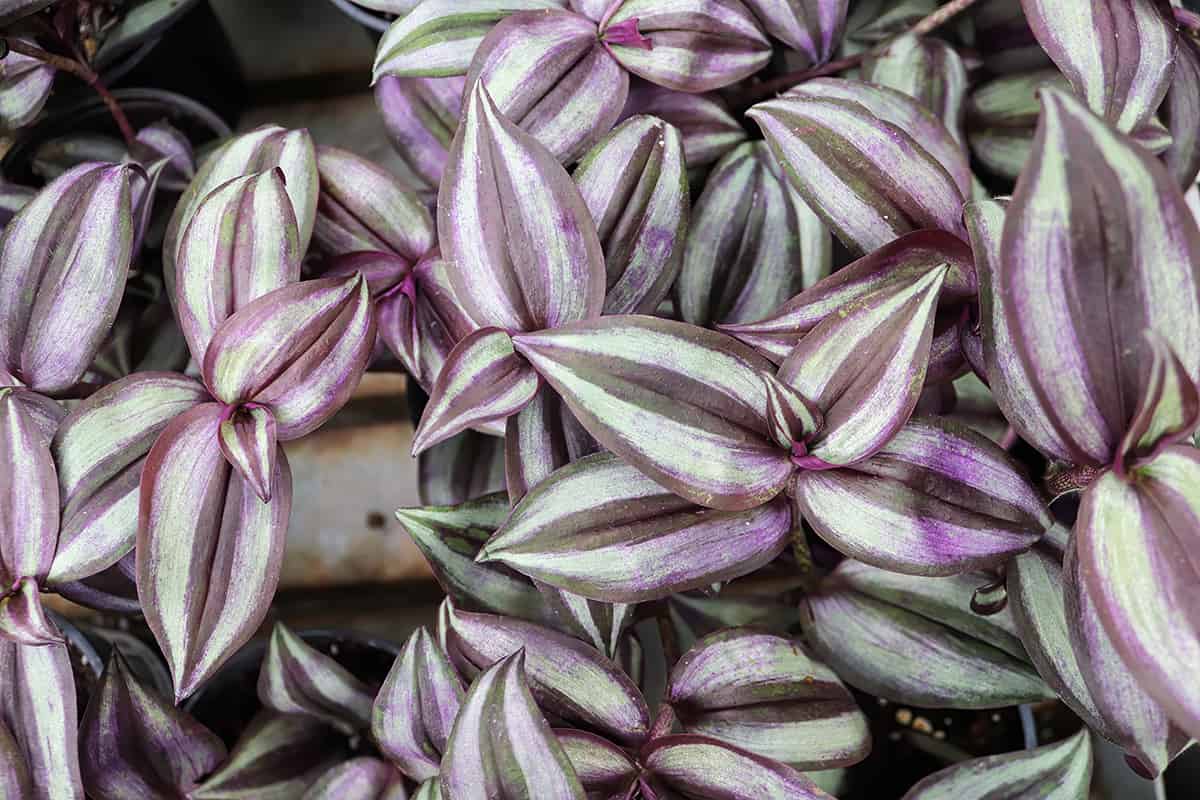
Water Wandering Jew plant once one inch of the top part of the potting soil becomes dry.
Ensure that the pot is well-drained. Also, spraying the plant during the dry season will help to keep the moisture and revitalize it.
What Kind Of Soil Does Wandering Jew Like?
Wandering Jew requires 50% peat moss and a well-draining pot soil mixture. Plant it in a pot with a drainage hole to avoid overwatering. This plant is best placed in a spot at 60 Degrees Fahrenheit temperature.
Can I Root Wandering Jew In Water Propagation?
Tradescantia Zebrina or Wandering Jew will root whether placed in soil or water. Here is the procedure on how to root it in water:
- Cut 6 inches from one of the stems using scissors just right above the leaf node where the new roots will grow.
- Clasp leaves a few inches from the bottom of the cutting, then place them in a clear glass container with water for you to see and monitor the new roots. Ensure that the leaves are out of the water.
- Keep the glass container away from direct sunlight and replace the water every other day.
- Once the roots grow, you can already transfer the plant to potting soil.
How To Grow A Wandering Jew
It is easy to take care of this plant, but it will not hurt to add extra care to make your plant healthy and vigor. Plants still need support and care from their owners.
These are the tips for growing Wandering Jew:
- Wandering Jews are delicate to live in zones 9 to 12. That is why gardeners grow it as an indoor plant. This plant likes bright but indirect sunlight. Too much sunlight will scorch the leaves, and lack of sun will make the leaves color fades. It is best to place the plant facing an area without direct sun during the afternoon.
- This plant requires well-drained potting soil and doesn't like soggy soil. Mix pumice or perlite to help the drainage. Pumice and perlite also help the plant's vigor and growth.
- Water Wandering Jew once the top of the soil looks dry. Water the plant enough that it comes out of the drainage holes. Do not let the ground become soggy due to excessive moisture, and ensure the drainage holes are not clogged. Too much water will result to root rot.
- You can also use fertilizer to add nutrients to your plants. There are available formulated fertilizers for houseplants. Follow the instructions of the manufacturer in using fertilizers.
How Do You Save A Dying Wandering Jew Plant?
It is dying if your Wandering Jew is showing brown spots or drooping. There is still a chance to revive the plant, considering it is not yet dead. Here is how to restore a dying Wandering Jew:
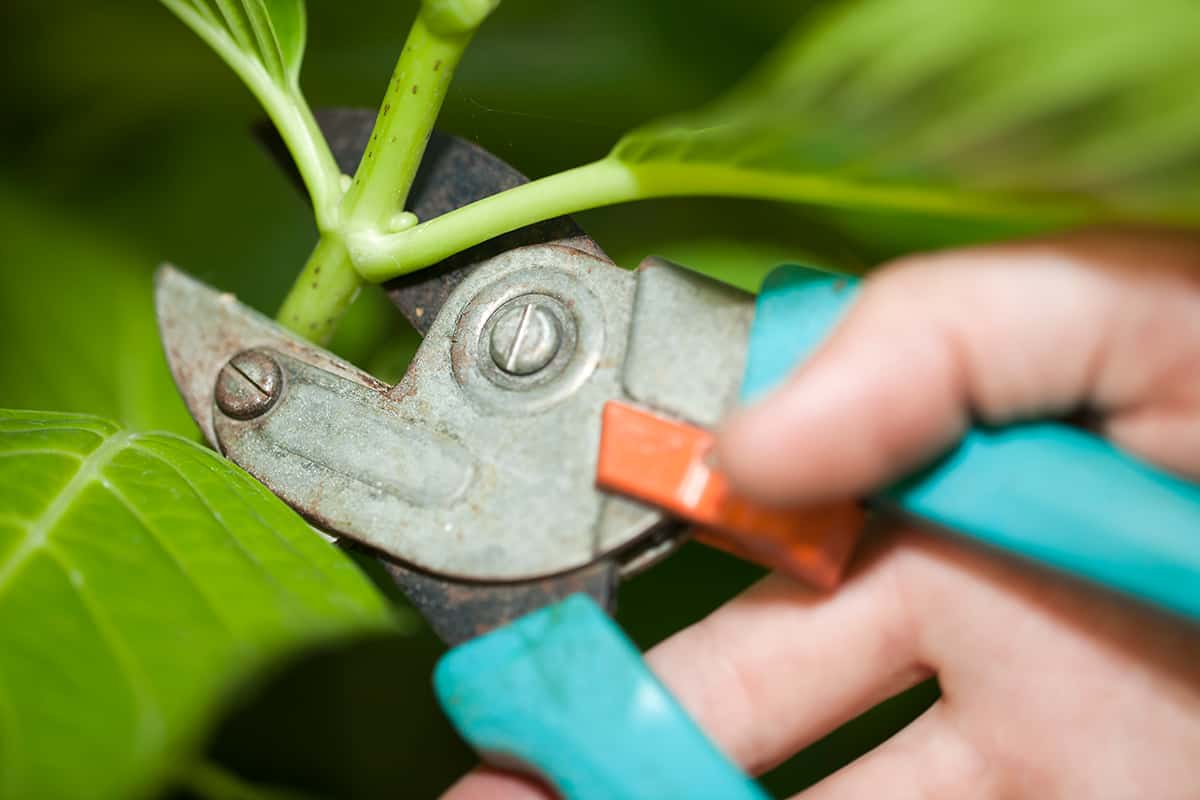
There could be a possibility that the pot is too small or the plant needs fresh soil. Ensure that the pot has enough drainage holes.
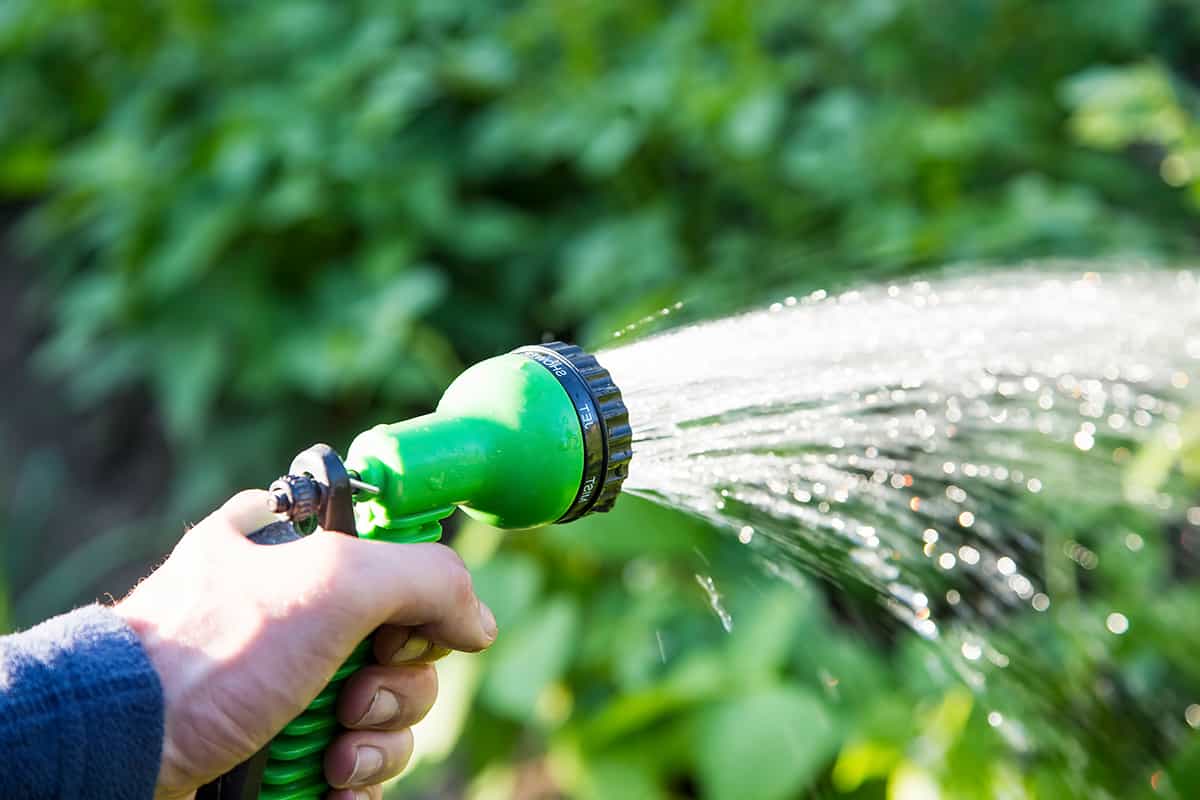
Water the Wandering Jew consistently and lightly for a few weeks until changes and growth appear.
Stem Cuttings
If needed, you can revive the plant by cutting the stems. Prune and place the stems in a glass of water until new roots appear. Place the glass in the shade while waiting for the roots to develop.
Once the roots have grown, plant them in potting soil.
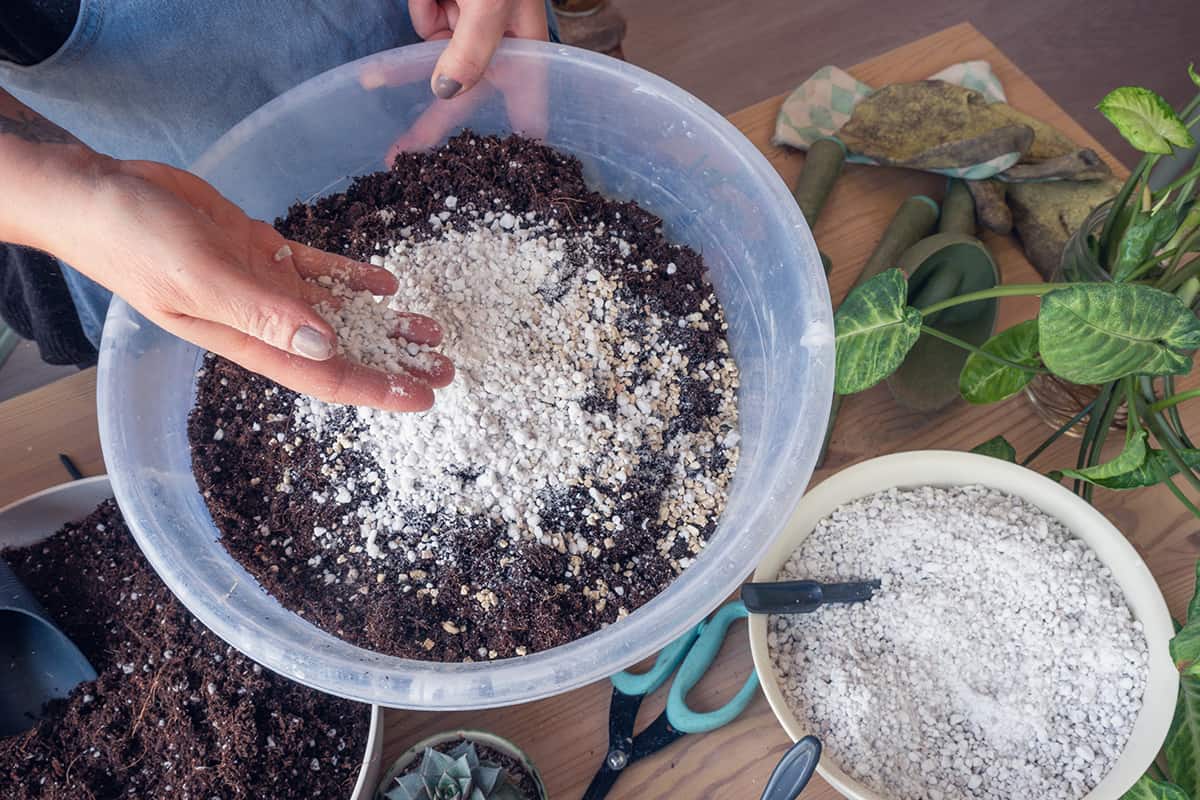
If you repot the plant, add transplanting fertilizer after a few weeks to strengthen the roots and reduce transplanting shock.
What Are The Best Fertilizers For Houseplants
Wandering Jew is commonly grown as a houseplant which requires fertilizers specially made for indoor plants. Here are the best fertilizers to use:
Liquid Indoor Plant Food
This product promotes colorful blooms, strong roots, and green leaf development.

Click here to check Indoor Plant food on Amazon.
Miracle-Gro Water Soluble Plant Food
This fertilizer is easy to feed. It contains nutrients that help plants grow twice as ravenous plants.

Click here to check Plant food on Amazon.
Purified Liquid Fertilizer For Indoor Plants
This liquid fertilizer helps plants' growth and supports the photosynthesis process. It contains essential nutrients to maintain healthy soil.

Click here to check Liquid Fertilizer on Amazon.
To Finish Up
Taking care of Wandering Jew is easy but tricky. It needs a little sun but not too much to avoid burning the leaves. It can also propagate in water but can't get overwatered in soil. Remembering these small things will help plant lovers to maintain the plant's health.
Made it this far? Check out these helpful related posts!
Where To Buy Pumice For Your Gardening Needs
Vertical Gardening Pros And Cons
Leave a Reply Cancel Reply
Your email address will not be published. Required fields are marked *
Name *
Email *
Add Comment *
Post Comment

- Indoor Gardening
- Houseplants
- Hydroponics
- Houseplants Made Easy Book

How To Care For A Wandering Jew Plant (Your Complete Guide)
When it comes to houseplants able to brighten up indoor spaces, it doesn’t get much more colorful than the variegated foliage of a Wandering Jew plant ( Tradescantia zebrina ). With their hardy nature and ease of care, they are a perfect choice for those feeling they kill everything they bring indoors. We’ve listed a quick summary of their care below.
How To Care For A Wandering Jew Plant: Grow your Wandering Jew in well-drained soil, kept moist but not soggy through regular watering. Create humidity, keep indoor temperatures between 50°F (10°C) to 85°F (29°C) and fertilize monthly.
Continue reading because we’ve taken all the guesswork out of caring for your Wandering Jew and keeping it healthy and happy for years to come.
How To Care For A Wandering Jew Plant
Wandering Jew plants belong in the Commelinaceae family, which includes around 652 different species. The family is made up of herbs, climbers and several epiphytes, with some used as outdoor and indoor ornamentals like Wandering Jew.
There are three different plants commonly known as Wandering Jews; Tradescantia fluminensis , Tradescantia pallida , and Tradescantia zebrina. Of the three, Tradescantia zebrina is the most common one grown and has the most eye-catching and colorful foliage. All three have the same requirements for care and good growth.
Native to Mexico and Guatemala, Wandering Jew is classified as a tender evergreen perennial that performs well planted outdoors in frost-free regions. Those living in cooler environments can easily grow it as an indoor plant planted either in containers or in hanging baskets. Outdoors it’s typically used as a quick-growing groundcover.
Although a common name shared with several very different plants, Wandering Jew is often called Inch Plant , due to the leaf margins being spaced about an inch apart. You may also find Wandering Jew listed as Zebrina Pendula , but is synonymous with Tradescantia zebrina and is the same plant.

When it comes to Wandering Jew plants, it’s all about the attention-grabbing foliage. The succulent stems give way to leaves that are a deep purple on their undersides with the upper portion striped in silvery-gray and greenish-blue. The oval leaves grow to about 2.5 inches long and the stems grow about 2 feet long. It makes a beautiful plant used in hanging baskets, with the long stems cascading over the side.
Even grown indoors, Wandering Jews have a fast rate of growth and before you know it, the plants will be spilling over your container’s or hanging basket’s sides. Whereas some indoor plants seem to take forever to fill out, this isn’t a problem with properly cared for Wandering Jew plants.
There are several other cultivars (varieties) of Wandering Jew, which include:
- ‘Purpusii’ has unstriped, hairy foliage that is either solid red or reddish-green.
- ‘Quadricolor’ produces metallic-green foliage striped in red, white and green.
Wandering Jew plants are the ideal candidates for beginner houseplant gardeners due to their hardiness and robust growth. Below we’ve outlined all the basics of their proper care, as well as identifying and preventing any potential problems so you can enjoy your Wandering Jew for years to come. The best indoor plants are those that are happy and healthy.

Soil Conditions For Wandering Jew Plants
Wandering Jew plants tolerate growing in a wide range of soils provided they drain well. Although they do tolerate and prefer moist conditions, the soil must drain properly to prevent root and stem rot from occurring. Therefore, it is necessary to use a lighter weight soil mixture in your pots rather than heavier soils that don’t provide proper drainage.
Straight potting soils are usually too heavy, retain too much moisture and have a tendency to leave the soil soggy. You can use a heavier potting soil in your soil mixture, just be sure to incorporate a lighter soil mix to provide the Wandering Jew the drainage required for healthy growth.
Commercial potting mixes work well and many have a slow-release fertilizer mixed in, which cuts down on the need for frequent feedings. The slow-release blends usually continue to fertilize the Wandering Jew for about three months.
You can also make your own soil by mixing several ingredients together such as:
- Using equal parts of compost and a potting mix.
- Mixing equal portions of compost, peat and potting soil or a potting mix.
- Using equal portions of a course sand, compost and potting soil or a potting mix.
Whatever soil you choose to use, just make sure it drains well and contains a bit of fertility for the best performance of your Wandering Jew plants.
Preferred Light Conditions
Although Wandering Jew plants tolerate lower light conditions than many houseplants, to help retain those striking colors the plant is known for, place the container in a location indoors receiving filtered sunlight. If your plant starts losing some of the color in the foliage, move it to a location that receives a bit more light.
In addition, if the lower portion of the stems start suffering leaf drop, the Wandering Jew isn’t get enough light and needs to be relocated to a brighter area inside the home.
Once the warm weather of spring arrives and if you’d like to give your Wandering Jew a bit of a break from its indoor location, place it in an outdoor spot that receives partial sun to partial shade. Moving it to an outdoor location with too much sun may leave the foliage sunburned.
Indoor Temperature Requirements
In the Wandering Jew’s native environment, temperatures are consistently warm without the threat of frosts or freezes. Generally, if the indoor temperatures inside your home are comfortable for you, they will also be comfortable for your Wandering Jew plant.
Indoor temperatures between 50°F (10°C) to 85°F (29°C) are a good range for your Wandering Jew plants. Plants grown in this temperature range produce the healthiest growth.
If you gave your plants a break from their indoor location, just make sure to bring them back indoors before the cold weather of winter strikes.
Water Requirements
Wandering Jews prefer soils that are regularly kept moist, not soggy, compared to many indoor houseplants. However, this doesn’t mean the soil should be kept so wet they never begin to dry out. Keeping the soil too wet for too long promotes rot to set in and you may end up killing your Wandering Jew plants. Your Wandering Jew is more likely to forgive you if you forget to water over watering too much and too often.
A good rule to follow is if the soil starts to feel like it’s about to become very dry, apply water. It’s easy to know exactly when to water by:
- Sticking your finger into the soil and if the top inch is starting to feel dry, water until it runs from the container’s bottom drain holes.
During the warm growing season of spring through summer, you can probably expect to water once each week. However, during winter when the Wandering Jew goes into dormancy (its growth slows), you will probably only need to water about every other week.

Humidity Requirements
Compared to many tropical plants grown indoors, Wandering Jew plants aren’t quite as fussy about humid conditions , but still need some humidity for the best growth and performance. Don’t let the thought of creating a humid environment stress you out because replicating humidity for your indoor plants is relatively easy and basic.
- Fill a spray bottle with room temperature water and mist the Wandering Jew several times each week.
- If you’re growing the Wandering Jew in a container and not in a hanging basket, you can set the pot on a tray of pebbles. As you water, the water seeps from the bottom drain holes onto the tray of pebbles and as it evaporates, it creates a humid environment around the plant.
- If your bathroom gets the appropriate amount of light for the Wandering Jew, you can allow it to grow there. Due to the regular use of water in a bathroom, moisture is created, creating the humidity the Wandering Jew requires.
Fertilizer Needs
Unless the soil mixture contains a slow-release fertilizer blend, which feeds the Wandering Jew for about three months, fertilizing monthly is sufficient for proper growth. You have several choices when it comes to fertilizer you can use for your Wandering Jew plant.
- Use a houseplant fertilizer applied at half-strength, applied when you do your regular watering.
- Use an all-purpose, water-soluble blend for outdoor and indoor plants, applied at half-strength and used during your regular watering schedule.
- If your soil mixture didn’t contain a slow-release fertilizer or it’s been about three months, if one was contained in the soil, you can reapply slow-release fertilizer granules sprinkled over the top of the soil. Follow the package directions on amounts.
When it comes to the appropriate time of year to fertilize the Wandering Jew, only fertilize while it’s actively growing, which is spring throughout summer. In winter, the plant goes through a dormant stage and all growth slows, so there is no need to apply fertilizer. Wait until spring arrives before you resume fertilizing the plant.
The one thing you will need to pay attention to when it comes to fertilizing is the buildup of salts in the soil, which can result in foliage burns. Wandering Jew plants have a low tolerance to salty soils. Preventing any salt buildup is relatively simple:
- If the plant isn’t too big, you can take the entire pot to your sink or bathtub and allow water to run slowly through the soil for about five minutes, flushing out any salts.
- If the plant is too big for indoor flushing, take it outside and allow water from the hose to run slowly through the soil for about five minutes. Allow the water to drain and then bring the plant back indoors.
Pruning Requirements
The pruning needs of Wandering Jew plants are low. If you want to control the size of the plant and promote bushier growth, you can pinch off the tips of the stems. To keep the plant always looking its best, you can trim off any broken, dead or damaged stems and leaves throughout the year.
When using pruning tools to trim your Wandering Jew always make sure they are clean so you don’t transfer any diseases or pests to your plant. This is as easy as wiping off the blades with alcohol.
Some people experience skin irritations when handling the cuttings due to the sap , so if you are unsure if you are one of these unlucky gardeners, it might be best to wear gardening gloves when pruning or handling Wandering Jew cuttings.
Potting Needs
If you purchased your Wandering Jew already potted in a hanging basket or 1-gallon container, it should thrive as is for a year or more before it requires repotting. However, if you received rooted cuttings in smaller containers like 4- to 6-inch pots, you most likely need to repot them into something a bit larger so they can grow properly.
This also cuts down on the need for repotting in a month or two as the Wandering Jew begins to outgrow its present pot.
When it comes to the pot’s material, any type works quite well for growing this plant from clay to plastic. However, if you grow your Wandering Jew in a pot made of a porous material like terra cotta, the soil is going to dry quicker than if it was growing in a plastic pot. This means you will need to water more frequently.
Once your Wandering Jew starts getting too big for its present container, it’s time to repot it into one that is around 1- to 2-inches larger. Although the plant likes a moist soil, make sure the pot has bottom drainage to prevent the possibility of rot due to conditions that are too wet.
If you like, you can dress the container up by placing the draining one inside a decorative pot without bottom drain holes, but be sure to empty out any additional water once the inner pot thoroughly drains.
I think a decorative outer pot can add so much to the beauty of your houseplants, so I do this with almost all of my houseplants. Read this article which discusses my favorite decorative planters if you need some inspiration.
Potting and repotting your Wandering Jew is basic:
- Gently remove the Wandering Jew from its present container, being careful not to break the succulent stems.
- Fill the new container that drains about a quarter of the way full with a fertile, well-drained potting mix.
- Check the Wandering Jew’s root system and if it’s growing bunched together and filled the previous pot, gently tease the roots apart with your hands.
- Place the Wandering Jew into the new container and finish filling it with soil.
- Water the Wandering Jew until it runs from the bottom drain holes and place in a bright location indoors.

Propagating New Plants
When it comes to propagating new plants, Wandering Jew is about as easy as it gets. Even if you have never done this before you should have success starting its cuttings. When you trim to control its size, don’t throw those cuttings away but use them to start additional plants.
You have two choices when it comes to rooting your cuttings and both are easy. The first thing you will want to do is obtain your cuttings. Trim off a 4- to 6-inch cutting from the mother plant and you’re ready to start rooting.
Rooting in Soil
- Fill a 6-inch to 1-gallon container that drains with a rich, well-drained potting mix. Water the soil to settle it.
- Make about a 2-inch indentation in the soil where you want to place the Wandering Jew cutting.
- Remove the bottom leaves from the cutting where you will be inserting it into the soil. You can do this by pinching them off with your fingers.
- Place the cutting into the indentation and firm the soil up around it with your fingers.
- Water the soil again and place the cutting in the same light conditions where the mother plant was thriving. Keep the soil moist but not soggy.
Roots should form in about four weeks and after about eight weeks, the Wandering Jew cuttings should form a new root system.
Rooting in Water
- Fill a glass jar or plastic container with about 3-inches of room temperature water.
- Pinch off any leaves from the section of the Wandering Jew cutting that will be submerged in the water.
- Place the cutting in the water and situate the container in a bright indoor location.
- Change the water in the container about every other week, or when cloudy.
You should start seeing new roots form on the cuttings in several weeks. Once the roots are several inches long, you can repot the cuttings into a draining container filled with fertile, well-drained soil.
Disease Problems
Wandering Jew plants grown indoors are hardy and don’t have major diseases that plague them. However, rot is their biggest enemy and caused by soils that are too heavy and do not drain properly, retaining too much water. Overwatering and planting in pots that don’t drain are other causes of rot problems.
When rot rears its ugly head you’ll notice the bottom stems, as well as the foliage turning black, becoming mushy and the entire plant collapses. If this happens and seems to start affecting the entire Wandering Jew plant, you can trim off healthy, unaffected sections of the stems and repot into fresh, clean soil. Since there is no saving the rot-infected sections, you will have no choice but to discard those portions of the plant.
Steps for preventing problems with rot include:
- Using lightweight potting mixes that drain well and aren’t too heavy, which leads to the soil remaining too wet for too long. Some types of potting soils have a tendency to be heavy and need mixing with a potting mix, compost, coarse sand or peat.
- Don’t overwater your Wandering Jew. Although they prefer growing in moist soils, this doesn’t mean constantly soggy soil. Stick your finger into the soil and if the top inch is starting to become dry, apply water until it runs from the bottom of the pot.
- Make sure the pot you are growing your Wandering Jew in has bottom drainage. If you have placed the pot inside a decorative one that doesn’t drain, make sure to empty all the water from it after you have watered.
Pest Problems
Although indoor Wandering Jew plants are not big candidates for problems with pests, several can cause an infestation and problems. As with any pest problem indoors or outside in the garden, quick control is always the best option to keep your plants healthy. It also assures the pests do not migrate to your other plants causing even bigger problems and headaches.
The pests most likely to infest your indoor Wandering Jew plants are:
- Aphids: Aphids come in a host of different colors and are tiny, pear-shaped, sap-sucking insects that usually congregate in large masses along the Wandering Jew’s stems. In large infestations, they can kill the plant or severely weaken it. If the infestation is small, you can wipe the pests off the stems with a moist cloth. However, if the infestation is large, you will probably have to spray the plant with an insecticidal soap or Neem, reapplying as suggested on the package.
- Spider Mites: Spider mites are another sap-sucking pest that if left unchecked can quickly kill or weaken the Wandering Jew. It is easy to tell if you have a spider mite problem as these tiny, white pests spin fine webbing that covers the plant. Spider mites can be the bane of houseplants so quick control is necessary. Use an insecticidal soap or Neem and spray the entire plant, reapplying as suggested on the product label.
- Whiteflies: Whiteflies are other sap-sucking pests that can quickly kill or weaken your Wandering Jew if not quickly controlled. They are another easily identifiable pest, as just touching the plant sends the tiny whiteflies from the plant’s foliage and into the air, hovering right above it. Control the problem with an insecticidal soap or Neem, spraying the entire plant and reapplying as suggested on the product’s label.
- Mealybugs: Sap-sucking mealybugs show up on the Wandering Jew as cottony masses covering the stems and crotches of the foliage. Control the problem by spraying the entire plant with insecticidal soap or Neem, reapplying as suggested on the product’s label. If the infestation is small, you can also wipe them from the stems and leaves with a damp cloth.

Is Wandering Jew A Perennial?
Wandering Jew plants are considered a tender, evergreen perennial. Unlike annuals, and if grown in preferred conditions with proper care, Wandering Jews should live and keep on growing for quite a few years, both indoors and outside.
Why Are My Wandering Jew Plant’s Leaves Losing Their Color?
If your Wandering Jew is growing in light conditions that are too low, the leaves will start to lose their color and become duller. When grown indoors and to keep the bright color on the foliage, make sure the Wandering Jew is growing in a location receiving bright light.
Why Are My Wandering Jew’s Leaves Dropping?
Wandering Jew plants grown in light conditions that are too low will start dropping leaves at the base of their stems. Solve the problem by moving the plant to an indoor location that is brighter. For the best leaf color and growth, they prefer an indoor location receiving bright light.
Why Are My Wandering Jew Cuttings Rotting In Soil?
If your Wandering Jew cuttings are rotting in soil it could be one of two things causing the problem. The soil you are growing the cuttings in may be infected with a fungus that is infecting them with rot.
You can solve the problem by planting the cutting in a sterile, well-drained potting mix. Another cause might be the soil is remaining too soggy and the container doesn’t drain.
Make sure you are using a soil that drains well and doesn’t remain soggy, do not overwater and use a container with bottom drainage. Water the cuttings when to top inch of soil feels dry to the touch.
Can I Root Wandering Jew Cuttings In Water?
Wandering Jew cuttings root quite well in water. Fill a container with several inches of water, remove any leaves that would be submerged and stick the cut end into the water.
Fill the container with fresh, clean water about every other week. You should start seeing root form on the cuttings in several weeks. Once the roots get several inches in length, you can repot the cuttings in a draining container with rich, well-drained soil.
Are Wandering Jew Plants Toxic?
When it comes to humans, Wandering Jew’s sap can cause skin irritation in humans that are allergic to it. Therefore, it’s best to wear gardening gloves when handling or pruning the plant.
The plant is listed as toxic to dogs and cats, due to its tendency to cause skin allergies and dermatitis. To keep your pets and children safe, make sure you situate your indoor Wandering Jew out of the reach of both.
If you’d like some indoor plants that are non-toxic, check out this article which discusses my favorite non-toxic houseplants.
Do Wandering Jew Plants Produce Blooms?
When grown outdoors, Wandering Jews produce small, three-petaled, lavender flowers, but the plant rarely ever blooms grown indoors as a houseplant.
Can I Grow Wandering Jew Outdoors?
Wandering Jew plants grow as perennials planted outdoors in frost-free climates, however, those with cooler weather can plant outdoors and treat it as an annual.
What’s The Growth Rate For Wandering Jew Plants?
When grown in proper conditions with proper care, Wandering Jew plants are considered fast growers.
Many thanks for reading my guide to Wandering Jew care. This really is a great indoor plant for your home. Beautiful and easy to care for, its hard to go wrong.
If you want more help with looking after your indoor plants, check out the rest of my articles , and head over to my resources section , where I have some great recommended resources, books and equipment to help you grow healthier, more beautiful plants.
- PRO Courses Guides New Tech Help Pro Expert Videos About wikiHow Pro Upgrade Sign In
- EDIT Edit this Article
- EXPLORE Tech Help Pro About Us Random Article Quizzes Request a New Article Community Dashboard This Or That Game Popular Categories Arts and Entertainment Artwork Books Movies Computers and Electronics Computers Phone Skills Technology Hacks Health Men's Health Mental Health Women's Health Relationships Dating Love Relationship Issues Hobbies and Crafts Crafts Drawing Games Education & Communication Communication Skills Personal Development Studying Personal Care and Style Fashion Hair Care Personal Hygiene Youth Personal Care School Stuff Dating All Categories Arts and Entertainment Finance and Business Home and Garden Relationship Quizzes Cars & Other Vehicles Food and Entertaining Personal Care and Style Sports and Fitness Computers and Electronics Health Pets and Animals Travel Education & Communication Hobbies and Crafts Philosophy and Religion Work World Family Life Holidays and Traditions Relationships Youth
- Browse Articles
- Learn Something New
- Quizzes Hot
- This Or That Game New
- Train Your Brain
- Explore More
- Support wikiHow
- About wikiHow
- Log in / Sign up
- Home and Garden
- Indoor and Patio Plants
A Complete Guide to Wandering Jew Plant Care
Last Updated: March 27, 2024 Fact Checked
Potting Your Wandering Jew Plant
Watering, fertilizing & pruning your plant, preventing pests & disease, expert q&a, things you'll need.
This article was co-authored by Chai Saechao and by wikiHow staff writer, Dev Murphy, MA . Chai Saechao is the Founder and Owner of Plant Therapy, an indoor-plant store founded in 2018 based in San Francisco, California. As a self-described plant doctor, he believes in the therapeutic power of plants, hoping to keep sharing his love of plants with anyone willing to listen and learn. There are 12 references cited in this article, which can be found at the bottom of the page. This article has been fact-checked, ensuring the accuracy of any cited facts and confirming the authority of its sources. This article has been viewed 636,434 times.
Wandering Jews are beautiful vining plants known for their solid or variegated leaves. These hardy perennials thrive outdoors as groundcover or in pots that allow their tendrils to cascade. They’re relatively easy to care for and incredibly simple to propagate, making them great houseplants! Keep reading for an easy step-by-step guide to Wandering Jew maintenance, from planting to watering to pruning.
Things You Should Know
- Keep your Wandering Jew in a warm spot (around 50–80 °F (10–27 °C)) with lots of bright, indirect sunlight.
- Pot your plant in well-draining potting soil in a container with drainage holes. Keep the soil moist, but not soaking wet.
- Pinch or prune the leaves when the plant gets leggy to promote bushiness, or when any leaves or vines begin to brown or rot.

- Refer to this map to see if your area's temperatures are warm enough to support a Wandering Jew plant, if you're planning on keeping it outside. According to the USDA, the Wandering Jew plant grows best in zones 9-11.
- If you don’t live in USDA hardiness zones 9-11, keep in mind that you may not be able to keep your plant outside during the winter. You may want to grow it inside instead.

- If you use a hanging basket, remember to turn it daily so it gets equal amounts of sunlight.
- If you’re hanging your plant, choose a lightweight or plastic pot so it won’t fall. This also makes it easier to move inside in case of frost.

- Be careful not to use soil that’s too heavy, as Wandering Jews need light soil that drains well. [3] X Research source
- Buy well-draining soil, or, if you already have heavier soil, mix equal parts soil with compost, or equal parts soil, compost, and peat.
- Purchase a Wandering Jew plant at a gardening or home improvement center, or propagate cuttings from established plants . Wandering Jew cuttings grow very quickly.

- If you’re growing your plant indoors, an eastern facing windowsill is a good spot. The plant will receive bright indirect light throughout the day, but watch to make sure the space doesn't become too hot in the afternoon. If so, move the pot a few feet away or use a curtain to filter the light. [5] X Research source
- If the plant primarily remains outside, find a spot that receives indirect sunlight. This could be on a porch that gets morning sun for several hours. Just make sure that it's not sitting in direct sunlight without any shade for most of the day.

- If you've set your pot on a saucer, empty the saucer when it fills.
- The plant's growth will slow in the winter months, meaning it needs to be watered less often. Simply let it remain a little dry for a bit longer before watering.
- Some people find it convenient to put self-watering aqua globes in their plant pots; however, these glass globes require cleaning and regular filling. You'll still need to monitor your plant's moisture if you choose to use them.

- Read the container's instructions carefully before fertilizing, as some liquid fertilizers may actually be powders requiring you to mix in water.

- The best time to prune is during the spring and summer months, when the plant is putting on the most growth. After you've pruned, give the plant a chance to put on new shoots and fill in.
- If you find your plant is too dense and bushy, you'll need to prune around the base so that the plant can get adequate circulation and sunlight.

- Generally, expect to repot your plant annually, but keep an eye out for signs your plant has outgrown its container within that time frame: once you see roots creeping out from under the plant through the drainage holes, or popping up through the soil, it’s time to repot. [10] X Trustworthy Source Penn State Extension Educational organization dedicated to delivering science-based information to people, businesses, and communities Go to source

- Try to use distilled or bottled water when misting the leaves for the best results.
- Brown leaves can also be a sign that your plant is getting too much sunlight. In this case, make sure your plant is not directly in the sun by moving the pot or placing a filter, such as a curtain, in between the plant and the window.

- Root rot can spread very quickly, so act fast when you see signs of it. It can be heartbreaking to cut away a large chunk of your plant, but if you wait too long, you could lose the whole plant. [14] X Research source
- Other signs of root rot include spongy, black roots.

- Though "Wandering Jew" is the most common name for this plant, some people may find this term offensive. Consider using "wandering dude" or "inch plant" instead. Thanks Helpful 2 Not Helpful 2
- "Wandering Jew" doesn't refer to just one plant: it refers to a variety of Tradescantia species, the 3 most common of which include Tradescantia fluminensis ("Quicksilver"), Tradescantia pallida ("Purple Heart"), and Tradescantia zebrina ("Tricolor"). Care is the same for all 3. Thanks Helpful 1 Not Helpful 1

- Be careful when pinching or pruning your plant. Wandering Jew sap can cause skin irritation in some people and allergic reactions in dogs. To be safe, wear gardening gloves when pruning your Wandering Jew. [15] X Research source Thanks Helpful 0 Not Helpful 0
- Wandering Jew cuttings or a plant
- Well-draining potting soil
- Pot or hanging basket
- 10-10-10- fertilizer
- Aqua globes (optional)
- Pruning shears (optional)
- Gardening gloves
You Might Also Like

- ↑ https://houseplantcentral.com/tradescantia-zebrina-care-info/
- ↑ https://www.almanac.com/plant/inch-plants
- ↑ https://getbusygardening.com/wandering-jew-plant-care/
- ↑ https://www.weekand.com/home-garden/article/indirect-light-plants-18005506.php
- ↑ http://www.almanac.com/plant/wandering-jew
- ↑ https://www.weekand.com/home-garden/article/use-101010-fertilizer-garden-18057536.php
- ↑ http://www.gardeningknowhow.com/houseplants/wandering-jew/growing-wandering-jew-plants.htm
- ↑ https://extension.psu.edu/repotting-houseplants
- ↑ http://www.houseplantsforyou.com/wandering-jew/
- ↑ http://www.gardeningknowhow.com/plant-problems/disease/treating-root-rot-gardening-tips-for-housplants.htm
- ↑ https://www.wildinteriors.com/blog/2019/10/30/treating-root-rot-and-soft-rot-in-houseplants
- ↑ https://www.weekand.com/home-garden/article/wandering-jew-plants-dangerous-dogs-18063157.php
About This Article

To take care of your Wandering Jew plant, place it by an east-facing window so that it gets a combination of direct and indirect sunlight. Keep the soil moist, but not soaked, and water the soil instead of the top of the plant to avoid rot. You should also fertilize the Wandering Jew plant every two weeks with a liquid 10-10-10 fertilizer. To keep the plant from getting leggy, trim back the stems in the spring and summer. Did this summary help you? Yes No
- Send fan mail to authors
Reader Success Stories
Nancy Gibson
Jun 6, 2016
Did this article help you?
Sherry Clark
Mar 30, 2016
Sep 23, 2016
Beverly Cox
May 18, 2016

Featured Articles

Trending Articles

Watch Articles

- Terms of Use
- Privacy Policy
- Do Not Sell or Share My Info
- Not Selling Info
Get all the best how-tos!
Sign up for wikiHow's weekly email newsletter
Grow. Play. Every Day!

- House & Home
- Houseplants
Wandering Jew Care: How to Grow a Long and Luscious Inch Plant (Tradescantia Zebrina)
Tradescantia zebrina (commonly known as wandering Jew, spiderwort, or inch plant) is popular for a reason: This beginner-friendly houseplant is low-maintenance and grows quickly. It’s also super easy to propagate more plants so you can fill your home with more of the colorful striped foliage the species is known for.
Written by Linda Ly

When it comes to vigorous, colorful, and easy-to-grow hanging houseplants, there aren’t many that can compare to Tradescantia zebrina (known more commonly as wandering Jew—and I’ll touch on the history of that name below). Whether you’re a houseplant beginner or a veteran, most indoor gardeners have owned one of these potted plants at some point.
Keep reading for everything you need to know about Tradescantia zebrina and growing this stunning houseplant in your own home.
Disclosure: If you shop from my article or make a purchase through one of my links, I may receive commissions on some of the products I recommend.

About inch plants
Natural habitat.
Tradescantia zebrina is a native of Central and South America, from Mexico down to Colombia, as well as the Caribbean. Here, it forms part of the undergrowth in lightly forested and often very moist areas. It can form very dense, wide mats thanks to its creeping growth pattern and ability to throw roots extremely quickly.
Unfortunately, its vigorous growth has also made Tradescantia zebrina an invasive plant in some regions. This includes Hawaii, Brazil, and Australia, where the species easily takes hold in moist, forested areas.
As a 2019 study carried out in the Brazilian Atlantic Rainforest notes, this is problematic due to the species choking out native plants.
Some of the above was caused by careless gardeners allowing bits of the plant to get into the wild, where they quickly root. If you’d like to grow spiderworts like this one in your garden, please make sure to dispose properly of any trimmings left after pruning!
This also applies to zebrina’s popular cousins, like Tradescantia fluminensis, T. pallida, and T. spathacea.
Description
It’s not difficult to see why Tradescantia zebrina gained popularity as a houseplant. Wandering spiderwort plants (not to be confused with spider plants , another beginner-friendly species) are low-maintenance and grow just about anywhere—they even just grow in water !
Easy care and quick growth aside, spiderworts are also just good-looking plants. The pointed, oval leaves on thin, fleshy stems overlap slightly and are characterized by their zebra pattern in purple and silvery green. The leaf undersides are deep purple in color and the tiny, three-petaled flowers are bright pink.
Although this species is naturally a creeping plant, it’s often grown indoors in hanging planters. As long as the plant is provided with enough light, the foliage will be very dense and brightly colored, forming a spectacular waterfall that can reach more than 3 feet in length.
What’s in a name? In the case of common houseplants, sometimes a lot.
Tradescantia zebrina is a classic houseplant (I found mention of it in a 1964 German book about houseplants, but it’s probably been around longer than that!) and among most English speakers, it has long been known as wandering Jew. This is probably a reference to the “wandering” nature of the plant, as it does have a creeping growth pattern.
The legend of the wandering Jew is hundreds of years old and is now commonly considered to be rooted in antisemitism. It describes a Jewish man cursed to walk the planet until the Second Coming because he taunted Jesus on his way to the cross.
Because of this, the plant name has partly fallen out of fashion and has been the source of much debate in the plant world over the past few years.
Some plant enthusiasts have embraced the alternative “wandering dude,” which I personally think is a great option.
“Inch plant” (houseplant enthusiasts don’t agree on whether this refers to the fact that it can grow an inch a day, or that you only need an inch of stem to propagate it), “spiderwort,” or “wandering spiderwort” are also popular alternatives, though these are common names for other Tradescantia varieties, such as Tradescantia Nanouk.
The best way to avoid any confusion is to just stick to the scientific name.

Inch plant varieties
There are three subspecies of inch plant (wandering Jew): Tradescantia zebrina var. zebrina, var. flocculosa, and var. mollipila. Unsurprisingly, after it having been a popular houseplant for so many years, nurseries have also managed to create a whole bunch of cultivars through selective cultivation.
A few of the popular Tradescantia zebrina cultivars you may come across in your local plant store include, but are certainly not limited to:
- Tradescantia zebrina ‘Quadricolor’: Yep, as the name suggests, this one adds an extra color to the mix. The leaves are cream, pink-purple, light green, and dark green.
- Tradescantia zebrina ‘Burgundy’: Characterized by its very dark purple coloration.
- Tradescantia zebrina ‘Silver Plus’: Less purple, more shiny silver.
- Tradescantia zebrina ‘Red Gem’: Less silver, more intense (light) purple.
- Tradescantia zebrina ‘Purple Joy’: Less silver, more dark purple.
- Tradescantia zebrina ‘Tikal’: A rare, naturally occurring variety that collectors pay a pretty penny for.
Do keep in mind that most of these cultivars aren’t patented and the amount of mislabeling and variation within a cultivar are both huge. Just growing your wandering Jew in lower-light conditions can completely change the way it looks, so it’s not surprising that confusion sometimes reigns supreme.
Luckily, care is the same across all cultivars, so your best bet is to just enjoy your plant even if you’re not sure what Tradescantia variety you’re dealing with!
Where to buy wandering Jew plants:
- California Tropicals
- Daylily Nursery
- The Green Escape

Caring for an inch plant
Light and temperature.
It’s important to provide your Tradescantia zebrina with enough light. It’s tempting to use plants to brighten up dark, shaded spots in your home, but that just doesn’t work with this one: It loses its dense growth pattern and beautiful coloration in low light.
To prevent your wandering dude plant from growing sparse and green, place it near a window that gets bright indirect light. Some full sun isn’t a problem either, but do make sure you acclimate it gradually to a higher light location.
Temperature-wise, this species is a lot hardier than many of the tender tropicals we like to grow in our homes (like Anthurium andraeanum and Begonia maculata ).
Wandering dude plants can handle a very wide range of temps, making it perfect for those chillier windowsills that your other plants may not appreciate. Room temperature is ideal, but anything between 50°F to 85°F will keep them happy.
Water and humidity
Your Tradescantia zebrina will appreciate lightly moist soil. You can water a bit more during the summer months, when the plant is actively growing and needs a lot of moisture, and less during winter, when soil tends to take significantly longer to dry.
If you’re not sure whether it’s time to water your wandering Jew plant yet, you can always turn to the age-old trick of sticking a finger in the soil.
- If it still feels damp, wait a little longer, until the first inch or two has dried.
- If it feels bone dry, you’ve waited too long; you may also see limp leaves on your plant at this point. It’ll bounce back, but not always without lasting damage.
- If the soil feels wet, you watered too much and need to keep an eye out for root rot.
As for humidity, given its rather wet natural habitat, wandering Jew does appreciate higher air moisture levels. The great thing is, though, that it doesn’t demand it. As long as you keep its soil lightly moist and the air isn’t extremely dry, your plant should do well.
Soil and planting
Wandering Jew is not fussy about its potting mixture at all. I’ve grown it in pure houseplant potting soil with no additives. If you do want to take things to the next level, you can add some perlite and/or peat moss, although this is really not a must.
Most houseplant enthusiasts like to place their wandering Jew in a hanging planter so they can enjoy the look of the leaves cascading down. This is not a must, though. You can also emphasize the species’ creeping growth habit by filling up a large, shallow planter, growing it in a terrarium, or even keeping it in water on a semi-permanent basis.
Recommended products for wandering Jew plant care:
- FoxFarm Ocean Forest Potting Soil
- Espoma Organic Potting Mix
- Perfect Plants Organic Perlite
Fertilizing
Like most other houseplants, Tradescantia zebrina appreciates a bit of fertilizer during the growing season, which extends from spring to early fall. You can use a normal houseplant fertilizer according to the instructions on the bottle.
Don’t fertilize during the winter months unless your plant is growing well. It doesn’t need extra nutrients if it’s inactive.
Recommended fertilizers for wandering Jew plants:
- Houseplant Resource Center Liquid Fertilizer for Houseplants
- Instant Biologics Instant Plant Food (Fizzing Nutrient Tablets)
- Maxsea All-Purpose Seaweed Plant Food
Pruning
There’s a good chance you’ll have to prune your Tradescantia zebrina regularly, because as I mentioned, this is a very quick grower. It also roots very easily, so any trimmings can be replanted! I’ll describe how to do this in the section on propagation below.
Aside from stem trimming, you can remove any dead leaves, which are bound to pop up from time to time in very dense plants like this species.
Dividing or repotting
Inch plants don’t grow by producing plantlets at their base like many other houseplants (such as spider plants ) do. Instead, inch plants spread by rooting along the stems.
This means that division is not really the way to go; keeping these plants manageable is usually done through pruning. You can shape your plant by pinching off any long, leggy stems to create a fuller appearance and control its spread.
You’ll notice that Tradescantia really doesn’t mind being a bit cramped in its planter. Still, it’s a good idea to provide your plant with some fresh soil every year or two by repotting it.

Propagating an inch plant
If you’ve never propagated a houseplant before, this is truly one of the best species to start with. It’s known for rooting extremely quickly in both water and soil, meaning it’s easy to fill endless planters to keep or give away.
All you need to propagate your Tradescantia zebrina is a pair of clean scissors. Here’s how you do it:
- Snip the ends off existing branches. An inch or two with a few leaves works best.
- Remove the leaves at the bottom so part of the stem is exposed.
- Place the cutting in a glass of water to root or plant it directly in soil. You can put cuttings back in the mother plant’s pot to give her a fuller appearance on top.
- It can take a little longer during the winter months, but the first roots should appear within a week or so. You can give soil cuttings a slight tug to verify they’ve rooted.
- Once the first signs of new foliage appear, you’ll know your propagation attempt has been a success!
- If you propagated in water, you can leave the rooted cuttings in water almost indefinitely, although you can also pot them up in fresh soil.

Common questions about inch plant care
How do i make a wandering jew plant bushy.
By their very nature, wandering Jew plants are not bushy. Their creeping growth habit means they naturally grow leggy over time, especially in containers.
However, you can mimic a fuller appearance by strategically pinching off any long, spindly stems to shape the plant more. These stems can also be replanted near the mother plant.
As the baby plants grow, they’ll help fill in sparse areas and create the illusion of a bushy wandering Jew.
How long do wandering Jew plants live?
Wandering Jew plants have a limited lifespan of just a few years, and as a potted plant, you’ll notice your wandering Jew becoming very leggy after just two to three years.
Unlike other fast-growing plants that benefit from pruning, cutting back a wandering Jew doesn’t work well to renew its growth; it simply controls the spread.
The best way to keep your plant coming back year after year is to propagate new plants from stem cuttings, which—fortunately—is super easy with a high success rate.
Is wandering Jew perennial?
Wandering Jew (Tradescantia zebrina) is a trailing evergreen perennial in its native habitat (USDA hardiness zones 9 through 12). Where it’s not winter hardy, wandering Jew is grown year-round as a houseplant.
Are wandering Jew plants toxic to cats and dogs?
Wandering Jew is not considered outright toxic, but it can cause some skin irritation. If your pet gets into your plant, don’t worry too much, although it can be a good idea to have a look in its mouth to make sure there’s no excessive swelling. Be sure to offer water. To prevent skin rash, it can be a good idea to wear gloves if you need to handle your wandering Jew plant. This especially applies if you have sensitive skin.
https://www.cabi.org/isc/datasheet/110354
Racism in Taxonomy: What’s in a Name?
Chiba de Castro, W. A., Xavier, R. O., Garrido, F. H., Romero, J. H., Peres, C. K., & da Luz, R. C. (2019). Fraying around the edges: negative effects of the invasive Tradescantia zebrina Hort. ex Bosse (Commelinaceae) on tree regeneration in the Atlantic Forest under different competitive and environmental conditions. Journal of Plant Ecology, 12(4), 713-721.
Encke, F. (1964). Pflanzen fur Zimmer und Balkon; Auswahl, Pflege, Vermehrung.
I'm a plant lover, passionate road-tripper, and cookbook author whose expert advice and bestselling books have been featured in Time, Outside, HGTV, and Food & Wine. The National Parks Cookbook is my latest book. Garden Betty is where I write about modern homesteading, farm-to-table cooking, and outdoor adventuring—all that encompass a life well-lived outdoors. After all, the secret to a good life is... Read more »
We bought a full grown Bolivian Jewel mid summer last year. It was in a 14” raised pot and flowing 2 foot over the sides. It was beautiful next to our fountain outside. We live in Minnesota so we had to discard it in the late fall since we had no place to care for it in the house. Since we can’t find another like it we’d like to plant one from scratch but how. We still have the pot and riser but have no idea how to start from that. One plant, a few or just how many to make a bushy over grown plant so it looks like the one we purchased last year. Does this make sense or should we just forget it since it is already the middle of May. The greenhouse that we bought it from last summer doesn’t have any this year, just small ones in 4” pots. Thanks
If you can only grow it as an annual (and won’t be overwintering it indoors), you can plant a few smaller ones together to make them look fuller as they grow.
It seems counterproductive to talk about the problematic origin of the name wandering Jew, recommend multiple alternative names (including scientific), but then continue to call it wandering Jew in the rest of the article. If the name is anti-Semitic just set a good example and use a different name.
Leave a Reply Cancel reply
Your email address will not be published. All fields are required.
Save my name and email in this browser for the next time I comment.
This site uses Akismet to reduce spam. Learn how your comment data is processed .
Recommended Reads
- Garden of eatin’

The No-Dig Garden Method: Make Amazing Soil With Less Work

Solarizing Your Garden: How to Use the Sun to Control Weeds and Pests in the Soil

How to Plant a Three Sisters Garden: The Original Companion Plants

How Much to Plant for a Year’s Worth of Food

What You Should Know Before Buying Land (My Real-Life Tips)

Construction Loans: What I Wish I’d Known As a First-Time Borrower

Dark Room? 9 Actually Low-Light Plants That Don’t Need a Lot of Sun

Getting Rid of Fungus Gnats: 11 Remedies That Really Work

My Favorite Ruby Red Sauerkraut Recipe (and Why It’s So Good For You)

How to Make Nukadoko (Fermented Rice Bran Bed) for Pickling

Easy 4-Ingredient Colorful Homemade Pasta—No Pasta Maker Needed

The Best Homemade Limoncello
Want to level up your garden this year.
Sign up for my free, never-boring newsletter and every week you’ll get the game-changing emails you wish you would’ve had sooner.
- About Linda Ly
- What’s In My Garden
- Lazy Gardening Academy
- Sponsorships
- Site Policies

Back to the top
Disclosure: Garden Betty independently selects products to feature on this site. I may receive a commission when you buy something through one of my links. As an Amazon Associate, I earn from qualifying purchases.
© 2024 Garden Betty. All Rights Reserved.

Wandering Jew Plants Guide: How to Grow & Care for “Tradescantia zebrina”
It might surprise you to learn that “the wandering Jew” isn’t a single plant, its name used to describe a collection of plants in the Tradescantia genus.
Many countries around the world view the wandering Jew as an invasive species. Therefore, you won’t find many of them as regular additions to gardens . However, the vine makes for an excellent indoor plant .
Table of Contents
Quick Facts
Wandering jew plant varieties.
The wandering Jew refers to three different plants in the Tradescantia genus. The three varieties are the zebrina, fluminensis, and the pallida.
Tradescantia Zebrina
The zebrina is the most common of the three species, and it features dark-green foliage that contrasts against the brilliant-white three-petal flowers the plant produces.
As you can imagine, the plant also gets part of its name from the zebra-like foliage. The center of the leaf id has a creamy-white color, and the outer trimming of the leaves has a silver lining.
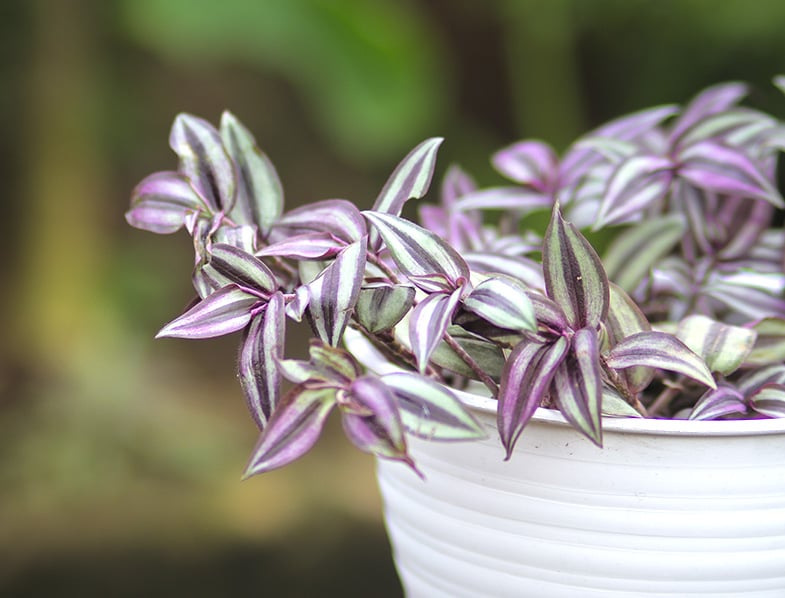
Tradescantia Fluminensis
This wandering Jew species features white flowers, and it’s a trendy indoor plant around the world. The species originates from the southeastern region of Brazil. It’s an evergreen perennial plant that flowers all-year-round and lasts for many years if the owner takes care of it correctly.
The oval-shaped foliage of the Fluminensis is green in color and has a glossy look. The leaves attach to fleshy stems, and the stem nodes quickly put roots down into the soil, allowing for the rapid spread and growth of the plant in ideal growing conditions.
When the plant flowers , it produces a set of flowers with three white petals. The flowers don’t bear any seeds, and they might also emerge in clusters. There are various sub-species of this plant as well, and some types, such as variegate, feature different leaf colors, such as yellow or cream streaks in the leaves.
The plant does best in USDA zones 9 to 12, as it loves the additional humidity in these regions as well. The wandering Jew doesn’t do well in colder climates, so stick to planting in the southern states.
The wandering Jew also prefers full sunlight during the day, and you’ll need to feed it a reasonable amount of water throughout the week. The plant doesn’t enjoy being dry for long periods.
Tradescantia Pallida
This variety originates in Mexico, and it’s the most attractive of the three Tradescantia genus. This wandering Jew produces long, pointy leaves that can reach lengths of 7-inches. The leaf will eventually turn a purple color, but the tips might remain red or green during the color transition.
There are visible segmentations on the stem of this wandering Jew, and it’s for this reason that many countries classify this plant as invasive.
The segments break easily, but they root readily, evolving into two plants with little care. Fortunately, for fans of the plant, it also makes it easy to grow the plants for cuttings as well.
Tradescantia pallida don’t like the cold, and it will die back in colder environments in the Northern states, especially if it grows outside. This wandering Jew produces small flowers that bloom in colors of pink, lavender, and white. The flowers feature three petals, and while they aren’t show-stopping, then do add a beautiful aesthetic to the plant.

- shipped in inproved box to save the plant

Last update on 2024-02-01 / Affiliate links / Images from Amazon Product Advertising API
Natural Air Cleaners
One of the reasons why the wandering Jew is such a popular house plant is its natural air-cleaning properties. The wandering Jew is an excellent “air scrubber,” and it removes bacteria and VOCs from the air inside your home, exchanging it for fresh air that enhances your home.
Some research also shows that the wandering Jew can assist in soil remediation, as well. The plant can remove heavy metals from the soil, helping restore the root health of other plants in the same flowerbed or pot.
Caring for Your Wandering Jew Plant
All varieties of the wandering Jew are easy to care for, provided that you grow them in the right climate and conditions. As long as the plant receives regular watering and pruning, it will thrive, and you’ll also manage to control the growth as well.
If you plant in a sunny spot in your home, then you can expect your tradescantia to last for many seasons. It’s also important to note that the plant might not flower it in its first season. However, by the third year, you should see plenty of flowers that emerge in the summer months.

As mentioned, the wandering Jew prefers sunny planting locations. The plant prefers later afternoon sun to morning sun, but it does well in any sunny area around the home. The more light you give the plant, the more flowers it produces in the flowering season.
If your wandering Jew does not get sufficient sunlight, you’ll notice that the color of the leaves starts to fade. Move the plant to a sunny spot, and it should recover in less than a week.
The wandering Jew enjoys a balanced moisture level in its soil . Don’t let the earth get too dry, as it might cause burning in the tips of the leaves. Likewise, the wandering Jew does not enjoy excessively wet soil either. The plant is susceptible to forming root rot if you “keep its feet wet.”
To check if it’s time to water your wandering Jew, push your finger about 1-inch into the soil. If it feels dry, then give your plant some water.
You must ensure you use a rich, loamy soil that drains well when planting your wandering Jew. When planting in a pot, make sure you add a layer of gravel at the bottom of the pot to enhance drainage. Add perlite to the soil to assist with drainage as well.
You can get away with using a standard potting mix when planting indoors , and other soil enhancements we recommend you add are the following.
- Coarse sand and perlite for drainage
- Humus or peat
- A light dusting of lime
- A few handfuls of rich organic compost
You want the soil to retain water but still allow optimal drainage.
During the growing season, fertilize your wandering Jew plant using a liquid-based fertilizer product. Make sure that you dilute the fertilizer to 50-percent strength.
Strong concentrations can result in burning in the tips of the leaves of the plant. You can also add a granular slow-release fertilizer to the soil once a year at the start of spring.
The wandering Jew grows quickly, and it might take over its pot in one or two seasons, depending on the size of the container. Therefore, you’ll need to pull up the plant and divide it from year-to-year, depending on its growth rate.
If you choose to re-pot your plant, make sure you use a pot that’s at least 50-percent larger than the old one. Line the pot with potting soil and a few handfuls of rich organic compost. Dig around the edges of the existing container to loosen the root ball. After loosening, pull the base of the plant to release it from the pot.
Move the plant to its new pot, and then fill with potting mix to cover the roots — Pat down the soil, and then water lightly.
Wandering Jew plants require regular pruning . The plant grows quickly, and if you don’t prune, then it can overtake the pot fast. Pruning also helps the stem, from getting “leggy,” meaning that the plant starts to look bare at the base. Pruning keeps the plant healthy and growing at an optimal rate.
All; you need to do is prune back any stems and pinch the stem tips. The wandering Jew will then send out two new shoots from the pinched top, helping your plant spread out into a bush-like appearance.
Propagation
The wandering Jew is easy to propagate . This plant grows quickly in a variety of conditions, which is one of the reasons why most countries list it as invasive. You can propagate your cuttings after your pruning session, without much effort.
Remove all of the leaves but the top set after pruning the stem. Place the cutting in another smaller pot with moist potting soil . Leave the container in the sun, and you should find that the cutting roots in a month.
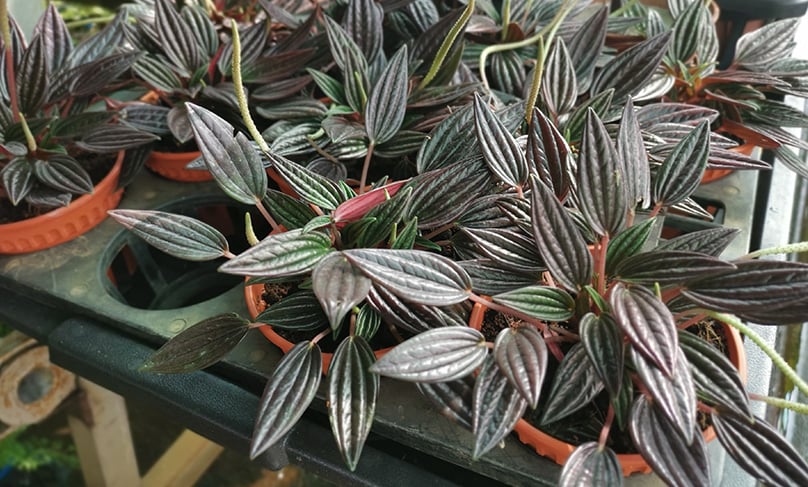
Being an indoor plant , the wandering Jew does not get much attention from pests. However, spider mites can be a problem for your plant if you don’t take care of it and watch for the presence of pests.
Spider mites are tiny spider-like bugs that form a web around the inside of the leaves of the plant. If left unmanaged and untreated, they might start to cause yellow spots in the foliage. The wandering Jew might also fail to flower in the summer months as well.
Over-watering your wandering Jew plant can result in the onset of diseases like root rot. Ensure that you have a well-draining soil mix before planting your wandering Jew. Provided that you do everything you can to ensure your soil drains well, you should never have a problem with root rot in your wandering Jew plant.
Wandering Jew Plants FAQS
What is the best way to grow a wandering jew plant.
The best way to grow a Wandering Jew plant involves placing it in a location that gets plenty of sunlight, preferably late afternoon sun. You should use well-draining, loamy soil to plant it, and ensure a balanced moisture level by watering it regularly but not excessively. The plant also appreciates humidity and occasional fertilizing with a liquid-based fertilizer diluted to 50% strength during the growing season. Pruning should be done regularly to manage its growth.
Is Wandering Jew easy to grow?
A: Yes, Wandering Jew plants are generally easy to grow. They adapt well to various conditions and are fast-growing. They can be propagated easily from cuttings and require minimal maintenance beyond regular watering, pruning, and an occasional application of fertilizer. However, they do not tolerate cold climates very well.
Does wandering Jew like full sun or shade?
Wandering Jew plants prefer locations with full sunlight. They can tolerate some shade but too much shade can cause the color of the leaves to fade. More sunlight exposure generally leads to more flowers during the flowering season.
How often do you water Wandering Jew?
Wandering Jew plants should be watered regularly to maintain a balanced moisture level in the soil. However, the soil should not be allowed to become too dry or too wet. Overwatering can lead to root rot. A good way to check if it’s time to water is to push your finger about 1-inch into the soil. If it feels dry, it’s time to water the plant.
Is Tradescantia Zebrina easy to grow?
Yes, Tradescantia Zebrina, a variety of Wandering Jew, is easy to grow. It requires similar care to other Wandering Jew varieties and is known for its adaptability and quick growth.
Does Tradescantia Zebrina need full sun?
Tradescantia Zebrina does best in a location with full sunlight. While it can tolerate some shade, insufficient sunlight can cause the leaves to lose their vibrant color. Like other Wandering Jew plants, the more light it gets, the more flowers it produces during its flowering season.

Hollie is a life-long gardener, having started helping her Dad work on their yard when she was just 5. Since then she has gone on to develop a passion for growing vegetables & fruit in her garden. She has an affinity with nature and loves to share her knowledge gained over a lifetime with readers online. Hollie has written for a number of publications and is now the resident garden blogger here at GardenBeast. Contact her at [email protected] or follow on twitter https://twitter.com/greenholliec
Pampas Grass Guide: How to Plant & Care for “Cortaderia Selloana”
Rhaphidophora tetrasperma guide: how to grow & care for “mini monstera”, corn plant guide: how to grow & care for “dracaena fragrans”.
under the photo “easy to propagate”, that is not a wandering jew-its a peperomia “rosso!”
My wandering jew plants leafs are getting dried. Why is that?
It’s not getting enough humidity
Could you elaborate on “rich organic compost”? What should it be made of, exactly? Can I use compost accelerator in the soil mix?
Worm castings are great, or worm tea, egg shell tea is another.
What month does the jew break ground to start growing?
All depends on your specific areas weather pattern and seasons.
Do NOT BUY ANY OF THIS SPECIES if you have a dog because dogs are very allergic to these plants & come out in bad rashes if they wander through them!
Leave A Reply Cancel Reply
Save my name, email, and website in this browser for the next time I comment.
Type above and press Enter to search. Press Esc to cancel.

- Rustic Home Decor
- Outdoor decorations
- Storage Ideas
- DIY Projects
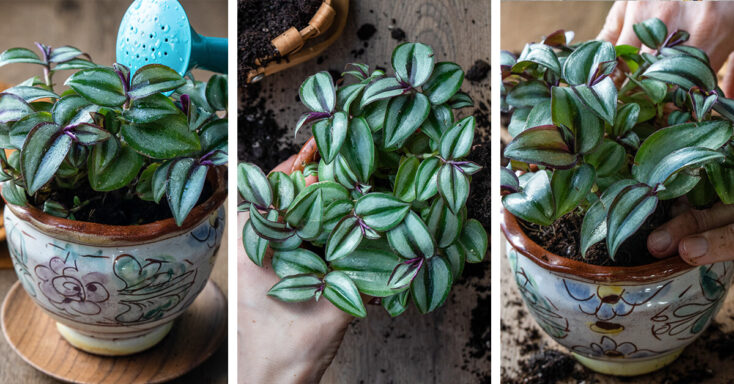

Wandering Jew Plant Care – How to Plant, Grow and Help Them Thrive
Tradescantia zebrina, commonly called the Wandering Jew plant, is a striking houseplant known for its variegated leaves tinted with green, silver, and purple. It originated in Central America and Mexico’s tropical regions. So, the Zebrina is a perfect choice for growing indoors. The good news is that Wandering Jew plant care is not difficult at all!
Key Takeaways
- Zebrina is a low-maintenance, fast-growing plant.
- The Zebra Plant makes an excellent choice for beginner gardeners because care isn’t overly complex.
- This plant quickly fills up empty spaces in your indoor landscaping efforts.
- Pruning is good for Zebrinas. It maintains their shape and keeps them from becoming invasive.
Wondering about the Wandering “Dude”
The Zebrina has numerous nicknames (many from cultivars), including Silver Inch Plant, Striped Trad, Striped Wandering Creeper, Purple Heart Plant, Small Leaf Spiderwort, Moses in the Cradle, and Zebra Plant. Because the name Wandering Jew is offensive to some, gardeners usually use one of these, the botanical name, or the new moniker, Wandering Dude.
The flowing leaves on this plant measure about ½ inch long and about ¼ inch wide. When used outdoors, they make a colorful ground cover. The flowers are pink to purple and bear brownish seeds. Take care when you work with the zebra plant. The sap proves irritating to some people.
Light Play: When Zebrina is in bright light, the colors become even more vibrant. If you have a window location with indirect light, the exposure enhances leaf pigments. It is very visually appealing.
The Basics of Wandering Jew Plant Care (Zebrina)
In taking care of any indoor plant, there are certain important points in your care routine.
- Temperature: Zebrina plants thrive when the temperature is around 70 degrees. Keep the plant away from drafts or air conditioning ducts.
- Light: South or eastern-facing windows work best, provided the light is indirect. If they’re not getting enough sun, they become spindly.
- Water: Keep your inch plant moist. Avoid over-watering or letting the plant’s soil dry out completely.
- Soil: Plant your Wandering Dude in a peat-based potting mix with good drainage.
- Humidity: Good news! The average humidity in your home should work fine.

The Battle of Fronds vs. Flowers: Many people buy houseplants for their flowers. Zebrinas do produce delicate petals, which look charming. However, the true allure of the Wandering Dude is its foliage.
Wandering Jew Plant (Zebrina) Needs
When you’re looking for a beautiful backdrop to your indoor garden efforts, Zebrina fills that need. Mix the type of container you use for greater visual impact. You can take your plants for a summer stroll, but you cannot leave them outdoors during winter.
Except for Purple Queen Zebrina, which loves direct light, the fronds of these plants will burn if left in direct sunlight for too long. If you have a window that gets light in the morning and indirect light later, the Wandering Dude will thrive.
Tip: Turn your pots periodically so all sides of the plant benefit from sunlight.
If you’d like to expand your Zebrina family, propagation is simple. It begins with taking a stem cutting. Look for a healthy stem and snip it below a node. You can then root it in a glass of water or put it directly into the soil. A little rooting compound improves the results from direct soil planting.
Choosing a Wandering Jew Plant for Your Home
Inch Plant (blossfeldiana): Thick, fuzzy leaves with purple undersides. It blossoms in flower clusters of white, rose pink, or blue. Mature height 6-12 inches.
Longpipes (Wild Crocus): These bluish-purple flowers appear from May until June. It’s thin, arching leaves grow up to 7 inches long. If you have a rock feature inside, longpipes will do well there.
Moses-in-a-basket (Oyster Plant; Boat Lily): The dark green leaves are sword-like and grow in a spiral. The undersides of the foliage are purple, and it blossoms with white flowers. Dwarf plants are 6-12 inches tall and require 6-8 hours of indirect light daily. The vibrant purple undersides of this plant’s leaves are truly striking.
There are two popular variants of Moses-in-a-Basket. One is a Tricolor, bearing pink, green, and cream leaves. The other is a Golden Oyster with bright gold-yellow leaves.
Pallida: A native of Mexico, Pallida goes by the name Purple Heart. The foliage is eggplant purple, adorned with light pink flowers bordering on orchid—a good choice for hanging baskets. Grows 1-2 feet tall and wide.
Striped Inch Plant (River Spiderwort, Speedy Henry): Average size is 12” x 12”. The plant’s leaves are dark green, shiny, and pointy (2 inches). Striped inch plants blossom with white flowers.
Virginia Spiderwort: Bright green narrow leaves topped with violet, three-petaled flowers that measure 2” across. Each flower only lives for a day, but there are so many you won’t notice. This is a larger member of the Wandering Jew family, with an adult height of 18-20 inches and a width of 12-18 inches.
White Velvet: Gray-green leaves covered in white hairs distinguish this Wandering Jew from others. It blossoms for about a month in bright pink-purple flowers. Received the Award of Golden Merit from the Royal Horticultural Society. Mature height: 12 inches.
While humans suffer no illness from Zebrina, ingestion by pets can be toxic. Keep this in mind when placing them around your indoor garden.
Wandering Jew Plant Watering Techniques
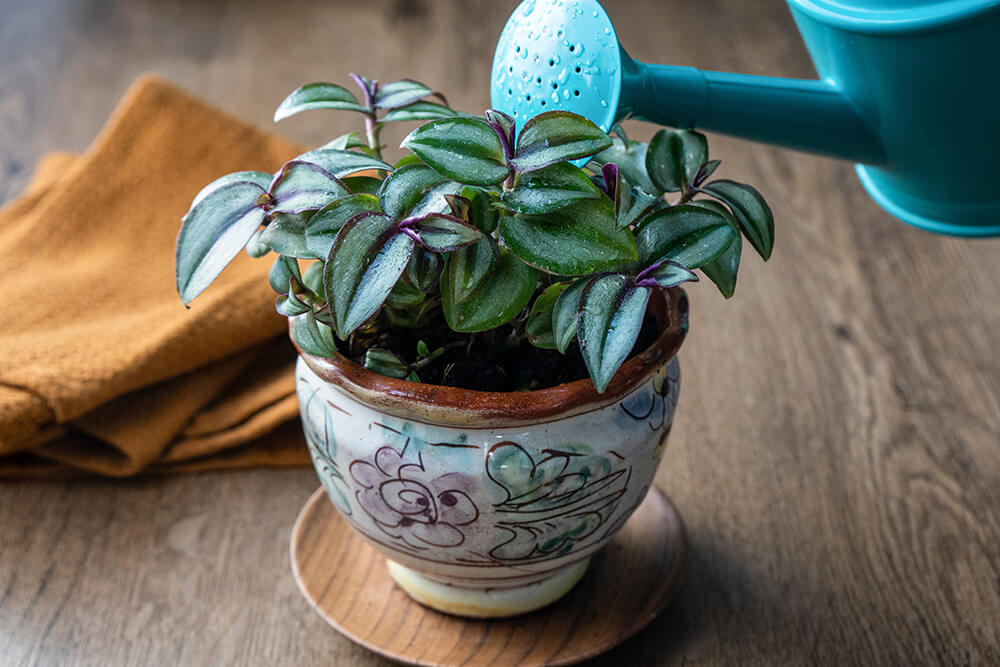
While these plants handle random overwatering, it won’t continue being healthy if left waterlogged too long. When you apply water, do so from the base of the plant. Watch and you can see the water absorption. Alternatively, you can take the plant to your sink and give it a good bottom watering until the liquid comes out of drainage holes. Let it finish in the sink, then put it back in place.
When you walk through your home, regularly check your plant’s soil. Put your finger down to the ½ inch point in the soil. If it’s dry, then water. Because your Wandering Jew may grow at different rates throughout the year, this test alleviates guesswork.
If you are busy and may forget, try an aqua globe.
Vertical Space: If you want a plant to fill some of your vertical space, you’ll be happy to know Zebrina can be trained. By using a support, you can guide it toward climbing. Use a moss pole or trellis as a support system.
Wandering Jew: Potting and Repotting
Tradescantia are fast growers, so you may need to repot it every two or three seasons. When it’s time, you want to give the plant a larger container and fresh soil. Zebrina’s roots will start peeking out of drainage holes to tell you they need more space. Alternatively, they may move up the side of the pot toward the container’s edge.
When you remove the plant from the current container, begin by putting it down on its side. Hold the pot with one hand and the base of the foliage with the other. Gently wiggle (the stems can be quite delicate). Once it slides out, shake off old soil and inspect for signs of disease or pests.
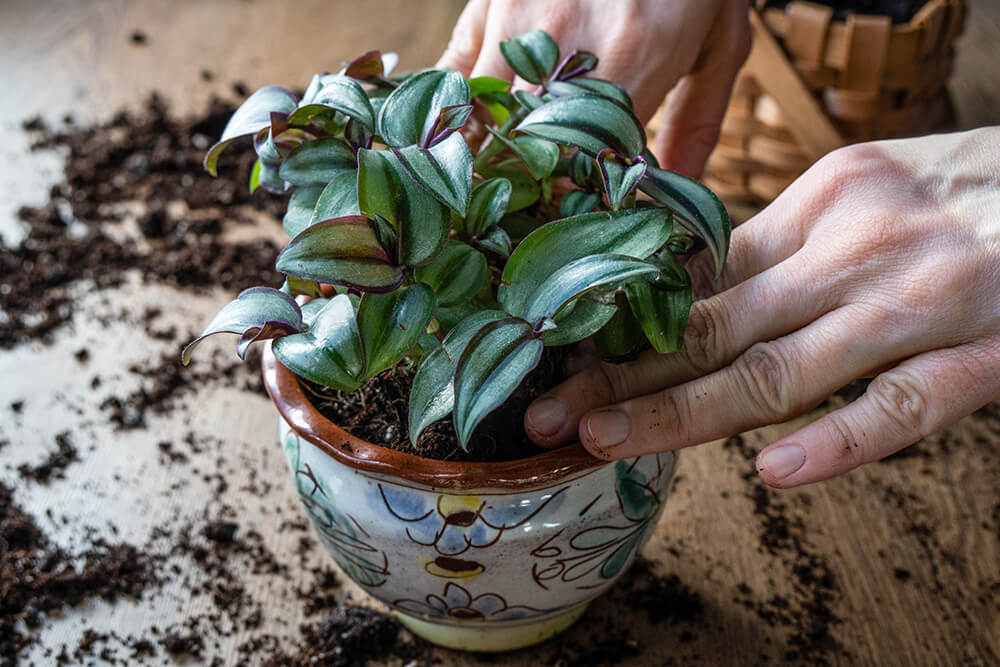
As a generalization, Zebrina represents adaptability, growth, and resilience. Because of its hardy nature, this plant has become a metaphor for overcoming adversity and showing grace during times of transformation. It is an emblem of the human spirit’s perseverance and enduring hope. In literature, the flower appears as a symbol of beauty, strength, faith, and diligence.
Dream books say the Wandering Jew appearing reminds you all is not lost. Stay true, stand tall, and succeed. If you’re holding the flower, it portends luck and prosperity.
Pruning and Maintenance
Because this plant grows quickly, heavy pruning is good for it. Make it an addition to your regular Wandering Jew care routine. Trim off long tendrils, dead leaves, and weak growth. Pinch off new growth and thin it out. This helps create a bushy appearance and transforms the plant into something suitable for your indoor efforts.
Sometimes, per their name, Zebrina goes a-wandering. It becomes leggy stems with few leaves. Keep those trimmed down so the plant can focus its energy more effectively. If you’re plants look rather dull, trimming is the trick for promoting thick leaves.
Perhaps the most important reason for pruning Wandering Jews is to keep them healthy. Removing unhealthy or dead parts deters fungus and disease.
When: Indoor plants often follow nature’s lead, resting during fall and winter. So, give them their haircut in spring or early summer at the latest.
Zebra Plants and Therapeutic Properties: Inch plants have antioxidants and antimicrobial properties. In areas like Jamaica, people treasure them as a treatment for high pressure and cough while applying leaves for swelling. In China, this plant has the name “Water Turtle Grass.” It’s recommended for kidney disorders. Mexicans have an inch plant leaf decoction used as a tonic. Along the same lines, Guyana healers brew the leaves and offer the tea for influenza and digestive issues.
Blooming and Resting Periods
This plant’s flowers benefit from a dormant period the previous winter. Since it’s indoor, you’ll need to put the Zebrina in an area hovering around 60F. Reduce water. You want the soil to dry for two weeks between irrigation. Always use room-temperature water so you don’t shock your plants.
Once the Wandering Jew is growing, you’ll need to water it once a week. Now is the time for fertilization.
There is a legend that surfaced in the 13th century. It says that a Jewish person taunted Jesus on his way to crucifixion. As a result, the person was cursed to walk the earth until the second coming. Another sad account was that of a condemned man separated from his sister by the Bering Straight. He set out to find her, yet wherever he traveled, plagues followed. There is no happy ending here. The fellow never finds his sister.
There is no question that the Wandering Jew is diligent and sometimes invasive, so perhaps some of those characteristics contributed to the plant’s name.
Common Pests & Plant Diseases
Wandering Dudes rarely have pests indoors. Occasionally, you may find aphids or spider mites. You can wash both off the leaves or use a natural insecticide.
When you see small white webs on the undersides of leaves, that’s a spider mite. They like it warm and dry, so amp up the humidity using a household humidifier near the plant. Spray it periodically. Should the critters persist, wash the plant in your sink.
Signs of Aphid infestation include:
- Weakened growth
- Yellowing, twisting, or curling leaves
- Small white flakes on the leaves (this is the result of aphids shedding their exoskeleton)
- A sticky, shiny substance on leaves and stems (honeydew)
- Black, sooty mold (a result of honeydew)
- Diseased plants (aphids carry over 100 different viral diseases that can settle into the Wandering Jew)
Neem oil is a trusted remedy. Apply, then re-apply in a week. Continue more applications until they’re gone.
When it comes to disease, most develop because of over-watering, which leads to root rot. Roots can only retain so much water before they start getting mushy. The good news is you can remedy this easily. Reduce your watering schedule and improve the drainage in the soil. Just add some coarse sand or perlite.
Black patches and white powdery particles on your plant’s leaves reveal fungal issues like leaf spots, botrytis, and powdery mildew. Clean away affected foliage. Make sure your plant isn’t over-watered. If you get stuck and the fungus won’t go away, you should dispose of the Wandering Jew and sterilize the container before reusing it.
In an odd twist, you can grow wandering jew plants in water. You will need to change the water every 4 days and add a little fertilizer (3:1 ratio in freshwater). Using purified water is best. Salt and chlorine can adversely affect these plants. Also, make sure the water is at room temperature. With the right lighting, you can keep Zebrina alive in water for a long time, much like money plants.
Troubleshooting Common Wandering Jew Problems
- Bare stems and spindly growth: Over the years, this is natural. However, in younger plants, it may indicate a lack of light, water, or fertilization.
- Loss of leaf color: When variegated leaves begin turning all green, your plant is getting too much direct sunlight.
- Limp stems: Typically means a lack of water, but could be a sign of insects.
Word Play: The Inch Plant’s name is descriptive to a T. This foliage grows approximately one inch every week! It can also propagate itself using only an inch of stem.
Frequently Asked Questions About Jew plant
Does a wandering jew plant need sun.
Yes, but not direct sun. An area with indirect light is best for these plants. Turn the plant periodically so all sides get filtered light regularly.
How do you care for a wandering Jew indoors?
Now, you may have Wandering Jews that are just indoor plants. But if you have outdoor pines, you; 'll need to bring them into your home before the threat of frost. They’ll do just fine in your household landscape as long as you give them adequate light and proper watering.
How often do you need to water a wandering Jew plant?
If your Wandering Jew develops mushy stems, you’re over-watering it. Don’t automatically bring over the water pail. Check the soil. If it’s dry down to 1”, it’s safe to add moisture. Otherwise, wait.
How long will wandering Jew last?
Wandering Jews are fairly hardy. As long as you care for them correctly, your Tradescantia plants will live for many years.
How big do wandering Jews get?
Much depends on the type. Most plants don’t grow beyond one foot tall but may have longer (2-foot) stems.
Zebrina plants have a rich history and a variety of interesting traits. It thrives in a variety of environments, and has alluring striped leaves, and people enjoy looking at it. When you want to add some living greenery to your indoor garden, Zebrina is one possibility. It’s exotic yet understated, and you will enjoy it for years to come.
- Living Room
- Dining Room
- Laundry Room

Tradescantia Tricolor Care From A to Z
By: Author Daniel
Posted on Last updated: July 15, 2021
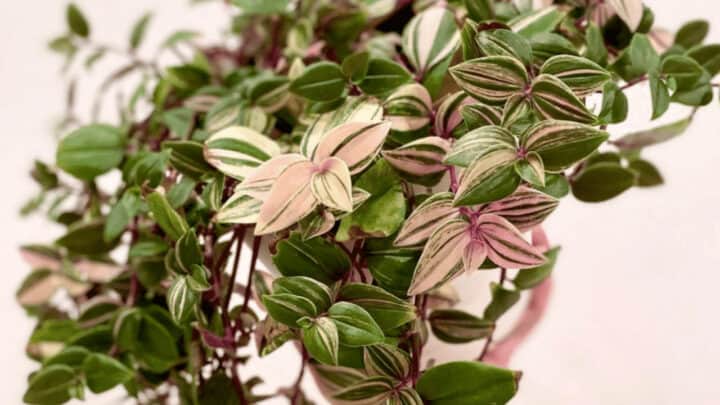
Sharing is caring!
- Facebook 11
(image credits, IG: oohyouplantsy )
I have a hide-away in my home that I escape to for some me-time. It is ultra-feminine and all done out in pink.
When I saw this stunning pink Tradescantia Tricolor plant at the nursery, I just had to have it! It offers the most glorious shades of pink transforming into a darker purple, interspersed with green.
Like all plants, the Tradescantia Tricolor has a difficult Latin Name. This one is Tradescantia fluminensis.
It is also known by other names including the Wandering Jew , Flowering Inch Plant, Wandering Willie, Wandering Gypsy, Purple Queen, Spiderwort, and Tradescantia.
What’s more, Tradescantia is a genus of 75 species of wildflowers. The name comes from John Tradescant, a botanist who lived during the 17th century.
The ‘wandering’ word refers to the fact that it spreads easily, wandering all over your window sill. They are very easy to grow at home. Most are native to South America where they grow as dense mats underneath forest trees.
To enhance the glorious pink shades, I place my Tradescantia Tricolor next to a Mosaic Plant , Fittonia albivenis. This is a trailing plant with deep pink veins in the green leaves. They make a great pair.
Let’s take a closer look at how to care for your Tradescantia fluminensis .
Table of Contents
Tradescantia Tricolor Care
For ideal Tradescantia Tricolor care, give it well-draining soil that will partially dry out between waterings. Fertilize with a good mix of peat, compost, mulch or humus, bark, pumice, or perlite. It thrives best in temperatures between 65°F to 75°F (18°C to 24°C). Temperatures should not drop below 50°F (10° C). The Tradescantia Tricolor wants bright light but not direct sunlight. Placing it near to a south-facing window is ideal.

Tradescantia fluminensis enjoys moist soil to thrive best. However, it must not be drenched or allowed to dry out completely.
Plant it in well-draining sandy soil. You can achieve this by mixing perlite into regular potting soil. Use a mix of 40% perlite and 60% potting soil.
Ensure that your pot has drainage holes at the bottom. This allows the excess water to run out and won’t cause the roots to become waterlogged and drown.
For ideal Tradescantia Tricolor care, I use natural organic additives. Including everyday materials like pumice or crushed bark, sterile garden compost, mulch, or organic manure gives you a rich, fertile soil that makes your Wandering Jew flourish.
Adding in some environmentally friendly coco Husk chips is a great way to introduce extra aeration into the soil. The Tradescantia Tricolor is not fussy about PH levels, try to maintain a neutral PH of around 7.0.
Tradescantia Tricolor does best in bright conditions with indirect sunlight. Allowing direct sunlight to fall onto the plant for too long causes the leaves to scorch.
Too little sunlight results in the leaves fading and not producing those lovely pinky shades.
Try to place your plant about 3 feet away from a south-facing window (if you are in the northern hemisphere), on a side table or high shelf. In this way, it gets the benefit of bright light but not direct sunlight. In general, 45 minutes of direct sunlight will be enough.
If you do need to stand it on a window sill, try to place a sun filter over the window. You can also use your décor skills and get it to nestle under another plant with large leaves, creating a natural umbrella.
If you prefer to plant your Tradescantia Tricolor outdoors, find a spot that gets bright light and limited direct sunlight.
Care tip for Tradescantia Tricolor: If your plant does not show healthy signs of variegated growth, ie, it is not displaying lovely different pink colors, it is probably getting too little light.
When it comes to watering care for your Tradescantia Tricolor, it is best to keep the soil moist. You need a balance between drenched and bone dry.
Watering once a week during the summer months is adequate. In winter, reduce watering to once every two weeks.
Because you are not drenching this plant, you should not create too much of a mess indoors. Place a plant saucer under your pot that is large enough to catch any water that may flow out.
When watering in winter, use lukewarm water, no plant responds well to an icy blast! I do notice that my Wandering Jew can get to the point of looking almost droopy. Then a good watering brings it back to life within 24 hours.
Tradescantia Tricolor care tip: You can also water from the bottom. This technique involves placing your pot into a tub or sink filled with a few inches of water. The drainage holes in your planter allow the water to slowly absorb into the soil without over-saturating it.
Temperature
Tradescantia species perform best at temperatures ranging from 65°F to 75°F (18°C to 24°C). They can, if necessary, withstand higher temperatures. If the temperature drops below 50°F (10° C), the leaves will suffer.
It will tolerate short-term exposure to cold weather but generally does not do well in the cold. If you live in a cold climate, consider growing your outdoor Tradescantia Tricolor in a container.
You can then bring it indoors during the winter months. All species of Tradescantia are Winter hardy in USDA hardiness zones 9 to 12.
Coming from South America, the plant does not require tropical temperatures to thrive. It is quite hardy, and as long as it is not exposed to frost you should be fine. It can even stand on a chillier window sill.
Your Tradescantia Tricolor is not overly fussy about humidity. It is not a desert plant nor a tropical plant, so the average house humidity of 30% to 45% found in a home should do fine.
In winter, running heaters and air-conditioners can dry out the air and change the humidity, so you will need to be aware of this.
If the humidity in your home is too high, at over 50%, this could result in the growth of mold and bacteria and will give your living space a musty smell. Installing a dehumidifier will help to solve the problem.
Tradescantia Tricolor care tip: I find that my plant responds well to a lovely soft shower from a watering can.
Although this does not increase humidity, it acts as a natural rain shower, wetting all the leaves and washing away dust and pests.
Make sure you do this outside and allow the plant to dry off before moving it back indoors.
Fertilizer
The Inch Plant loves to wander and grows fairly fast, spreading over window sills indoors and rocks outdoors. It does not require a serious fertilizing program.
Like many potted indoor plants, Tradescantia fluminensis does well with some extra fertilizer during the growing months of Spring through early fall.
I am a great supporter of eco-friendly living and that also applies to the plant fertilizers I use. I stay away from chemical fertilizers whenever possible.
My number one care hack for Tradescantia fluminensis is to buy or make my own natural organic fertilizer. If you have a liquid fertilizer, dilute it, and use it once a month.
Fertilizing plants outside of the growing season is not good. The fertilizer can end up harming the plant by burning the roots.
Natural organic fertilizers can be made using peat, pumice, perlite, mulch, coco husks, and crushed bark. A small compost making kit is a fun addition to any garden and makes good use of fallen leaves, dead flowers, and grass cuttings.
Propagation
The easy-to-grow Inch Plant is also easy to propagate. This can be done by simply snipping off a healthy stem, placing it into rich, moist soil, and watering from time to time.
You can also put the stem cutting into a tall vase of water and allow it to grow roots. Place the vase in a bright spot and keep an eye on it.
Roots will appear within a week. Remove the cutting and plant into your terracotta pot or unglazed planter.
Propagating your own house plants is a fun and rewarding experience, give it a try!
Tradescantia Tricolor gets its Wandering’ name because it loves to wander. It grows fairly fast and spreads over the edge of pots, along window sills, and over rocks. It also looks great as a ground cover next to pathways and walkways in a garden.
It has beautiful variegated pink shades, that darken to purple and are interspersed with green. The stems and leaves are soft and hairless.
The leaves are an oval shape with pointed tips. They are shiny and smooth and grow to about 1.25 to 2.5 inches (32 to 64mm) long.
The flowers are white and have 3 petals, about 0.5 to 1 inch (13 to 25mm) in diameter. The flowers appear in Summer in small clusters.
The best Wandering Jew growing condition is in a bright spot with indirect sunlight and average humidity.
This plant is a ground cover perennial. It does not require heavy pruning, but if it sprawls too much and becomes straggly, you should trim it back to keep it in shape.
Tradescantia fluminensis care tip: If your plant is producing only green leaves, your light conditions are not ideal.
It does this to conserve energy, as creating variegated leaves uses up more energy. Prune back the green leaves, allow it to recover and produce those glorious pink shades.
Tradescantia fluminensis is not fussy when it comes to pot size. It will thrive in a small pot for years and will grow happily in a large pot.
If you do want to repot your Inch Plant, Springtime is the best season to do this. Repot into a mix of fresh soil and perlite to boost growth.
You can add some gritty sand to the potting mix to enhance drainage. Water well but do not drench. Check that the PH of the soil is neutral at around 7.0.
Care tip: Ensure that your planter has drainage holes so that the water can flow out. You don’t want the roots to rot in stagnant water at the base of the pot.
Sieh dir diesen Beitrag auf Instagram an Ein Beitrag geteilt von D A I S Y (@oohyouplantsy)
Propagate Tradescantia Tricolor from cuttings
– This is best done in early Spring to late Summer, during the growing period
– Use a sterile sharp knife, scissors, or cutter
– Wear gloves as the sap can irritate the skin
– Select a stem that looks healthy and has a few sets of leaves
– Carefully cut off the stem at the base, where it joins another stem
– Remove the lower leaves by snipping off to leave a clean stem at the base
– You now have 2 options: propagate in soil or propagate in water
Propagating the cuttings in soil
– Prepare a pot with a mix of soil, gritty sand, and organic fertilizer
– Water well but don’t drench
– Push your finger into the soil and create a hole about 2 inches deep
– Place the offcut into the soil and pack the soil back to hold it firm
– Place the planter where it will get bright light but not direct sunlight
– Water well for the next few weeks
Propagating the cuttings in water
– Fill a clear vase, tall glass, or container with water
– Place the cutting into the water
– Keep it shallow enough so that the leafy section is above the waterline
– A slender glass works well as the leaves will balance on the top rim
– Fine roots will start showing in about 1 to 2 weeks
– Wait for the roots to grow to 1 to 2 inches long
– Plant into a pot as described above
Common problems with Tradescantia Tricolor
Pest control.
Like all plants, your Tradescantia Tricolor can be attacked by pests. Common pests that affect the Wandering Jew are spider mites and aphids .
An easy way to get rid of them is to give your plant a good shower and wash them off. If they persist, you can spray with a solution of insecticidal soap.
Tradescantia Tricolor care tip for pests: Make your own insecticidal soap. Use all-natural soap, not detergent.
Mix 5 tablespoons to 1 gallon of cooled, boiled water. Add in 1 teaspoon of vinegar and 1 teaspoon vegetable oil to get the solution to stick. You can also add a teaspoon of garlic. Pour into a clean garden sprayer that has a fine spray setting and spray the plant.
Leaves don’t have variegated colors
If you notice that your Tradescantia Tricolor is only producing green leaves, this is due to bad lighting. Bad lighting reduces the energy of the plant.
To create the gorgeous colors, it needs energy, so it will conserve energy and only create green leaves.
Leaves look scorched
If your leaves are turning brown or look scorched, your plant is getting too much direct sunlight. Move it to a more suitable position, or protect it with sunscreen if possible.
Plant looks scraggly and untidy
Tradescantia Tricolor grows fast and spreads. You need to keep it in shape by trimming now and then. Remove any dead stems and leaves. Trim back into the neat shape you want.
Rotting roots
This is a sign of too much water. Tradescantia Tricolor does not enjoy drenched soil. Ensure that your container has drainage holes and allow the soil to partially dry out.
Tips to grow Tradescantia Tricolor problem-free
– Avoid overwatering your Tradescantia Tricolor
– Keep soil moist but well-drained
– Ensure that your plant is in a bright spot, it does not enjoy the dark
– Do not place in direct sunlight
– Does not enjoy very dry or very humid conditions
– Fertilize during the growing season with organic mixtures
– Trim from time to time if it becomes scraggly
Frequently asked questions about Tradescantia Tricolor
Is tradescantia tricolor considered invasive .
In some countries, Tradescantia Tricolor is invasive. This is because it spreads fast outdoors and can become invasive. It grows as thick mats in forest areas, blocking out the light for other ground plants.
Can Tradescantia Tricolor grow indoors?
Yes, it makes a very attractive indoor plant in a decorative pot. It looks fabulous in a hanging basket, or on a high shelf where you can let the long stems flow downwards.
Is Tradescantia Tricolor easy to care for?
Yes, this is a great plant for beginners. It requires very little maintenance and is hardy and strong. You don’t want to be discouraged by losing your first plant. The Tradescantia Tricolor will flourish in a bright spot out of direct sunlight.
Is Tradescantia Tricolor poisonous?
Do you want a glorious plant with pink tones? The Wandering Jew is eye-catching and easy to care for. It is a great choice for a beginner to create a focal point in a room or on a patio, in a hanging basket.
Once you are successful in growing your Tradescantia Tricolor, you can add other Tradescantia plants to your collection. Take a look at the lovely Tradescantia occidentalis, Tradescantia zebrina, and the Tradescantia pallida.

Daniel has been a plant enthusiast for over 20 years. He owns hundreds of houseplants and prepares for the chili growing seasons yearly with great anticipation. His favorite plants are plant species in the Araceae family, such as Monstera, Philodendron, and Anthurium. He also loves gardening and is growing hot peppers, tomatoes, and many more vegetables.
Related Posts
You are reading this guide to learn more about the Wandering Jew Plant and its…
I love plants that offer an eye-catching burst of color. They sure put a smile…
Tradescantia Nanouk is not difficult to care for if you keep in mind its basic…
Are you looking for a care guide for Anthurium Andraeanum? The Flamingo flower is a…
Among my favorite houseplants is NJoy Pothos, the one that sparked my interest in having…
Several Calathea species are highly valued as houseplants, such as the Calathea Zebrina…
How to Grow and Care for a Wandering Dude Plant
Here’s how to care for this pretty trailing plant.
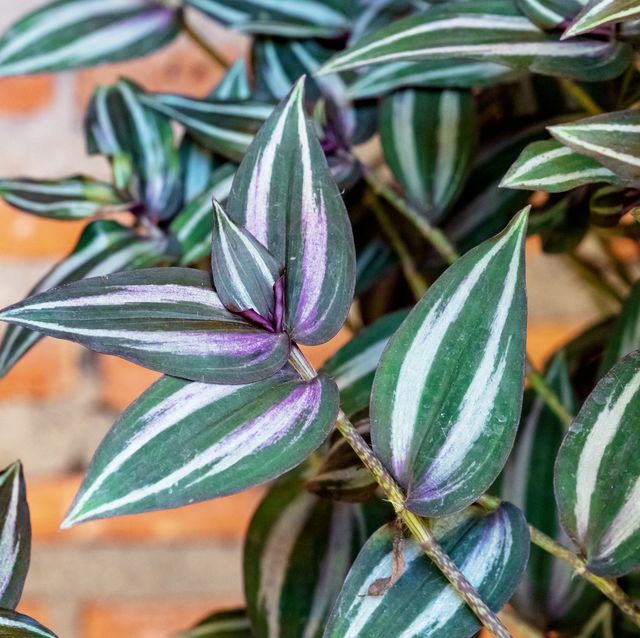
Country Living editors select each product featured. If you buy from a link, we may earn a commission. Why Trust Us?
With its long dangling stems, this plant tends to “wander” all over the place. Today, the plant often is called by its botanical name, Tradescantia, with “zebrina” referring to its silver striping.
It’s sometimes also called silver inch plant, but it can be confused with another plant, commonly called inch plant, Tradescantia fluminensis , which has solid green foliage.
Other varieties of wandering dude have become widely available in recent years, including the very popular nanouk type, which has foliage with pretty pinkish stripes and magenta undersides.
Native to Mexico, Belize, Guatemala and Honduras, the wandering dude usually is grown as a houseplant, but in USDA Hardiness zones 9 to 11 , it can be grown as a low-growing ground cover, too. ( Find your zone here .)
Read more: 15 Common Houseplants to Grow and Brighten Up Your Home
Ahead, learn everything you need to know about how to care for a wandering dude plant:
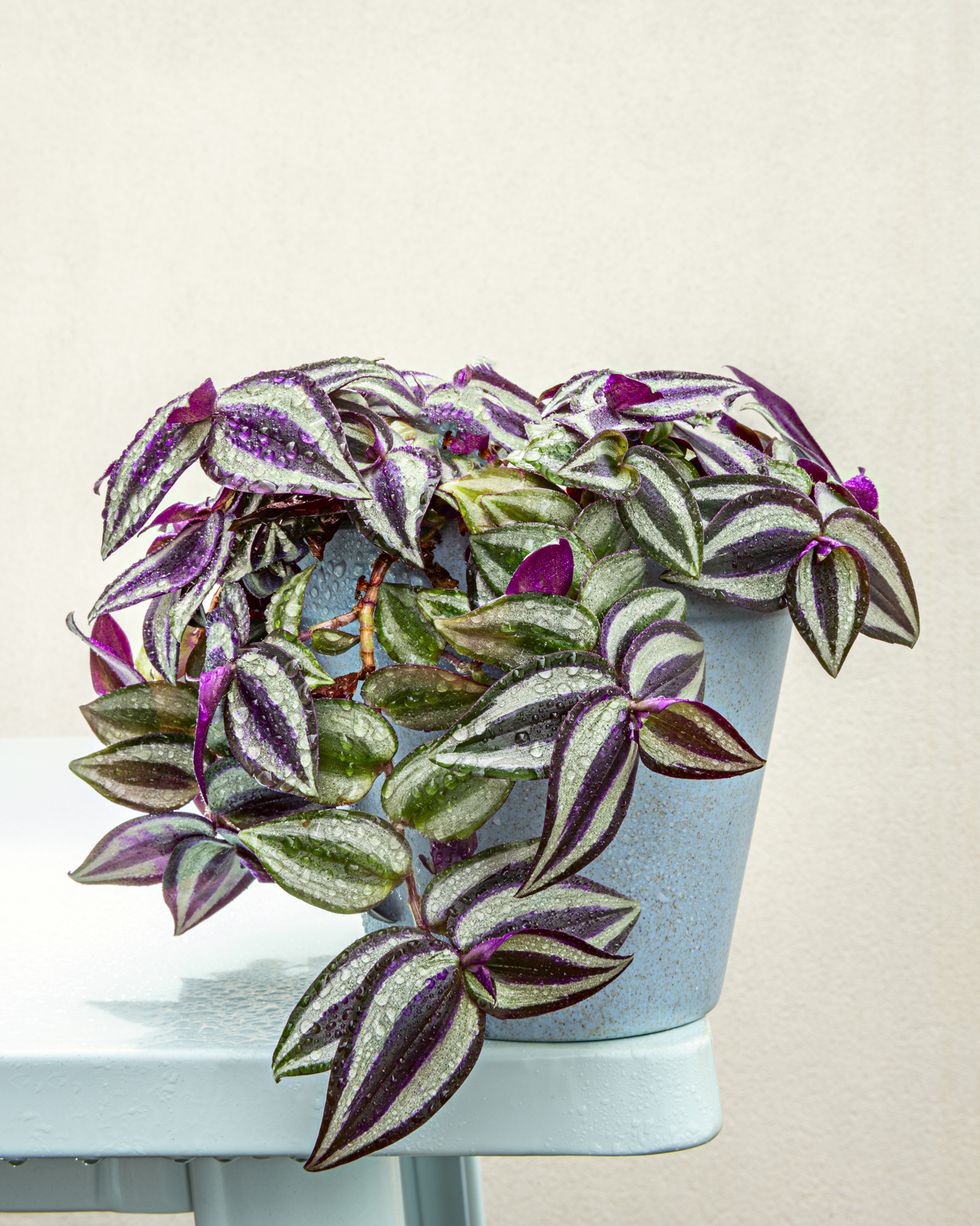
Wandering Dude Basic Info:
- Common Name: Wandering dude
- Botanical Name: Tradescantia zebrina
- Plant Family: Commelinaceae
- Type of Plant: Perennial, grown as houseplant
- Native Origin: Mexico, Belize, Guatemala, Honduras
- Sun Exposure: Full sun to part shade
- Mature Size: 6 inches tall by 1 foot wide
- Toxic to pets: Yes
Why Trust Us
I'm a garden writer with more than 15 years of experience growing houseplants, edibles, and landscape plantings. I also regularly trial new plant cultivars for performance and reliability, and test garden products to evaluate practicality and durability.
How Do You Care For a Wandering Dude Plant?
Give wandering dude bright, indirect light. If it doesn’t get sufficient light, this plant tends to get gangly and unattractive. Its purple coloring also may fade in low light, which means you should move it to a more brightly-lit room or use a grow light.
If your wandering dude is starting to get scraggly, simply snip off a few inches from the end of each stem to help stimulate the plant to push new, bushy growth. You can use plant snips or your fingers. You may need to pinch back frequently because wandering dude is a fast grower.
How Do You Water a Wandering Dude Plant?
You should water only when the plant feels mostly dry. Poke your finger in the soil before watering; if soil clings to your finger, wait a few more days and recheck.
If you let it get too soggy, that’s a sure way for it to get mushy and die. Like most houseplants, it’s better to err on the side of too dry, rather than too wet.
If you like, you can feed this plant with any general-purpose houseplant fertilizer, but it’s not entirely necessary.
Miracle-Gro Miracle-Gro Water Soluble All Purpose Plant Food, 3 lb
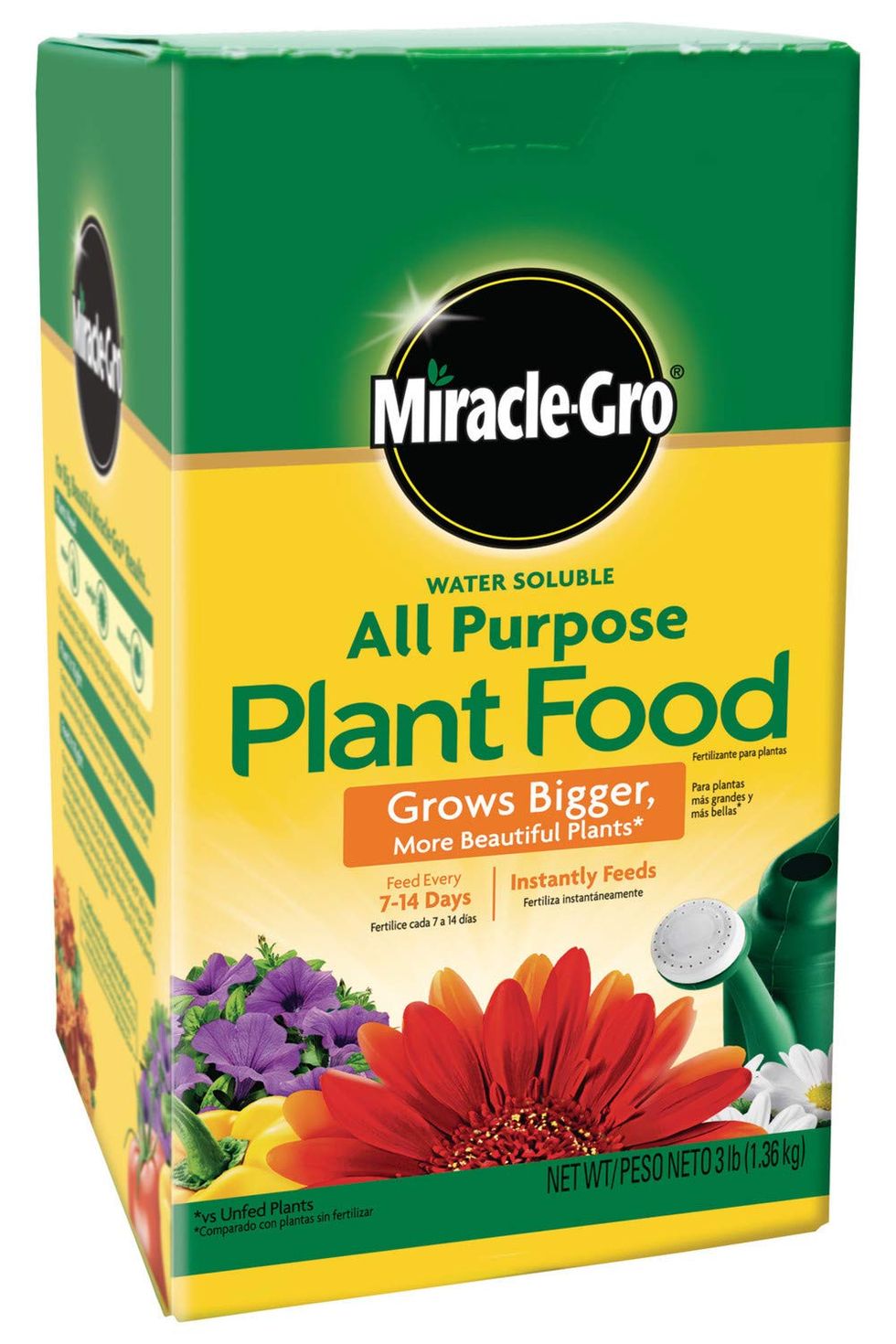
Can You Grow Wandering Dude Plant Outdoors?
Yes, it makes a great trailing plant spilling out of containers! Pair it with tall plants such as hibiscus, canna, elephant ears, or other tall, upright tropicals. If it starts to get leggy, just trim it back. Outdoors, it does best in full sun (northern climates) to part shade (southern climates). It may develop tiny pinkish flowers outdoors, though it rarely flowers indoors.
How Do You Propagate a Wandering Dude Plant?
Like pothos , this is a great plant to propagate to share with friends or to make new plants for yourself. Simply take a cutting, say, if it’s getting too long, then place it in a glass of water to root. Keep it in a bright spot in your home (not direct sunlight), and watch for roots to develop within about two weeks. Then plant in regular potting soil, and keep the soil lightly moist while it settles in.
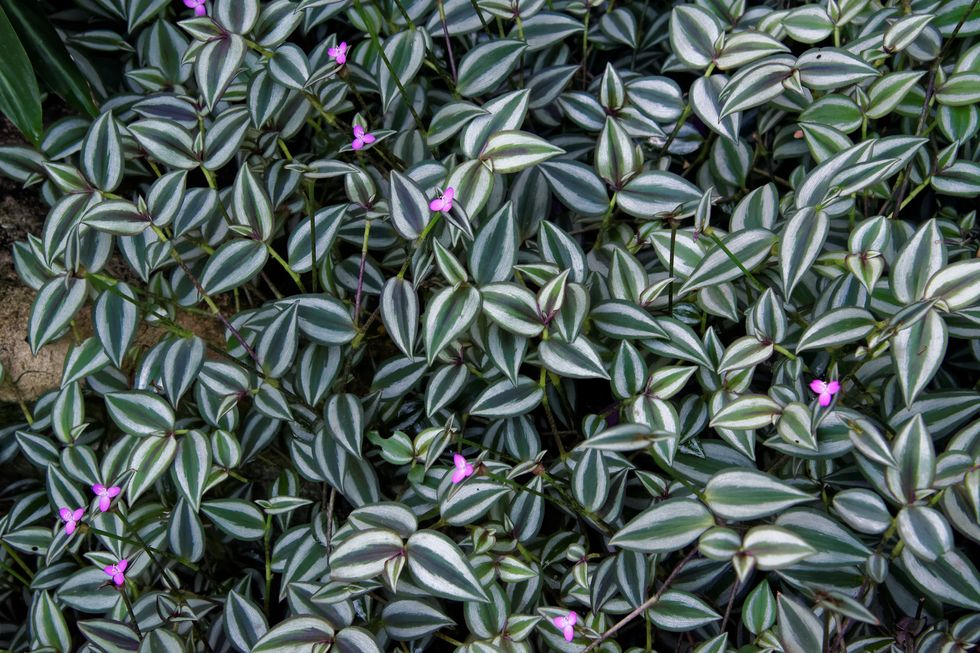
Is Wandering Dude Toxic to Pets?
According to the ASPCA , this plant is toxic to pets and may cause dermatitis, or irritation of the lips and mouth. But remember that any plant may cause vomiting or GI distress if eaten in large enough quantities, so keep this away from pets who are nibblers. Finally, call your vet ASAP if you suspect your pet has ingested it, even if you’re not sure. It’s always better to be safe than sorry!
In addition, the plant sap also may cause skin irritation in some people. Wear gloves when handling cuttings if you tend to have sensitive skin.
Read more: 28 Pet- Friendly Houseplants You Can Grow Without Worry
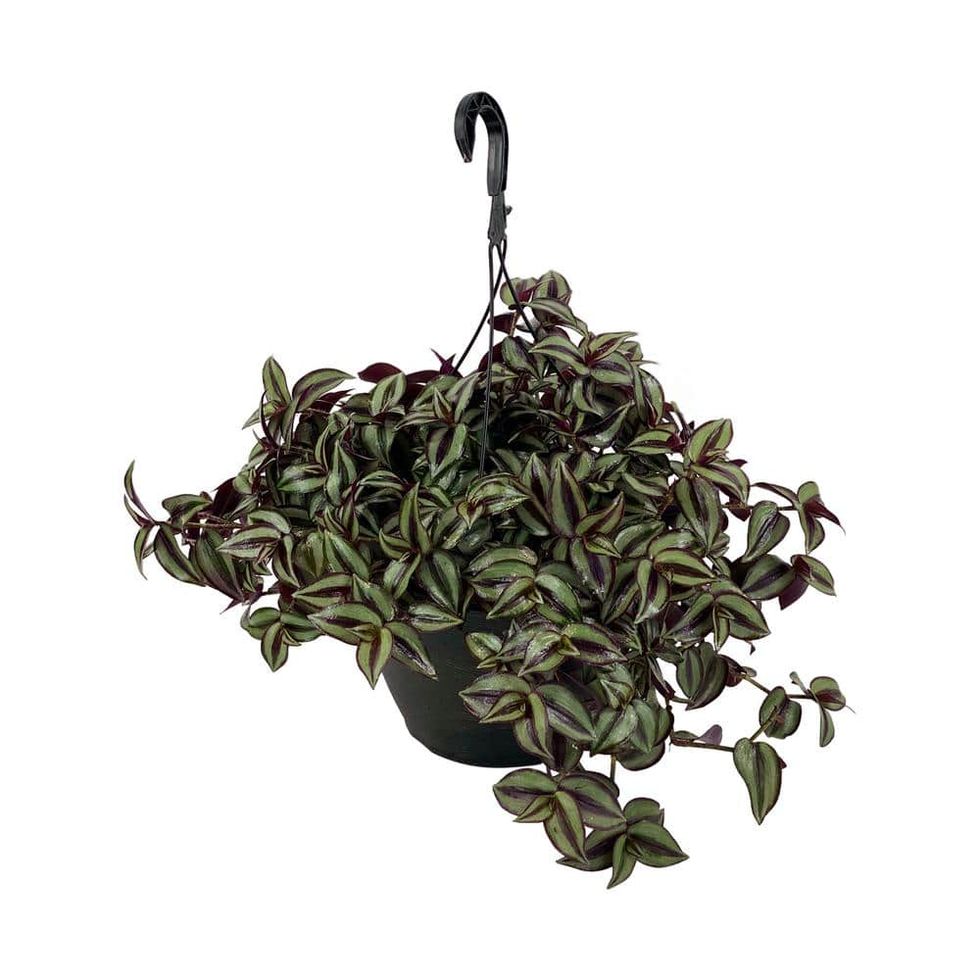
Vigoro Tradescantia in 11-inch Hanging Basket
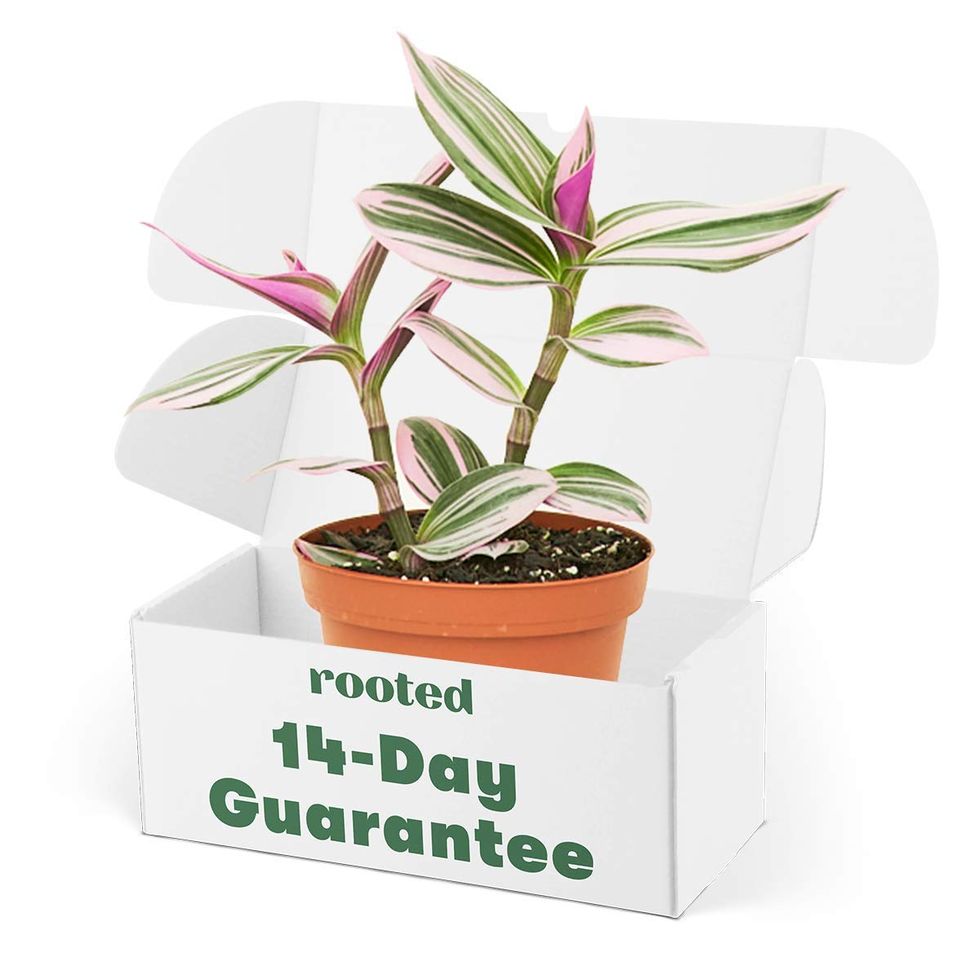
Rooted Tradescantia Nanouk, 4-inch pot
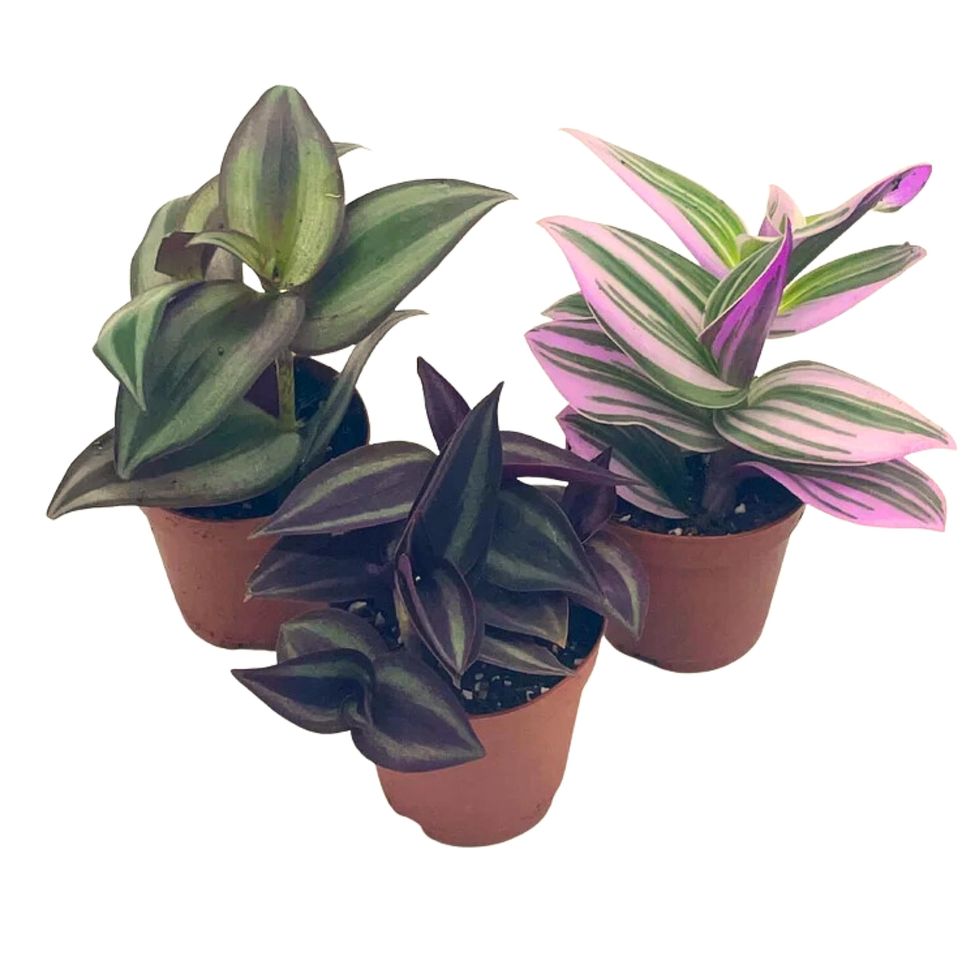
BubbleBlooms Wandering Dude Assortment
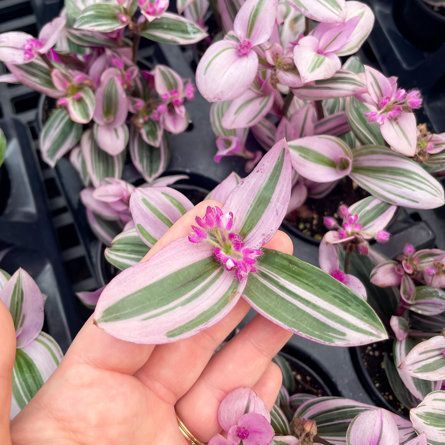
Wayfair Tradescantia Nanouk, 4-inch pot
Arricca Elin SanSone has written about health and lifestyle topics for Prevention, Country Living, Woman's Day, and more. She’s passionate about gardening, baking, reading, and spending time with the people and dogs she loves.
.css-1shyvki:before{background-repeat:no-repeat;-webkit-background-size:contain;background-size:contain;content:'';height:0.819rem;margin-bottom:0;margin-right:-0.9375rem;width:3.125rem;}.loaded .css-1shyvki:before{background-image:url('/_assets/design-tokens/countryliving/static/images/arrow.svg');}@media(max-width: 48rem){.css-1shyvki:before{display:none;}}@media(min-width: 40.625rem){.css-1shyvki:before{display:inline-block;}} Gardening Encyclopedia .css-unxkmx:before{background-repeat:no-repeat;-webkit-background-size:contain;background-size:contain;content:'';height:0.819rem;margin:0.7rem auto 0.9375rem;width:3.125rem;}.loaded .css-unxkmx:before{background-image:url('/_assets/design-tokens/countryliving/static/images/arrow.svg');}@media(max-width: 48rem){.css-unxkmx:before{display:block;}}@media(min-width: 40.625rem){.css-unxkmx:before{display:none;}}
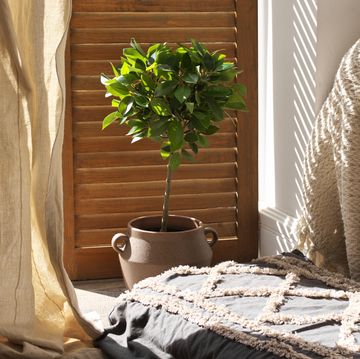
26 Full-Sun Perennials for Your Garden

Got Spider Mites? Here's How to Get Rid of Them
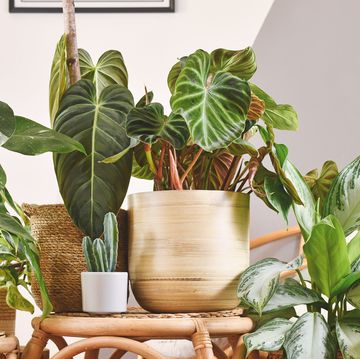
12 Big Leaf Houseplants You Need ASAP
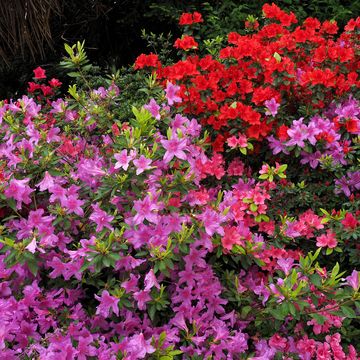
How to Grow Beautiful Azaleas

18 Spring Vegetables That Are Best Right Now

86 Essential Garden Flowers (With Pictures)
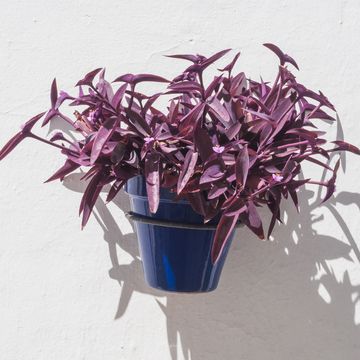
Here's How to Keep Purple Heart Plant Colorful
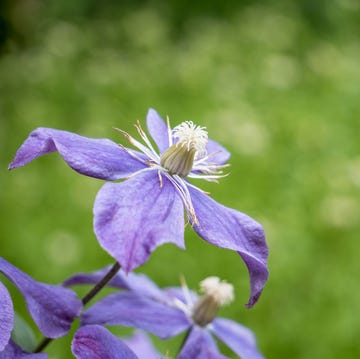
Your Guide to How to Plant and Grow Clematis

21 Indoor Plants That Are Easy to Grow
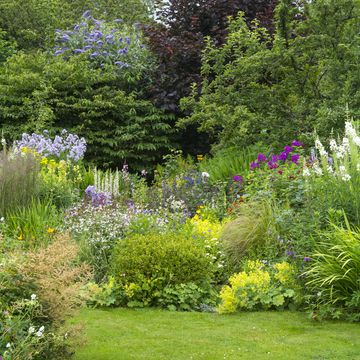
Get Started on Your Spring Garden Plan Now
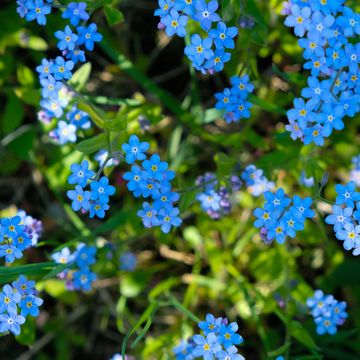
Here's How to Grow Forget-Me-Not Flowers

Tradescantia Zebrina (Wandering Jew Plant / Inch Plant)
By Tom Knight
About the Wandering Jew Plant
The Wandering Jew , Wandering Dude, Inch Plant , Spiderwort or Tradescantia Zebrina is a houseplant that can be grown in a hanging basket to show off its long beautiful trailing vines or kept contained and compact in a pot.
Very versatile, very easy and very hard to finish off, makes this a very good indoor plant to have around.
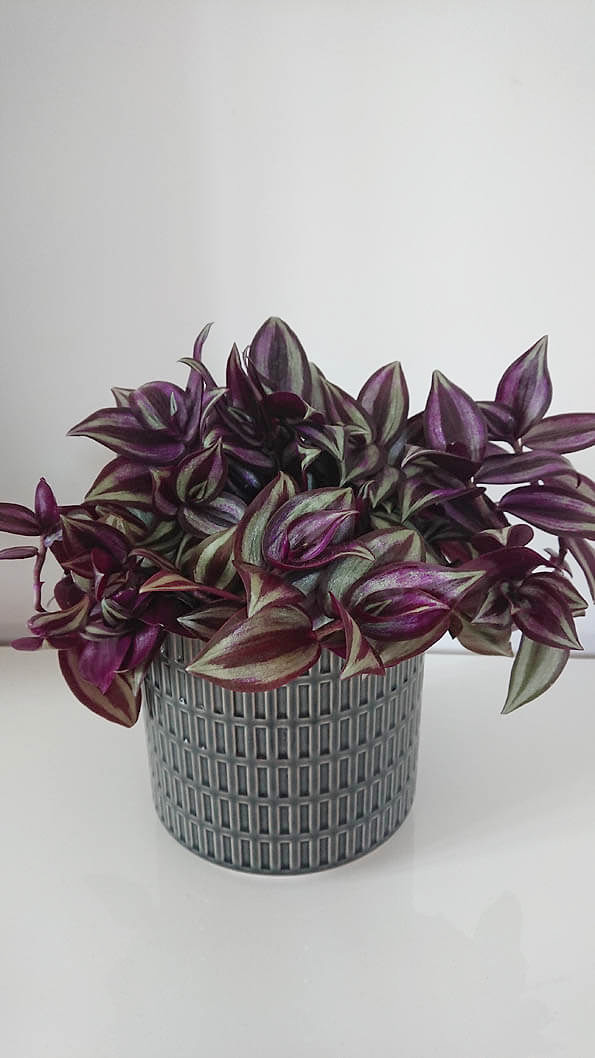
Tradescantia make for excellent houseplants as they fit into almost any design scheme
" Wandering Jew Plant for sale " and " How do I care for my Wandering Jew plant? " are two big hitters when it comes to our visitors asking us questions about this popular and easy care houseplant. We would suggest Amazon.com or Amazon.co.uk or our Where to Buy article to kick start the buying hunt, and our article below will (hopefully) answer the care question for you.
The common names are based around the plant's ability to easily spread itself.
To start things off, a lot of people also want to understand the common names this plant goes by - the Wandering Jew Plant and the Inch Plant . Both names are centered around its ability to spread and grow very quickly, with little care or intervention from people.
Pro Tip - This is truly one of the simplest houseplants to propagate. From taking cuttings, you can have fully grown plants in less than 6 months.
The Wandering Jew is a legend that basically follows that a Jewish man was cursed to walk the earth forever, therefore like this plant the Jew will, in time, eventually go everywhere .
A number of visitors have contacted us to say the use of this common name today could be misconstrued or even upset Jewish people.
Unfortunately we've not been able to find any specific use of this common name being deliberately used by houseplant owners (or the horticultural industry in general) in an anti-Semitic way (from what we've seen at least). When talking about this plant directly even a Rabbi feels that the name is probably not used with conscious anti-Semitic malice .
That being said, the use and choice of words is often important. Our website is about houseplants and the joy they can bring, and without even trying, this hobby is a very inclusive pastime for everyone.
Our communication to you therefore should reflect this. We'll continue to monitor the common name and use one of the alternatives on our social media channels such as Wandering Dude .
The " inch " plant name probably comes from a combination of the stem's ability to grow about an inch every week, and also because only an inch of this plant is needed to propagate itself.
There are several popular varieties of Tradescantia Zebrina for sale each sharing the recognisable glistening leaf surface and purple underside. T. zebrina 'quadricolor' has green, silver, pink and red leaf markings, whereas T. zebrina 'purpusil' has a green and purple blend.
Tradescantia fluminensis is a very close relative to T. Zebrina (or Zebrina pendula as it used to be called) and is also known as the Wandering Jew Plant. Although it's much less popular these days, its care requirements are identical to T. Zebrina except it will cope better with a slightly darker position.
Where to Buy? - Where can you buy all these interesting varieties you ask, that's easy, check out these Etsy Sellers! * You can also find a broad range as well as some more unusual types over on eBay * * We'll sometimes earn a small commission when you buy something through the affiliate links on our site.
It has smaller leaves compared to its bigger cousin and more green in the leaves. T. fluminensis is therefore very plain looking so search out some of the varieties instead such as T. fluminensis 'variegata' or T. fluminensis 'quicksilver ' or T. fluminensis 'Tricolor', these have cream and white stripes to give it a bit more of a visual punch.
You may find several types growing all in one pot for an extra hit. As the care requirements for each is pretty much the same you can leave them clustered together like this (providing you like this look of course).
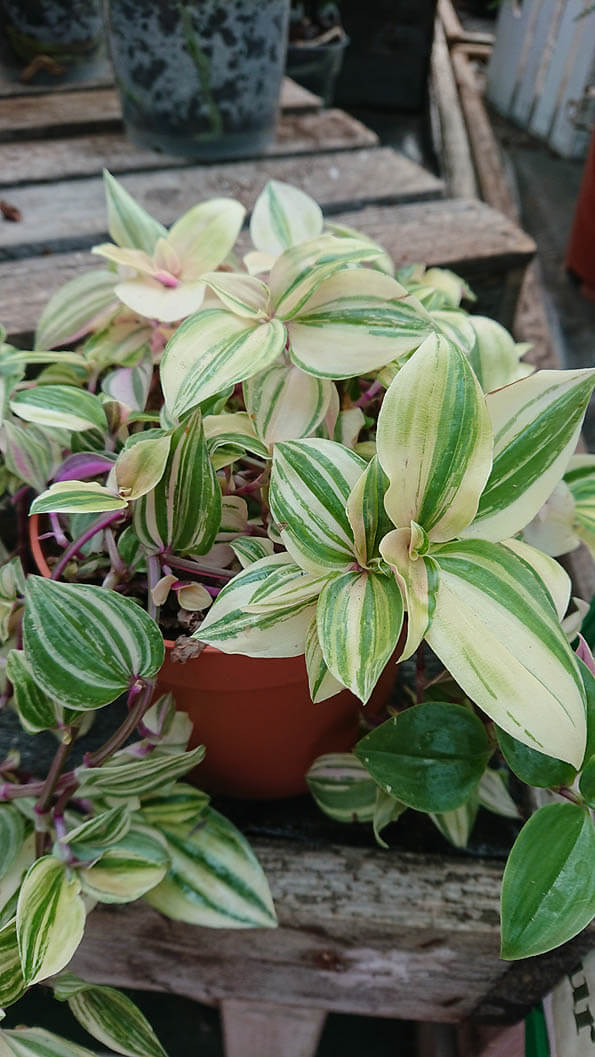
Variegated Tradescantia are becoming much easier to find
We should mention that the Wandering Jew Plant outdoors tends to become an invasive species if not properly maintained, as it's difficult to eradicate because if only an inch of it survives it will live on.
That said, our focus is on the indoor grower and so its potentially invasive nature outdoors isn't a problem. The Wandering Jew Plant is safe to have around cats and people, the sap in the leaves and stems, however, can be irritating so either wear gloves or wash your hands immediately if you come into contact with this.

Hi, I'm Tom!
If you're like me and enjoy the challenge of growing houseplants and getting them to thrive, then Ourhouseplants can help. This website shares my knowledge and years of growing plants and provides (hopefully) helpful advice on properly caring for your indoor plant friends.
Wandering Jew Plant Photos
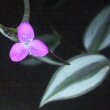
Wandering Jew Plant Care Guide
All Tradescantias including the Wandering Jew Plants need plenty of light to retain the variegated colours on the leaves, if things are too dim these will fade.
On the other side of the coin if too much light is provided leaf scorching is the end result, fortunately however the problem of " too much light " is basically only caused by excessively exposed locations during midsummer.
This is quite hard to provide indoors anyway, so you will only really risk this if you Summer your plants outdoors.
It's important they're placed in plenty of light but protected from very strong sun .
As you would expect from any easy houseplant, the Wandering Jew will cope with droughts and a little water logging from time to time.
Try to avoid this careless watering approach where possible though as a good looking plant needs to be watered correctly. The instruction here is simple, water your Tradescantia regularly and freely during the warmer seasons to try and keep the soil moist for much of the time.
In Winter cut right back because growth will slow or stop completely and the need for water will reduce drastically as a result.
The leaves are almost succulent like and therefore humidity is something you don't have to worry about a great deal. It will be worth misting the plant however if you start to notice the leaves becoming shriveled or brown leaf tips start to appear. You can also grow Tradescantia in an indoor bottle garden .
The opinion is often divided about how much and how often you should feed Wandering Jew Plants.
Some will suggest regular heavy feeding, perhaps as much as every other watering and others will say only once or twice a year at most, otherwise it will encourage the variegated leaves to turn green. The truth of it is that this plant will cope with almost anything you give (or don't give) it.
We fertilise normally (back of the bottle instructions) once a month and the OurHousePlant.com's Inch Plant is as good looking as the day it was brought.
Temperature
Give your plant average warmth conditions for quick growth, a cooler room of around 10°C (50°F) is also suitable too. In fact, the only no no, is exposure to frost or really chilly temperatures for prolonged periods. Frost will do serious damage and chilly locations will cause leaf discoloration.
It's best to repot once a year to give a little more space for the roots to grow, but as with everything else to do with this plant, it will still cope living in the same soil for years. This is handy if you've chosen to grow it in a hanging basket as these can be fiddly to upsize and can also be a little difficult to work with.
When you do repot though, normal potting soil is a great choice, just make sure you avoid mixes with a heavy manure content and don't use ordinary dirt from your yard.
Propagation
When it comes to propagation of Wandering Jews only the Spider Plant is easier and more reliable to work with. The success rate of Spider Plants is something like 99% and the Wandering Jew, 98%, so either way it's still incredibly easy to grow more plants.
You don't need a fancy heat mat or any special containers or tricks. You don't need to use any type of rooting hormone, and it's literally just a case of pushing the cutting a few centimeters into a fresh potting mix, water well and away you go. Trust us, once you know what you're doing it's so easy to do. Below is a break down of each step.
The stems of a mature plant are quite brittle so an accidental knock or an intentional snip on an existing plant will mean you have a Wandering Jew Plant stem cutting almost ready to go.
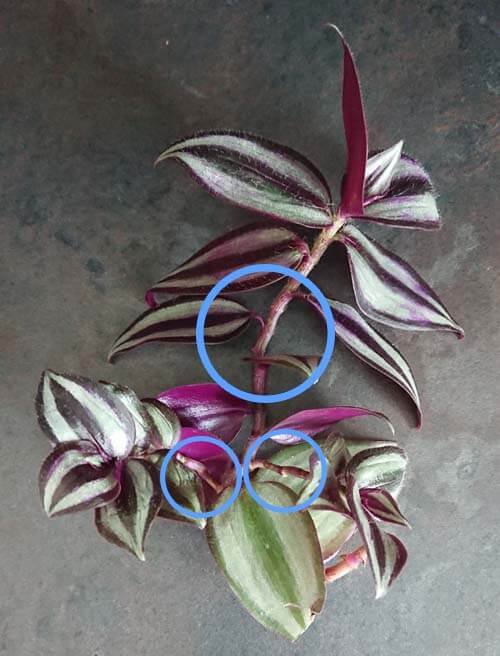
This broken stem can be used to create multiple plants
You don't need to wait for the fresh cut end to dry out so you could just push it into some soil (even in the existing pot where it was growing before if you're trying to recreate a bushy appearance).
But just replanting the large stem is potentially wasteful as there are several individual plants that can be created from a broken stem, like the one shown in the photo, this cutting could easily become three plants.
The photo above shows three sturdy stems with blue circles around them. Snip them off, making sure each is an inch long and has at least one leaf , although ideally for quicker results you will want a cutting that is several inches long and several leaves already in place.
Trim off any leaves on the lower part of the cuttings , because if any leaves touch the soil they will quickly rot, which could then cause the entire cutting to fail. Instead, remove the lower leaves and discard any unused material.
Below you can see the results of the above instructions - Three cuttings created from the original big one that are now ready to be planted up.
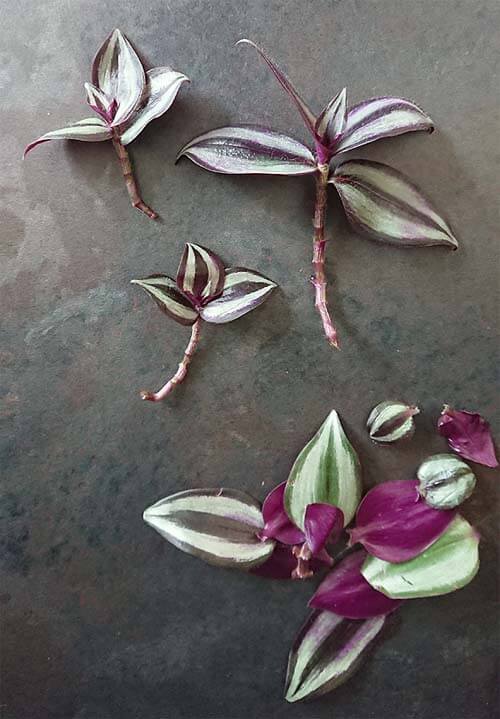
Several sections have been created and the lower leaves removed
Simply fill a container with potting soil or compost and wet it before inserting the stem ends into the soil. Make sure the cuttings are reasonably stable and fixed in place as they need good contact with the soil to stimulate root growth.
Pro Tip - Cuttings will take time to become bushy and to fill a pot by themselves, so because of the ease at which propagation can be done it's usually more effective to take several cuttings and put them all into the same pot.
You can use a rooting hormone, but we've found standard cuttings root with a very high probability anyway so don't bother.
Cuttings do much better if they don't touch each other and if they're planted towards the edges of the container rather than right in the center. Doing this will discourages rotting and the outer edges tend to be warmer than the very heart of the pot which gets the roots growing faster.
Once in place keep the soil moist (but not wet or soggy) and keep the plant warm. New growth should appear in just a few weeks. If you decided to grow several cuttings in a single pot and you notice any gaps later on, you can just push in new cuttings whenever needed to make it bushier.
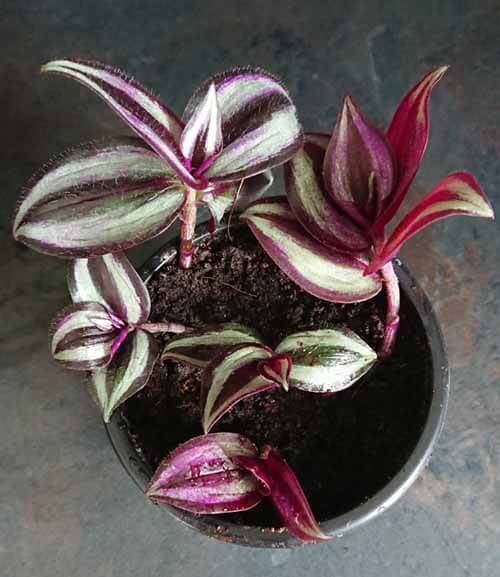
The cuttings planted up into a pot of compost
You can, of course, grow your individual cuttings in their own pots if that's what you'd prefer to do, but by putting several together like in the photo above it will mean after just a few months this pot will be completely covered with new growth.
All these cuttings will have knitted together nicely to give the illusion of one full plant when in fact it's actually several. This is something that would take almost a year or more if you're going for one stem cutting per pot.
Speed of Growth
The growth rate of Wandering Jew Plants when temperatures are warm is fast. As much as an inch a week in the growing seasons, if good light levels are provided and its watering needs are being met.
Its natural tendency is to "vine" and spread out, so if you aren't growing this in a hanging basket or you want to grow a neat compact looking plant then you must prune regularly to keep it tidy (don't forget the pruned stems can be used to propagate new plants).
Height / Spread
The height of this plant won't ever go beyond 6in / 15cm however every single stem can eventually grow to 6ft / 1.8M.
This type of spread might be what you're looking for of course i.e. if you want it to trail down from a hanging basket perched up high. However the stems can always be kept shorter by pinching out the growing tips on a frequent basis.
The Wandering Jew Plant is another houseplant that is grown for it's foliage rather than the flowers it produces, however they can still add a nice touch when they appear.
The pink or purplish flowers these plants produce will be small and can appear at any time of the year, although it's much more likely in late Spring early Summer.
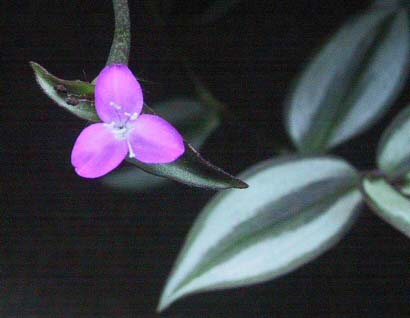
Inch Plant's aren't normally grown for their flowers, but they'll still bloom indoors sometimes
Are Tradescantia Plants Poisonous?
Generally speaking, Tradescantia is very mildly toxic to pets and people.
While it does little harm if eaten, the sap within the leaves and stems can cause contact dermatitis on the skin, especially in those with sensitive skin or those with an allergy . Wash your hands quickly after handling and you shouldn't have any issues.
Anything else?
Your plant is looking tired, it's become leggy and unattractive, convinced you have done something wrong you Google " Wandering Jew care instructions " to try and find out how to fix things. The answer you'll find will be pretty much the same everywhere because as any seasoned owner of this plant will tell you, this " look " is inevitable.
The vines grow long and quickly. Over time as they age the older leaves yellow and fall off creating the appearance you feel you've caused through poor treatment, which isn't usually the case.
Basically what's happened is that the plant has pushed and spread itself away from the pot it was growing in.
You can start again by taking cuttings and next time prune more frequently to encourage everything to keep closer, compact and neat.
Caring for Wandering Jew Plants Recap
Good Light Needed To keep the beautiful markings you need to provide good to bright light. Avoid direct sun exposure and low light conditions.
Average Watering Tolerant of a wide range of watering styles, it secretly wants to be well watered and for the soil to be moist for much of the time.
Average Temperature Provide temperatures at or above 18°C ( 65°F ) for best results.
Feeding Feed the soil once a month during Spring and Summer.
- No direct sunlight or low light positions
- Do not try and grow your plant in very cold places
Wandering Jew Plant Problems
Normally this is down to age, the oldest leaves will yellow and fall naturally. Although if this happens and you notice there are limp stems too then this is likely to be caused by quite prolonged and extreme underwatering.
Leaves changing to green / lost variegation
Although you can buy a green leaved variety of Wandering Jew, the majority are variegated and therefore if the leaves are changing colour this is obviously a problem.
The cause is almost certainly too little light. Overwatering can dull the colours but this doesn't make them go completely green. The cure therefore is to move the plant to a brighter area in your home.
Crispy brown and translucent leaves
Sometimes you'll find dead brown crispy leaves or some leaves going yellow or translucent, as shown in the photo below.
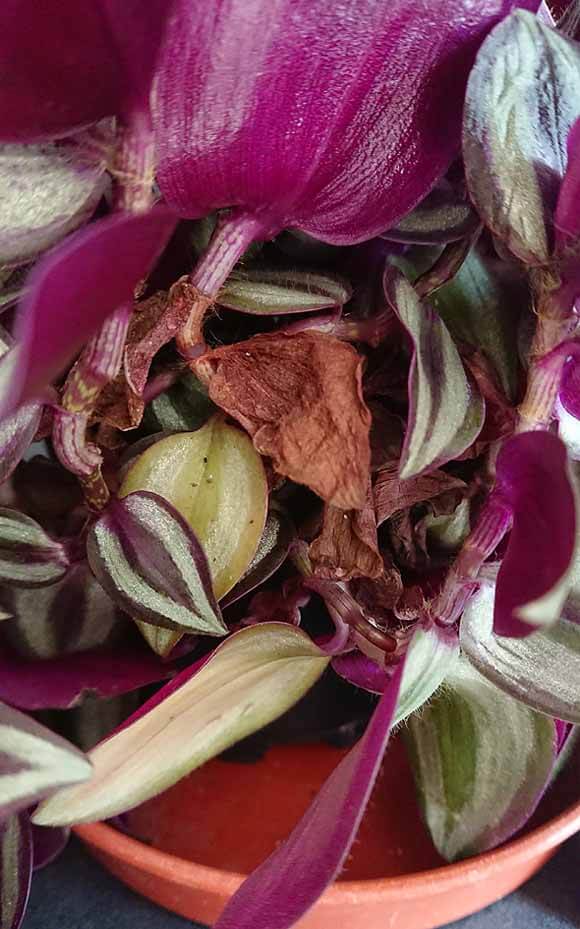
Tradescantia houseplant with unhappy leaves
This is going to be caused by one of the following (or in some cases a combination).
- Natural Ageing . Close to the heart of the plant tend to be the oldest leaves which are likely receiving very little light due to the shade from the canopy of the outer leaves. It's sensible for the plant to shed these leaves as they're not serving any propose. These leaves should pull off easily, so just remove them.
- Too much light . Excessive direct burning sunlight will quickly scorch and destroy the leaf. These plants want bright light but not full sun.
- Underwatering . Too little water can cause leaves to crisp and dry out. Make sure you're giving your plant ample water during the growing months.
Wandering Jew Plants love water when growing strong, but as with the majority of indoor plants too much watering will eventually rot the stems. Keep the soil moist not water logged.
Bare spindly and / or leggy growth
This is typically the issue discussed in the " anything else " section above, i.e. this appearance is usual after the plant is quite old. It may also be caused however by too little light (the variegation will have faded also), too little water on a regular basis (accompanied with yellowing leaves), or not enough fertilizer .
Wandering Jew Plant leaf tips are brown and shriveled
Although quite unusual in most homes this is caused by placement in a room with very low humidity, i.e. the air is too dry. You might also be trying to grow your plant next to a heat source like a fire or heater.
Either move the plant somewhere else or follow some of our tips to increase humidity in the home. You should resolve this quickly as your Wandering Jew Plant will also be easy prey for Red Spider Mite infestation.
About the Author

Over the last 20 years, Tom has successfully owned hundreds of houseplants and is always happy to share knowledge and lend his horticulture skills to those in need. He is the main content writer for the Ourhouseplants Team .
Also on Ourhouseplants.com
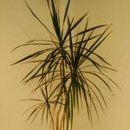
(Article / Gallery) Photo credit of the Wandering Jew T. fluminensi to LucaLuca (Article / Gallery) Photo credit of the Wandering Jew flower to Ruestz
About Ourhouseplants.com
Our website is for anyone looking for success with indoor gardening.
With care guides and information about all popular indoor plants, we're here to help get your houseplants thriving. From the beginner to the more experienced, there's something for everyone.
As a Team, we've almost 50 years of hands-on experience and various horticulture skills. So let us help you to grow your knowledge and become a houseplant expert.
Six Reasons You Can Trust Us
- Recent Updates
- Privacy Policy
- © OurHouseplants.com - 2013 - 2024
Growing Wandering Jew Plants – How To Care For Spiderwort Plants
Updated on November 17, 2020
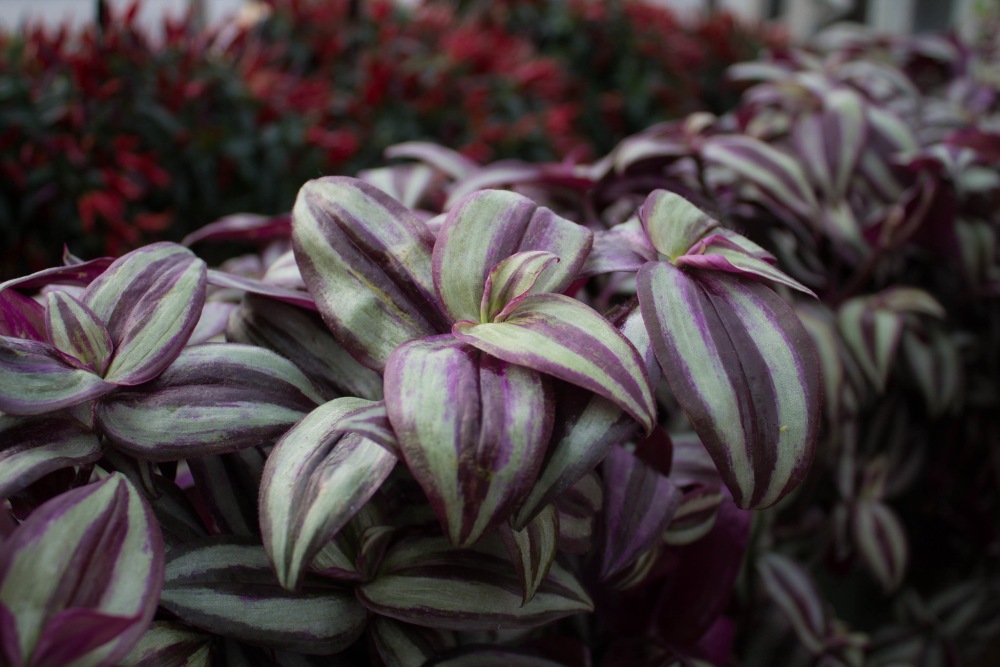
Many horticulturalists claim that the wandering Jew plants are the perfect houseplants no matter where you live or how little skill you have with plants. There are many facts to support this claim even if it sounds outlandish and we’ll go through in detail. But the question here is which wandering Jew plants to grow? This umbrella name refers to a wide variety of plants in the Tradescantia family. Each one of them has some value to add to your home. From brighter blooms to more colorful foliage. But all these varieties of the wandering Jew plants share one thing in common and that is they are easy to grow and care for.

Reasons to Consider Wandering Jew Plants in your Home
So let’s dissect this claim that the wandering Jew plants are perfect for all homes. We have covered many plants that were easy to grow and didn’t need much attention. What makes the wandering Jew plant so special? Well, there are a few reasons for that.
- These plants are natural air purifiers . The wandering Jew plants absorb carbon dioxide and toxic particles out of the air leave your house smelling fresh and healthy.
- In the realm of houseplants, this species likes to get attention with their showy foliage .
- They also absorb heavy metals out of the soil.
- The wandering Jew plants are known to self-propagate. They practically ask for no input from you when they reproduce and make new plants.
- They are hardy plants that can handle drought, fluctuating lighting, poor soil, and many other adverse conditions.
- Even if they happen to die on your watch, you can still start a brand new plant just with a leaf node from the old one.
- They thrive in small pots or hanging from baskets where they make a real colorful splash with these delicate tendrils.
- Finally, there are many varieties to choose from and they are easy to find in your local nursery.
Wandering Jew Plants Basics
Native to South America, the wandering Jew plants (Tradescantia) are perennial evergreens that combine three types of plants under this common name. They’re sometimes called spiderwort, purple queen, and inch plant depending on whom you ask. But the fact that they’re tropical plants doesn’t mean you can’t grow them in your home. That’s the beauty of houseplants. You have control over the temperature and humidity levels allowing you to grow such exotic plants as these.
The one thing you need to keep in mind is that the wandering Jew plants are considered invasive species in many places. This is why you can’t grow them in your garden. Remember what we said about their self-propagation? Once they establish roots in an area, they spread out and claim new territories all the time. In a garden, this means they will soon take over and smother other plants in the garden before they jump over the fence and reclaim the neighbor’s garden as well.
Some of the species are flowering plants while others rarely bloom indoors. But even those that don’t flower, they still have dazzling foliage that renders the flowers redundant. Some varieties have striped green leaves with silver streaks that are a delight to look at.
Wandering Jew Plants Varieties
So which variety of the wandering Jew plants should you grow? The answer to that depends largely on your personal taste and preferences. So let’s take a closer look at each variety of this exotic family.
- Tradescantia Zebrina: One of the most popular varieties whose leaves compete for your attention with its awesome blooms. In general, the leaves are usually heavily patterned while the three-petal flowers are white. But the contrast is often breathtaking. The center of the leaves is striped in creamy patterns just like a zebra, hence the name. The rim of the leaves is usually silver that contrasts the blocks of dark green color.
- Tradescantia Fluminensis: This evergreen originates from Brazil and flowers throughout the year. With proper care and attention, it will stay with you for many years. The leaves are usually oval in shape and have a distinct glossy green look. At the end of each leaf is a node that grows out of a fleshy stem and develops into a root. If you don’t prune the plant regularly, it will spread out and claim every inch of space available. It has USDA hardiness zones between 9 and 12 and favors warm climates and plenty of sunlight.
- Tradescantia Pallida: A showy variety that hails from Mexico. Its leaves are the source of its pride. Each leaf is about 7 inches long and when it matures, it turns purple with red or green tips. The small flowers bloom in various colors from pink to white and lavender. Unlike other varieties, the pallida plant doesn’t grow tendrils, rather its fragile stems break easily and grow into new plants on their own. It doesn’t tolerate cold temperatures well especially if the temperature drops below 50 degrees Fahrenheit.
How to Grow Wandering Jew Plants
As with exotic or tropical plants, you need to recreate conditions similar to the plant’s original habitat. This ensures the wandering Jew plants will keep growing and flowering year after year in your house. The good news is, these evergreens are easy to grow. As we have seen, they even self-propagate. Here are the easy steps to grow the wandering Jew plants.
- The easiest way to grow any species of the wandering Jew plants is through a cutting.
- Use a clean and sterilized knife to cut a healthy stem of a mature plant.
- Remove any dried or crispy leaves and only keep one set of leaves near the top of the stem.
- Put the stem in a glass full of water and keep it in a lit spot without being exposed to direct sunlight.
- After about a week the stem will grow roots. It might take longer than a week if the room is too cold.
- When the roots are about 2 inches long, it’s time to pot the plant.
- Fill a medium-size pot with a general-purpose potting mix . You can add peat moss, worm castings , or oak bark. However, make sure not to include peat.
- Make a hole about 4 inches deep and two and a half inches wide. Place the seedling in it and cover the hole with soil.
- Water the pot well until the water flows out of the drainage holes at the bottom.
- Keep the soil moist for the next couple of weeks to help the roots grow and establish.
Wandering Jew Plants Care
And that’s all you need to do to grow the wandering Jew plant. It’s that easy. But now, of course, comes the hard part. How to keep it growing and at the same time manage that amazing fast growth rate.
Most houseplants need well-drained soil. The wandering Jew plant thrives in loamy or sandy soil while it struggles in clay or alkaline soil. If you’re not sure that the soil drains well, add one-third portion of perlite and mix well. Many experts recommend you add a layer of gravel at the bottom of the pot to improve drainage.
Sunlight is important for the success of the wandering Jew plant. In fact, those bright three-petal flowers will not bloom without sunlight. In that respect, this perennial makes a distinction between morning sun and afternoon sun. It prefers the afternoon sun so always keep it on a window sill that faces the south or west. North and east-facing windows get the morning sun. The leaves of the plant will tell you if it’s not getting enough sun. Their color will fade and they turn yellowish. If the sun-deprivation continues, the plant might die.
Moisture is the operative word when it comes to watering. You wouldn’t want the soil to get wet but if you let it dry out, that will hurt the wandering Jew plant too. So it’s more of a balancing act. You wait for the top 3 inches of the soil to go dry before you water it. When you irrigate it, you don’t soak the soil. The roots are sensitive to water and don’t function well in waterlogged soil. This could lead to root rot, drooping leaves, and wilting stems.
Many horticulturalists recommend that you use worm castings as a slow-release fertilizer that feeds the wandering Jew plant slowly for weeks at a time. As an alternative, you can apply general-purpose liquid fertilizer at half strength. This means you should dilute it by adding about 50 percent water or using half the recommended dose. The best times to apply fertilizer are in the growing season. If you notice the tips of the leaves turning brown or looking dry, that could be the result of using strong fertilizer.
That’s where it gets serious. The wandering Jew plants are known for their fast growth rates. If left alone, they’ll grow all over the place and project a messy look. Not to mention that the plant becomes leggy. That’s when it focuses on growing long stems while leaving the base bare and ugly. Use your pruning scissors regularly to trim new shoots and keep the foliage dense and in good shape. Pinch the tip of the new shoots to encourage the plant to grow bushy.
Pests and Diseases
You need to watch out for spider mites. These little bugs feed on the leaves and flowers of the wandering Jew plant. You’ll notice small webs between the leaves, that’s a dead giveaway that you have a pest problem. Use neem oil to clean the stems and remove the webs. You could also dip a swap in alcohol and gently rub it over the leaves and stems to kill the pests.
As for diseases, the only two common ones are root rot and brown leaf tip. The first is the result of overwatering or poor-drainage soil. The second is caused by sun deprivation. Move your pot to a window that gets the afternoon sun to give the leaves their healthy and glossy look.
Your daily dose of crafts, recipes, beauty, fashion, living tips and home guides.
Leave a Reply Cancel reply
Your email address will not be published. Required fields are marked *
- Air Conditioning
- Easter Eggs
- Tablescapes
- Pillows & Throws
- Doors & Windows
- Raised Garden Beds
- Centerpieces
- Party Decor
In-depth Guides
Product reviews.
- Rooms & Spaces
Living Room
- Fireplaces & Mantels
- Walkways & Paths
- Pools & Ponds
- Kitchen & Dining
- Laundry Room
- Home Office
- Windows & Doors
- Floors & Ceilings
- Ask DIY Question
- + Post Project
- + Post a new Project
- Saved Projects
- Notifications
- Account Settings
- Support • Privacy
- DIY Projects
- Pest Repeller
How on earth do you kill wandering Jew?

You mean wandering Jew, right? Go to the nursery and get the strongest herbicide that they have.
I know people who use Roundup and add a cup of Diesel fuel to the mix. It kills very stubborn poison oak. Don't use it in fire season though. And think of the environmental impact too.
Use vinegar. Easy fast and quick.
- See 2 previous
Great I use vinegar for cleaning, I will definitely try it to kill it
Does it stay gone with the vinager
should I use white or cider vinager
Plain old white vinegar. I buy at Costco, Sam's Club or any restaurant supply for $2 a gallon. White vinegar and apple cider vinegar are 5% acidity. Cleaning vinegar is 6% acidity, agricultural vinegar varies between 10% - 30% acidity. It is the acid that kills the plants.
If you want to plant something else there, don't use Roundup! Try vinegar, then dig up the roots after the top dies. Big job, unfortunately.
Vinegar and Dawn soap, salt, Weed Dragon to burn it
What’s weed dragon
Related Discussions
Gnats - how to get rid of them.
Somehow my house and garden got tiny gnats that killed my fuchsia plant and fly everywhere. I have tried ALL the Web recommendations - soap and oil dishes, sand in th... See more
Marigolds growing! Should I pinch the buds?
My marigold plants are growing. I heard that pinching the buds until Autumn will allow them to grow without killing the plant. Is this true?

Growing garlic
Growing our first garlic, should we wait until the leaves are drying out before we pick it? Husband picked first one today along with our first potatoes.

How to keep mice out of your garden?
Hi everyone, I have mice in my garden destroying my vegetables and I have also noticed them in the barn and shed. Please can someone tell me how to prevent them from ... See more
What's the best flower/plant to grow in Texas?
I know that opinions vary, but what's your opinion?!I have great luck w Rosemary plants. Green all year long.
Can someone tell me what kind of animal this was in my yard?
I thought maybe a rabbit was burrowing in my yard, but it's almost dead center of my lawn (not a very smart rabbit). The hole is not very deep, and I replanted it onc... See more
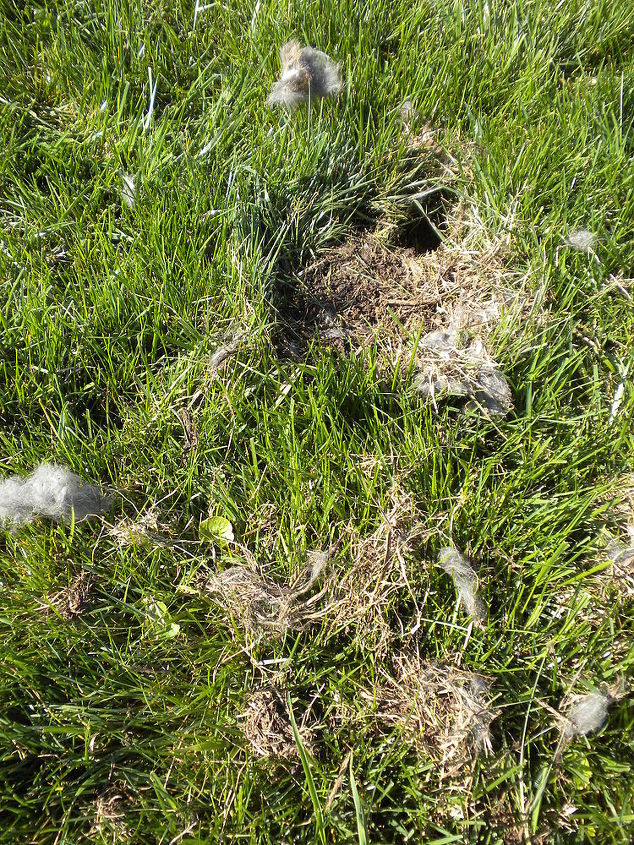
Is Creeping Charlie in your lawn a good thing or a bad thing?
Is there a sure-fire way to get rid of Creeping Charley?

Suggested Project Book

Get The Vogue Closet Of Your Dreams With These 15 Inspirations
- Growing Houseplants
- Indoor Garden Ideas
- Cactus & Succulents
- Houseplants Care
- Flowers & Blooms
- Gardening Guide
- Plant Care and Tips
- Beans/Fruit Vegetables
- Companion Planting
- Culinary Herbs
- Flowering Herbs
- Garden Design
- Gardening Ideas
- Growing food
- Growing Trees and Shrubs
- Leafy Vegetables
- Medicinal Herbs
- Patio Gardening
- Root Vegetables
- Shade Plants
- Temperate Fruits
- Tropical Fruits
- Balcony Gardening
- Container Fruits
- Container Gardening Ideas
- Container Herbs
- Container Vegetables
- Rooftop/Terrace Gardening
- Urban Gardening
- Vertical Gardening
- More Than Gardening
- Best and Top of Gardening

- Container Gardening
- Indoor Gardening
32 Different Ways to Grow Wandering Dude Indoors

2-Minute Read
Here are 32 different ways to grow wandering jew indoors to enhance the beauty of its colorful foliage. try one of these soon.
We’ve got many Different Ways to Grow Wandering Dude Indoors so you can enjoy their variegated leaves of purples, greens, silvers, and pinks in any corner of your home.
Propagating Wandering Jew in Water | Growing Tradescantia Plant in Water
Different ways to grow tradescantia indoors, 1. keep it on plant stands.
Opt for a plant stand where you can keep the plant in a pot to make it like a colorful and small room centerpiece.
2. Try DIY Planters
Use DIY planters to give the plant a more personalized appearance.
3. Do Not Miss Basket Planters
A woven basket can lend a rustic appeal to your plant’s setting.
Learn everything about caring for the Wandering Jew plant here
4. try self-watering pots.
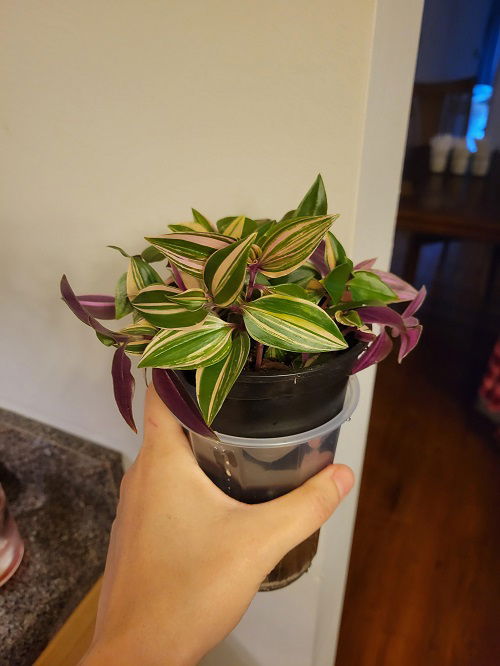
Maintain optimal moisture levels effortlessly with self-watering pots.
5. Use Stubby Planters
Use a stubby planter for a minimalist look and showcase it anywhere you like.
6. Go For Macramé Hangers
Macramé hangers allow the vines to drape elegantly, providing a boho-chic feel.
7. Hang the Plant from the Ceiling
Secure ceiling hooks to dangle the plant pots at various heights.
Check out the best wandering jew varieties here
8. hang the plant near a window.
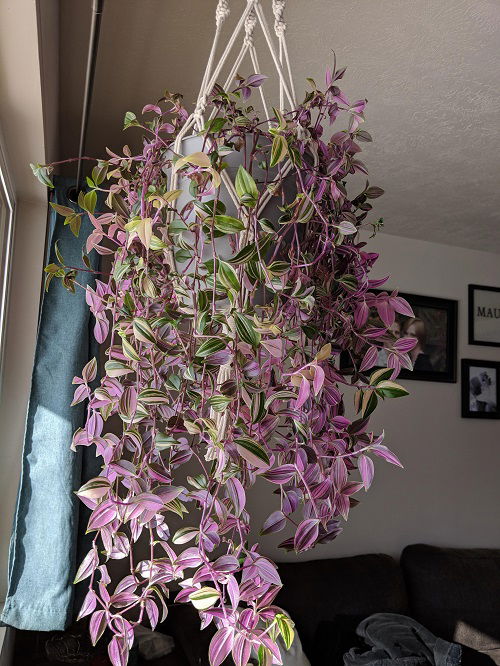
Utilize window mounts to let the plant receive maximum sunlight.
9. Go For Tiered Hanging Pots
Multiple-tier baskets allow you to hang more than one plant, creating a lush appearance.
10. Hang the Pot on a Hook
Hang the plant over doors using special hooks for an unexpected display.
11. Keep it On Floating Shelves
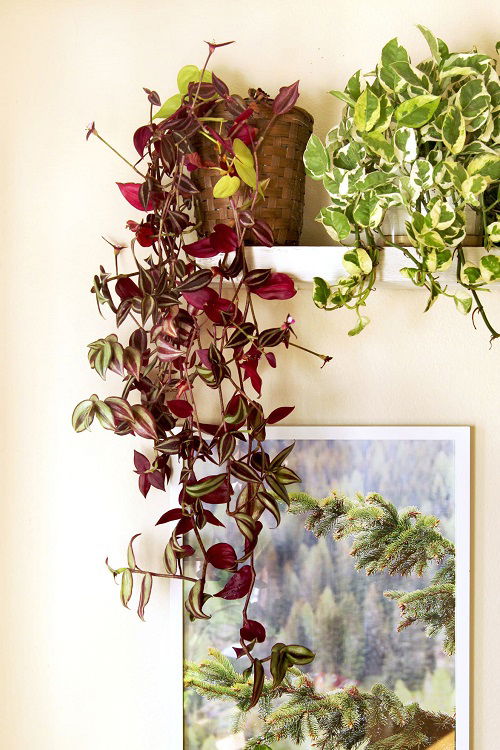
Place the plant on floating shelves along the wall, allowing the vines to trail down.
Wandering Jew Care | How to Grow an Inch Plant Indoors
12. keep its pot on a bookshelf.

Integrate the plant into a bookshelf for a burst of natural color among your books.
13. As a Coffee Table Centerpiece
Make the plant as centerpiece of your coffee table for a vibrant focus point.
14. Keep it Near a Table on a Tall Stool
Set the plant on a tall stool near a side table next to your sofa or bed for easy admiration.
15. Hang it on a Shower
Brighten up your bathroom by placing the plant on the shower or keep it in a corner.
16. Display it in Quirky Containers
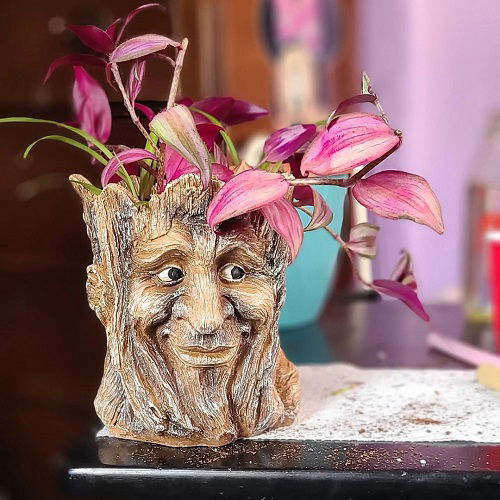
Use face containers or any other quirky pot of your choice to make the plant stand out!
Is Wandering Jew Toxic to Cats & Dogs? Find Out !
17. keep the plant on a tall chair and let it ‘flow’ down.
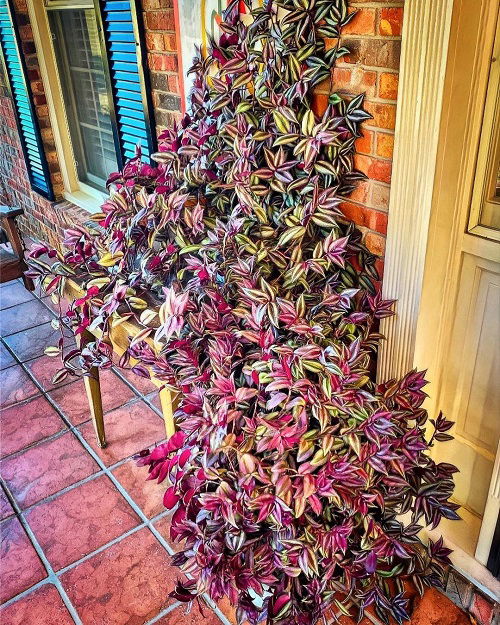
A tall chair in the living room or in patio is a super cool way to showcase its dangling stems and foliage!
18. Grow it in a Window Box
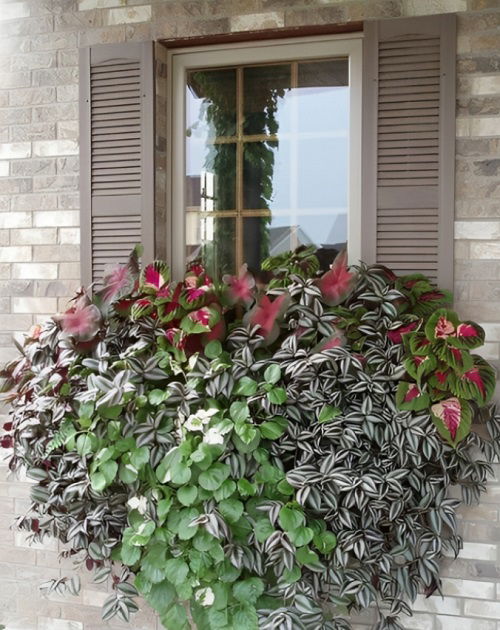
The colorful and trailing leaves of the plant will add to curb appeal of the home when you grow it in a window box .
19. Grow it in Water
A clear vase filled with water will make the pretty foliage of this plant take center stage. We have a great article on it here .
20. Hydroponic Jar
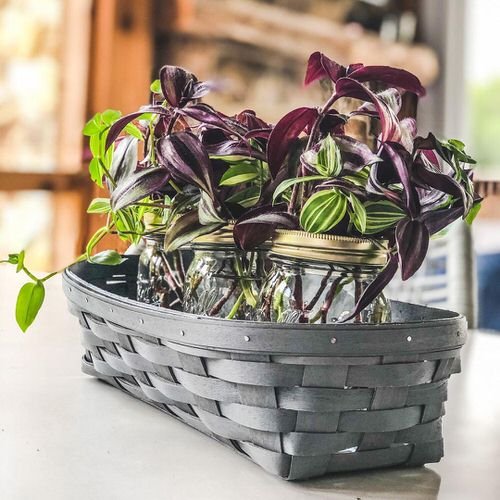
You can easily find hydroponic jars online; if you don’t, do make one yourself .
21. Test Tubes
You can also grow individual Wandering Jew cuttings in test tubes.
22. DIY Mannequin Planter
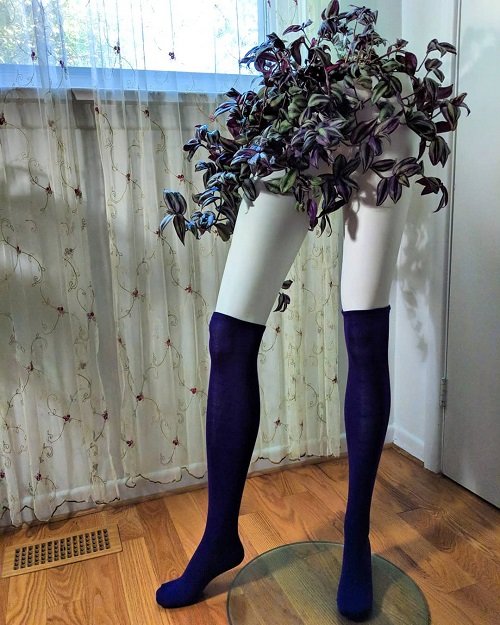
The idea isn’t to copy this one but to find a quirky thing in your home and upcycle it.
23. Hang Them Outside

The bright light will surely make the colors pop. What you’re seeing is Tradescantia Nanouk and Tradescantia Zebrina.
24. Make a Natural Curtain
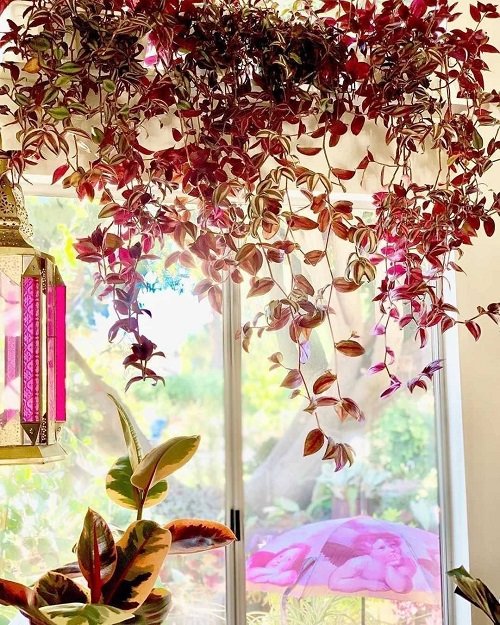
What better way to adorn the windows than this natural plant curtain? We found the idea here .
25. Mini Wandering Jew Tree
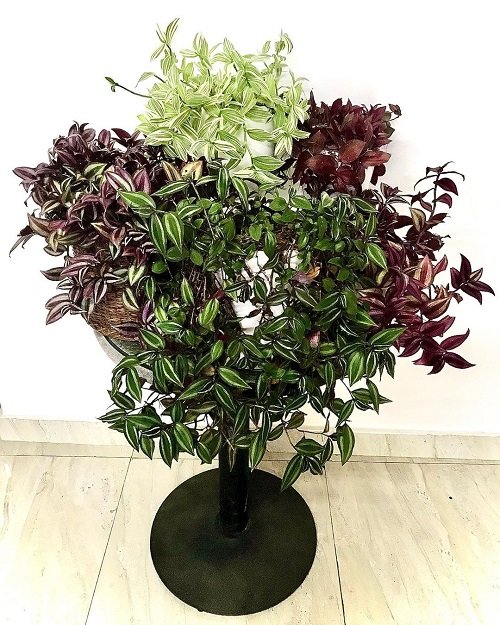
Get a plant stand and pair up different wandering jew varieties for a colorful tree display.
26. Hang it on the Window

If your plant has grown a bit, you can hang it near a window. A northeast window would be perfect.
27. Create a Colorful Shelf Display
The vines trailing down and reaching the ceiling at the same time will create a stunning display.
28. A Cutting Trio
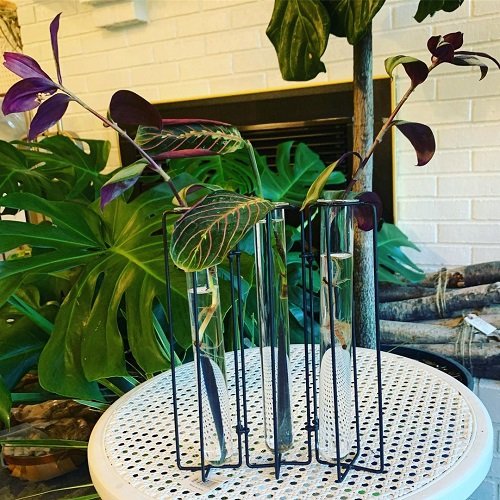
Test tubes are great at another thing – growing wandering jew cuttings.
29. Grow it in a Railing Hanger
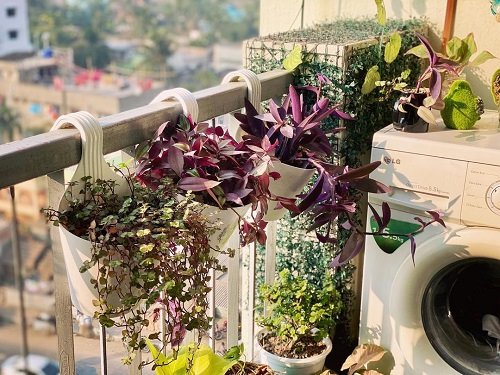
What a great idea to save space! Don’t forget to pair it up. What you’re seeing is Turtle Vine , Wandering Jew, and Purple Heart .
30. Keep it on the Top Shelf
Keep the pot on the top shelf. In time, it will create a dense, trailing display.
31. Root it in a Test Tube
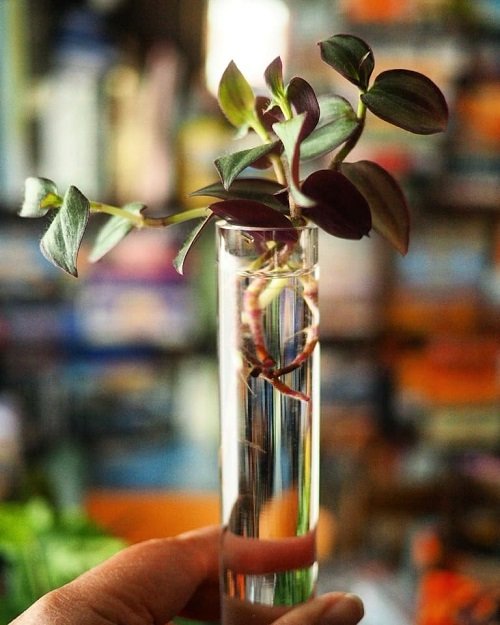
Test tubes are great for rooting these plants and help keep track of growth.
32. Near a South Facing Window
SaltMill grew this one in a wide planter near a south-facing window , and here’s the result.
Recent Posts
Where do gnats come from | getting rid of gnats, costus barbatus care and growing information, 20 best mini cucumber varieties | small cucumbers, how to grow giant strawberries | big strawberry, 17 fast growing flowering vines, 11 herbs with yellow flowers, 22 flower names that start with c, 23 california native shade plants, join our 3 million followers:, related articles, pothos vs philodendron | difference between pothos and philodendron, monstera lechleriana care and growing guide, how to grow night blooming jasmine indoors: the most fragrant flower, how to grow cilantro indoors easily, how to propagate an elephant ear plant: 4 best ways, how to grow dischidia nummularia easily, leave a reply cancel reply.
Save my name, email, and website in this browser for the next time I comment.

Get the Best of BalconyGardenWeb Directly in your inbox.
POPULAR CATEGORY
- Best and Top of Gardening 1588
- Flowers & Blooms 638
- Growing Houseplants 601
- Gardening Guide 413
- Gardening Ideas 382
© 2023 Balcony Garden Web | All rights reserved
- Privacy Policy
- Terms of Service
- Feedback Page

IMAGES
VIDEO
COMMENTS
The wandering jew is famous for the speed at which it produces dead leaves! Therefore, if you're picky about plant neatness, you'll need to go over your plant and remove the dead leaves every week or so. After cleanup, a wandering jew (here, Tradescantia zebrina) is quite presentable again. Of course, as the oldest leaves are mostly in the ...
Here are some common reasons why a Wandering Jew plant may be wilting and potential solutions: Underwatering: If the plant is not receiving enough water, it can lead to wilting. Check the moisture level of the soil by inserting your finger into the top inch of soil. If it feels dry, it's time to water.
Wandering jew leaf turning brown. 2. Under Watering. Lack of adequate soil moisture is another very common cause, and often a struggle for many types of Tradescantia plants. When the soil is allowed to dry out too frequently, or remains that way for a long period of time, it can cause the leaves to die. 3.
This plant requires well-drained potting soil and doesn't like soggy soil. Mix pumice or perlite to help the drainage. Pumice and perlite also help the plant's vigor and growth. Water Wandering Jew once the top of the soil looks dry. Water the plant enough that it comes out of the drainage holes.
Fill a 6-inch to 1-gallon container that drains with a rich, well-drained potting mix. Water the soil to settle it. Make about a 2-inch indentation in the soil where you want to place the Wandering Jew cutting. Remove the bottom leaves from the cutting where you will be inserting it into the soil.
3. Pot your Wandering Jew plant. Fill the pot about two-thirds of the way with light, well-draining potting soil, then place the plant in the center of the pot. Add soil to surround and fill in the sides. Gently press down on the soil around your plant and water it until the soil is completely moistened.
An inch or two with a few leaves works best. Remove the leaves at the bottom so part of the stem is exposed. Place the cutting in a glass of water to root or plant it directly in soil. You can put cuttings back in the mother plant's pot to give her a fuller appearance on top.
Water about once every 5-7 days in spring and summer. Keep the soil slightly humid. Do not let the Wandering Jew dry out between waterings. Use your index finger to check if the soil is dry down 1-2 inches of soil (2.5 - 5 cm). Reduce watering to every 10-14 days in autumn and winter.
Wandering Jew plants should be watered regularly to maintain a balanced moisture level in the soil. However, the soil should not be allowed to become too dry or too wet. Overwatering can lead to root rot. A good way to check if it's time to water is to push your finger about 1-inch into the soil.
Make it an addition to your regular Wandering Jew care routine. Trim off long tendrils, dead leaves, and weak growth. Pinch off new growth and thin it out. This helps create a bushy appearance and transforms the plant into something suitable for your indoor efforts. Sometimes, per their name, Zebrina goes a-wandering.
Wandering jew plants are super easy to propagate. Take cuttings that are 3-4″ long, and include a couple of leaf nodes. Dip the cut ends into rooting hormone, then stick them in moist soil. Don't allow the soil to dry out, and keep the air around the cuttings humid. A propagation chamber makes this simple.
Here are a few steps you can try to save a wilted Wandering Jew plant that has been left in cold weather: Bring the plant indoors: If the plant is still outside, bring it indoors and place it in a warm, well-lit location. Check the soil moisture: If the soil is dry, water the plant thoroughly. Be sure to allow the excess water to drain away, as ...
The thick green leaves have a fuzzy texture and a purple hue on the underside. You can easily propagate it from the cuttings, both in soil and water, once it gets growing. It bears delightful clusters of blue, purple, white, or rose pink flowers, making it one of the best types of wandering jew plants on the list. 5. Tradescantia Sillamontana.
Adding some perlite or pumice to improve drainage will help. Avoid using sand because sand will fill up the minute spaces in the soil and prevent drainage. Water your plant when the top of the soil appears dry. Water it enough so that water comes out of the drainage hole. Immediately empty the saucer.
Like all plants, the Tradescantia Tricolor has a difficult Latin Name. This one is Tradescantia fluminensis. It is also known by other names including the Wandering Jew, Flowering Inch Plant, Wandering Willie, Wandering Gypsy, Purple Queen, Spiderwort, and Tradescantia. What's more, Tradescantia is a genus of 75 species of wildflowers.
Tradescantia fluminensis is a perennial groundcover that spreads along the ground with soft, hairless stems and leaves. The fleshy stems root at any node that is on the surface. The plant has oval, dark-green leaves with pointed tips that are shiny, smooth and slightly fleshy about 1.25-2.5 inches (32-64 mm) long.
The wandering dude is a novice plant parent's dream: It's an easy to grow plant, has beautiful silver, green and magenta foliage, and drapes beautifully from pots.Wandering dude (Tradescantia zebrina) also is super-simple to propagate so you can make more baby plants (for free!).With its long dangling stems, this plant tends to "wander" all over the place.
The Wandering Jew is a legend that basically follows that a Jewish man was cursed to walk the earth forever, therefore like this plant the Jew will, in time, eventually go everywhere. A number of visitors have contacted us to say the use of this common name today could be misconstrued or even upset Jewish people.
Use a clean and sterilized knife to cut a healthy stem of a mature plant. Remove any dried or crispy leaves and only keep one set of leaves near the top of the stem. Put the stem in a glass full of water and keep it in a lit spot without being exposed to direct sunlight. After about a week the stem will grow roots.
White vinegar and apple cider vinegar are 5% acidity. Cleaning vinegar is 6% acidity, agricultural vinegar varies between 10% - 30% acidity. It is the acid that kills the plants. Cindy Ptak on Jun 04, 2017. If you want to plant something else there, don't use Roundup! Try vinegar, then dig up the roots after the top dies.
Different Ways to Grow Tradescantia Indoors. 1. Keep it On Plant Stands. Opt for a plant stand where you can keep the plant in a pot to make it like a colorful and small room centerpiece. 2. Try DIY Planters. Use DIY planters to give the plant a more personalized appearance. 3. Do Not Miss Basket Planters.
Step 2: Trim weak or thin areas - Next, remove any thin, weak, or leggy sections of your wandering dude plant down to a lower leaf segment. You can either pinch them back with your fingers, or cut them using clean, sharp shears or snips. Cut back wandering jew just above a leaf joint.
Liz Hughes, the co-owner of Groovy Plants Ranch in Marengo, Ohio, switched T. zebrina's name from wandering Jew to wandering dude around 2019 after hearing about the renaming movement ...